VTech Telecommunications 80-6887-00 1.9GHz CORDLESS PHONE User Manual Synapse Jr SB67118 Feb 23 Part 1
VTech Telecommunications Ltd 1.9GHz CORDLESS PHONE Synapse Jr SB67118 Feb 23 Part 1
Contents
- 1. Users Manual 1
- 2. Users Manual 2
- 3. Users Manual 3
Users Manual 2
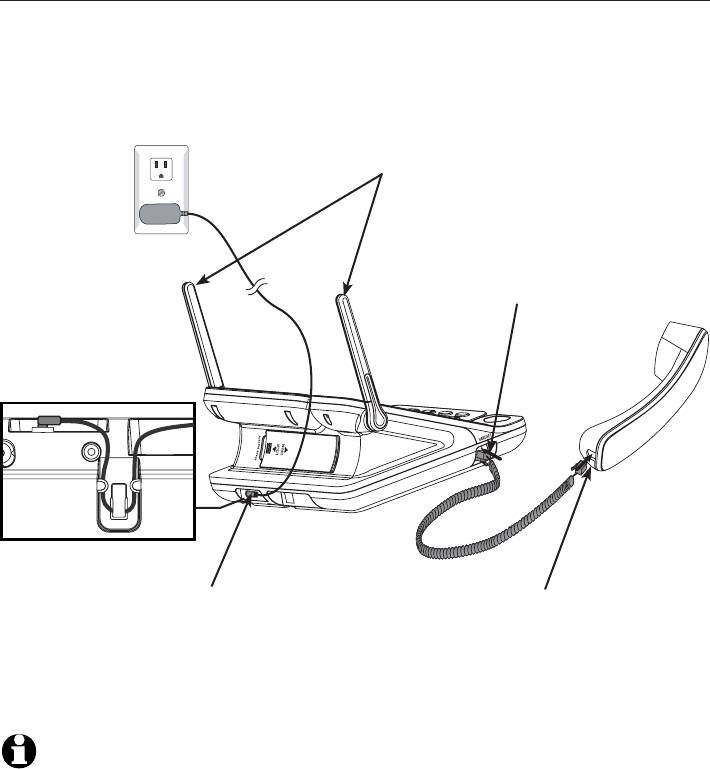
Getting started
Telephone base installation
IMPORTANT INFORMATION
Use only the power adapter supplied with this product. To order a replacement power adapter,
visit our website at www.telephones.att.com,or call
1 (800) 222-3111.In Canada dial 1 (866) 288-4268.
The power adapter is intended to be correctly oriented in a vertical or floor mount position.
The prongs are not designed to hold the plug in place if it is plugged into a ceiling, under-the-
table or cabinet outlet.
1.
2.
To connect the corded handset and power adaptor to the telephone base
Plug the other end of the
coiled cord into the corded
handset.
Plug one end of the coiled
cord into the HANDSET
jack on the left side of the
telephone.
Plug the small end of the power adapter
into the power jack at the bottom of the
telephone base. Route the power adapter
cord through the slot on the bottom of
the telephone.
Plug the large end of the
power adapter into a power
outlet not controlled by a
wall switch.
NOTE: For complete instruction on installing the cordless handset, please refer to the manual
provided with your AT&T SB67118/67108 product, or visit
www.telephones.att.com to download the manual.
6
Raise the two antennas for
optimum wireless range and
performance.
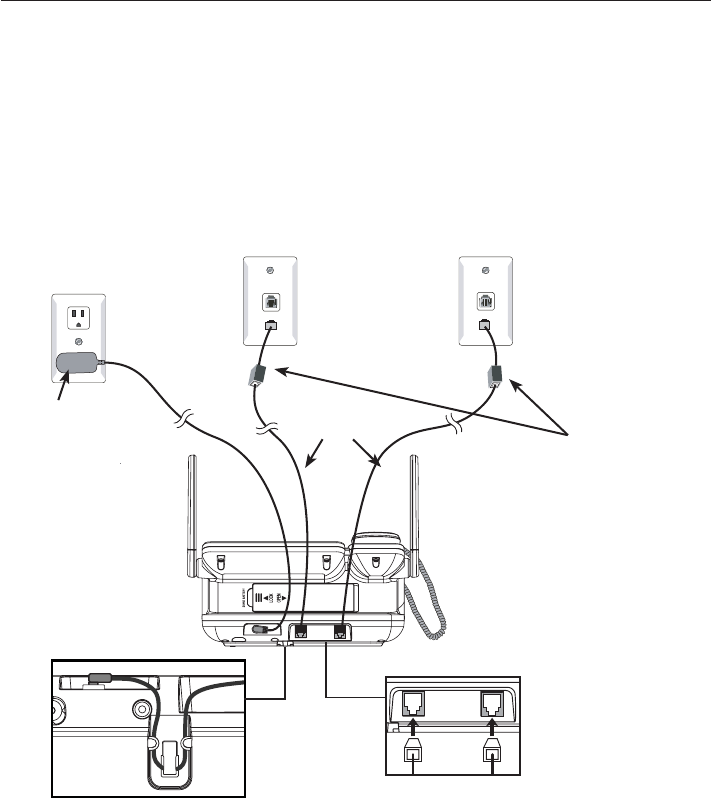
L3/L4 L1/L2
If you subscribe to high-speed Internet service (digital subscriber line - DSL)
through your telephone lines, you must install a DSL filter between the
telephone base and the telephone wall jack. The filter will prevent noise
and caller ID problems caused by DSL interference. Please contact your DSL
service provider for more information about DSL filters.
Install the telephone line cords as shown below.
Getting started
Telephone base installation
To connect the telephone line cords to the telephone base
Option 1: To connect two 2-line wall jacks
Line 2 + Line 1
Line 3 + Line 4
Electrical outlet not
controlled by a wall
switch
Power adapter Telephone
line cords If you have DSL
high speed Internet
service, a DSL filter
(not included) is
required on each
DSL line.
7
L3/L4 L1/L2
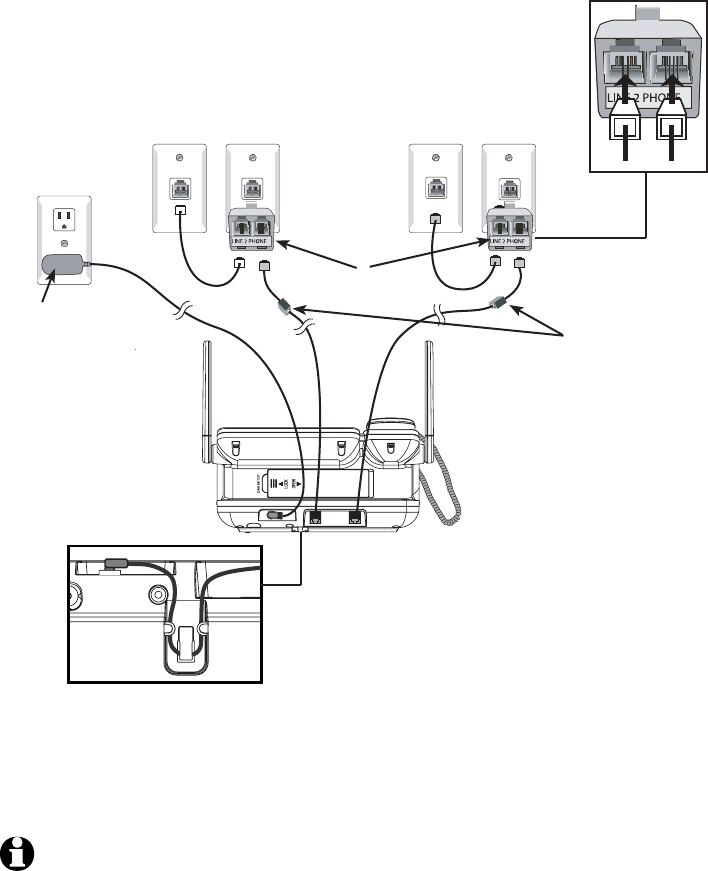
L3/L4 L1/L2
Getting started
Telephone base installation
Option 2: To connect four one-line wall jacks
NOTES:
1. If you have three one-line wall jacks, you need a two-line splitter for two of the lines.
2. The long cords supplied with the phone are four-conductor cords.
3. To order a two-line adapter, visit our website at www.telephones.att.com, or call
1 (800) 222-3111. In Canada dial 1 (866) 288-4268.
Line 1
Line 2
Line 3
Line 4
Electrical outlet
not controlled
by a wall
switch
Power adapter
Two-line adapter
8
If you have DSL
high speed Internet
service, a DSL filter
(not included) is
required on each
DSL line.
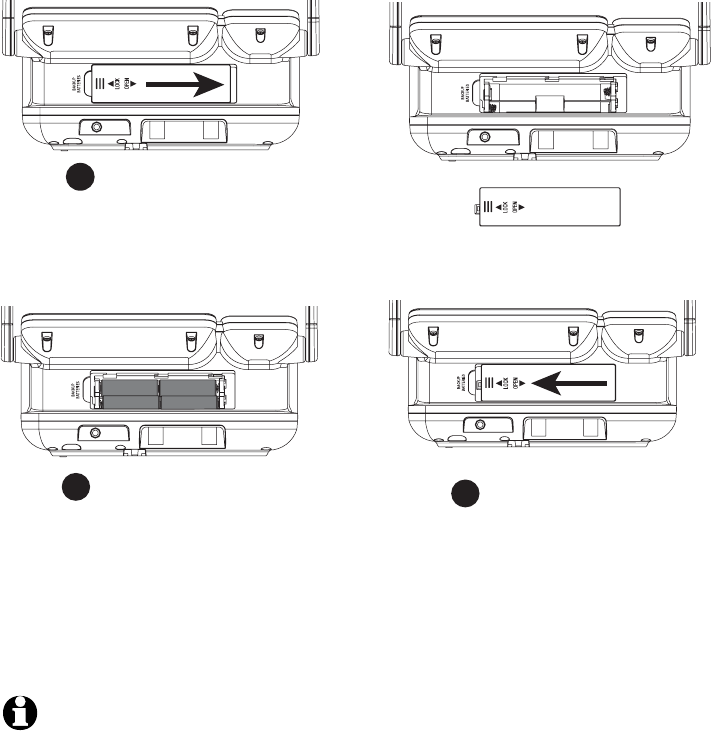
Getting started
Optional backup battery installation
Install four AA batteries (purchased separately) to use some features of
this telephone in the event of a power failure. If power fails with working
batteries installed, all the lines of this phone will work only with the corded
handset. You can answer calls, and dial calls using the dial pad and the
one touch or redial features. No other features will work until AC power is
restored.
Install the telephone base as shown below.
NOTES:
1. Use disposable AA alkaline batteries only. Do not use rechargeable batteries.
2. When there is AC power and there is no spare battery or the spare battery is low, the screen
shows LOW BATT.
Open the backup
battery compartment
cover
Step 1
Place the batteries
in the compartment
following the polarity
label +/- .
Align the cover flat
against the battery
compartment, then
slide it to the left
until it clicks into
place to lock the
cover.
Step 3
Step 2
9
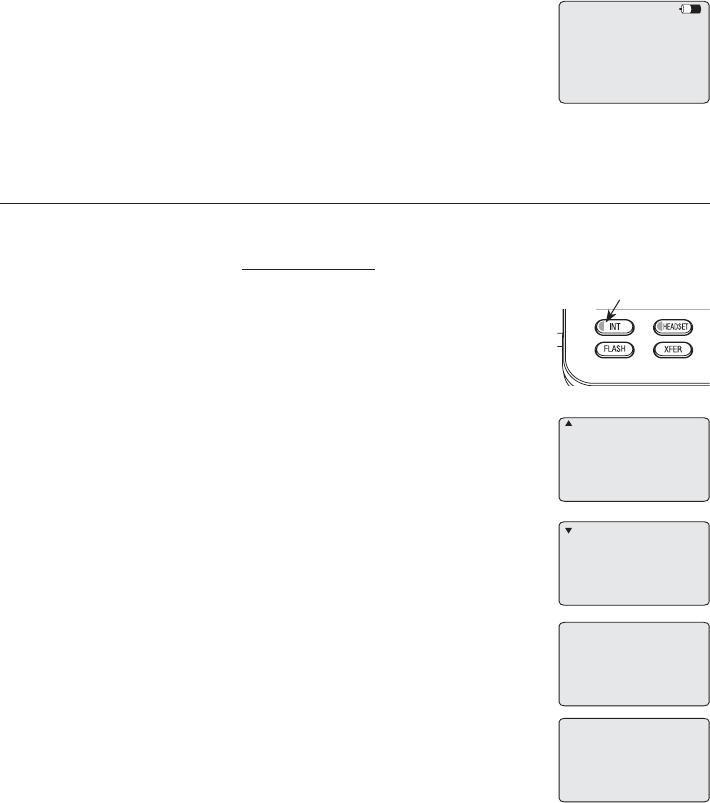
Getting started
Add and register handsets
Your telephone can have up to ten cordless handsets. You can add new
handsets (model SB67108, sold separately) to the SB67118 at any time, but
each new handset must be registered with the telephone base before use.
Each handset must be registered separately.
The handset provided with your SB67118 is automatically registered as
handset 1. Additional handsets will be assigned numbers in the order
they are registered (handset 2 to 10). You can register a maximum of ten
handsets.
Handsets purchased separately need to be registered to the telephone base
before use. When first purchased, all optional accessory
handsets will show Place handset in cradle and press INT
on base for 4 seconds to register handset on the screen.
You might need to charge the new handsets a minimum of
five minutes before registering to the telephone base (see
Battery installation and charging in the SB67108 cordless
handset manual).
To register a handset to your telephone base
1. Place the unregistered handset into the charger cradle.
2. On the telephone base, press and hold INT button for about four seconds
(until the red light below the button turns on) and
then release the button. The screen of the telephone
base shows Handset registering and it takes about 10
seconds to complete the registration. The handset shows
Handset registered and beeps when the registration is
successful.
-OR-
1. Place the unregistered handset into the charger cradle.
2. On the telephone base, press MENU/ENTER, then scroll
down to Registration.
3. Press MENU/ENTER again to browse the selections, scroll
to HS registration.
4. Press MENU/ENTER. The screen of the telephone base
shows Handset registering and it takes about 10 sec-
onds to complete the registration. The handset shows
Handset registered and beeps when the registration is
successful.
Red light
COVM
Speed dial setup
Customer support
Registration
>
HS registration
Cordless headset
Deregistration
>
Handset
registering
Handset
registered
Place handset in
cradle and press
INT on base for
4 seconds to
register handset
10

11
Getting started
Replace a handset
NOTE: If the registration is not successful, the display shows Place handset in cradle and
press INT on base for 4 seconds to register handset. To reset the handset, remove the
handset from the charger and place it back in. Try the registration process again.
You may need to de-register your handsets if
You have ten registered handsets and either need to replace a handset
or add a cordless headset (AT&T model TL7600, TL7610 or TL7611), sold
separately.
-OR-
You wish to change the handset numbers of your registered handsets.
You must first de-register ALL the handsets, and then re-register each
handset you wish to use.
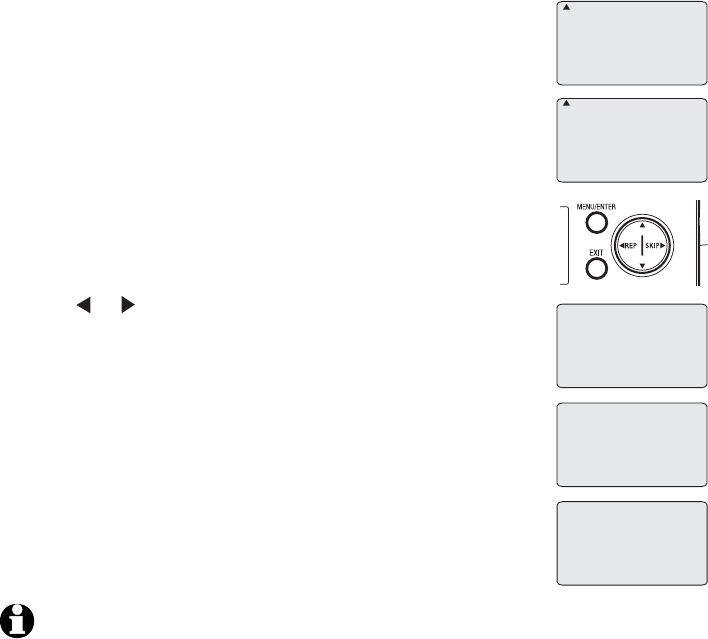
Getting started
De-register all handsets
Please read carefully through all the instructions on this page before
beginning the de-registration process. De-registering a cordless handset
removes all the data saved on the handset and the settings on the
telephone base for the selected cordless handset.
This process de-registers all cordless handsets and any cordless headset
registered to the telephone base. Please make sure the telephone system is
not in use before de-registration.
1. On the telephone base, press MENU/ENTER, then scroll
down to Registration.
2. Press MENU/ENTER again, then scroll to Deregistration.
3. Press MENU/ENTER. The screen of the telephone base
shows Deregister all handsets? <=No Yes=>.
Press or on the Navkeys to exit or continue the
deregistration.
4. The screen of the telephone base shows Deregistering,
and It takes about 10 seconds to complete the deregis-
tration. The screen shows All handsets deregistered and
beeps when the deregistration is successful.
COVM
Speed dial setup
Customer support
Registration
>
HS registration
Cordless headset
Deregistration
>
Deregister all
handsets?
<=No Yes=>
Deregistering
All handsets
deregistered
NOTES:
1. If the de-registration process is not successful, you might need to reset the system and try again.
To reset: you can press EXIT on the telephone base. You can also reset the telephone base by
unplugging the power from the telephone base and plugging it back in.
2. You cannot de-register the handsets if any system handset is in use.
3. To re-register a cordless handset, refer to the registration information on page XX.
12
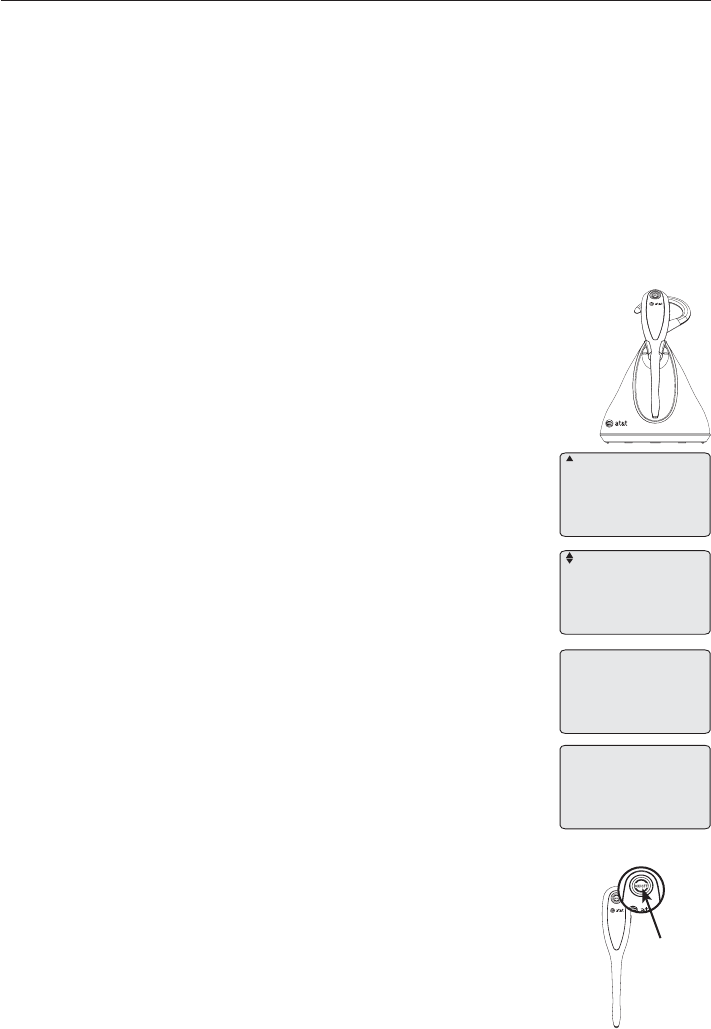
Getting started
Optional cordless headset (purchased separately)
To add a DECT 6.0 cordless headset to the system
The cordless headset must have a charged battery and be de-registered
before you can register it to the SB67118. Make sure the headset battery is
properly installed. Place the headset in the headset charger and note the
color of the ON/OFF button. If the button flashes a blue and orange light
twice every five seconds, the headset is unregistered. If the button shows
a constant blue or orange light, the headset is registered. You will need to
de-register the headset before you can register it to the SB67118 (see the
de-registration instructions in the TL7610/7611 DECT 6.0 cordless headset
User’s manual).To view the TL7610/7611/7600 model manual, visit our
website at www.telephones.att.com, or call 1 (800) 222-3111. In
Canada dial 1 (866) 288-4268.
To register the DECT headset to the telephone base
Place the headset in the headset charger and allow it to
charge for at least five minutes before beginning registration.
On the telephone base, press MENU/ENTER, then scroll
down to Registration.
Press MENU/ENTER again to browse the selections, scroll
to Cordless headset.
Press MENU/ENTER. The screen of the telephone base
shows Cordless headset registering and it takes about
10 seconds to complete the registration.
The screen of the telephone base shows
Cordless headset registered and beeps when the
registration is successful.
To verify registration was successful, press the headset
ON/OFF button and check for a dial tone.
If the registration is not successful, the ON/OFF light on the
headset flashes twice every five seconds. To reset the headset,
remove the headset from the headset charger and try the
registration process again.
•
1.
2.
3.
4.
5.
COVM
Speed dial setup
Customer support
Registration
>
HS registration
Cordless headset
Deregistration
>
Cordless headset
registered
Cordless headset
registering
ON/OFF
button
13
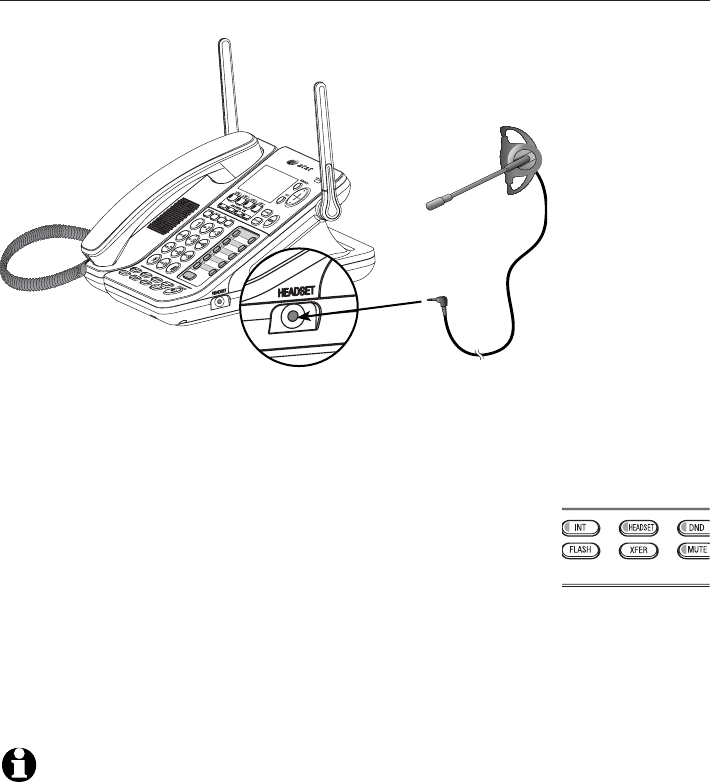
Getting started
Optional corded headset (purchased separately)
You can use this phone hands-free when you install any industry-standard
two-band 2.5mm corded headset or AT&T compatible DECT 6.0 cordless
headset. Purchase the headsets separately. For best results, use an AT&T 2.5
mm corded headset, or AT&T TL7610/7611/7600 DECT 6.0 cordless headset.
To purchase a headset, visit our website at www.telephones.att.com, or
call 1 (800) 222-3111. In Canada dial 1 (866) 288-4268.
Plug a 2.5 mm
headset into the
HEADSET jack
on the side of
the telephone
base.
Side view of the telephone base
INT/PTTALL
EXT1
EXT6
EXT7
EXT 8
EXT 9
EXT0
EXT2
EXT3
EXT4
EXT5
INT/PTT ALL
NOTE: If you have corded and cordless headsets connected to your telephone base, thenIf you have corded and cordless headsets connected to your telephone base, then
the HEADSET key controls the corded headset. If you have only a cordless headset
connected, then the HEADSET key controls the cordless headset.
To make a call:
Press HEADSET on the telephone base (if you have a
corded or cordless headset is connected to the telephone
base).
Wait for a dial tone, then dial the number.
To answer a call, press HEADSET.
To hang up, press HEADSET.
•
1.
2.
•
•
To add a corded headset to the telephone base
14
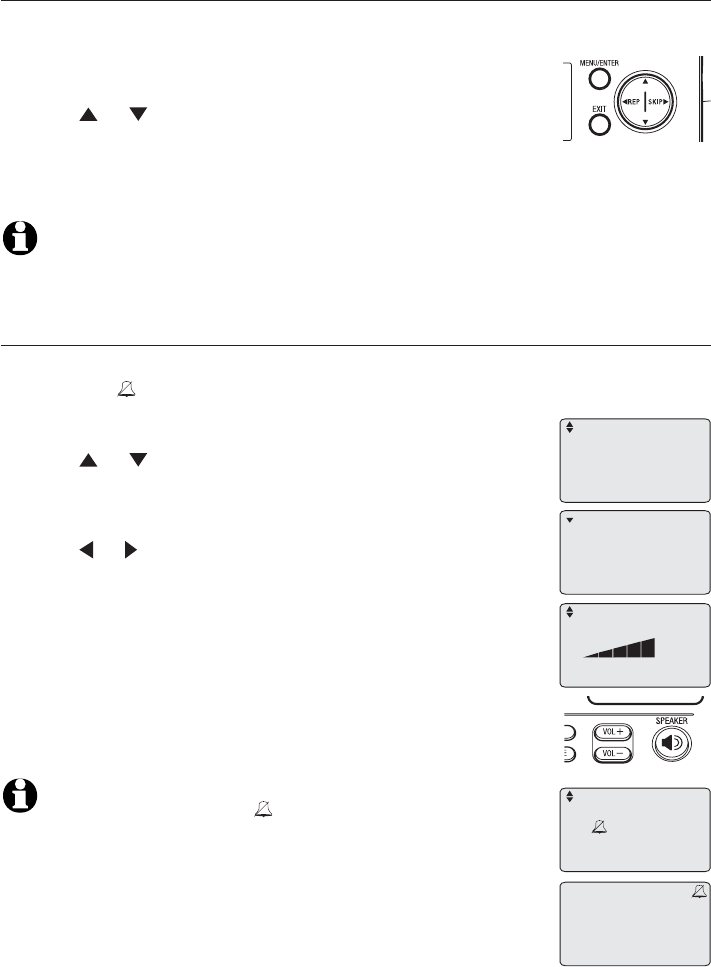
15
Getting started
Telephone base setup
Menu settings
Use the menus to change the telephone base settings.
Press MENU/ENTER when in idle mode (when the phone is
not in use) to enter the main menu.
Press or to scroll to the feature to be changed.to scroll to the feature to be changed.
The > symbol indicates the menu item.
Press MENU/ENTER to select the menu item.
Press EXIT to exit setup without making changes.
NOTE: Press EXIT to cancel an operation, exit the menu display, or return to idle mode.
Ringer volume
You can set the ring volume level (1-5), or turn the ringer off. When the
ringer is off, appears on the telephone base screen.
1. When the telephone is idle, press MENU/ENTER.
2. Press or to scroll to Ringer setting.
Press MENU/ENTER.
3. Press MENU/ENTER again to select Ringer volume.
4. Press or or the VOL+ or VOL- keys on the telephone
base to adjust the ringer volume.
5. Press MENU/ENTER to save the setting and return to the
previous menu. There is a confirmation tone. To exit with-
out making changes, press EXIT.
NOTE: When the ringer is off, stays on the telephone base screen
displays.
1.
2.
3.
4.
Directory
Call log
Ringer setting
Mailbox setup
>
Ringer volume
Ringer tone
Ringer group
>
Ringer volume
Enter=Save
Ringer volume
Enter=Save
*: Base
0 missed calls
Set date & time
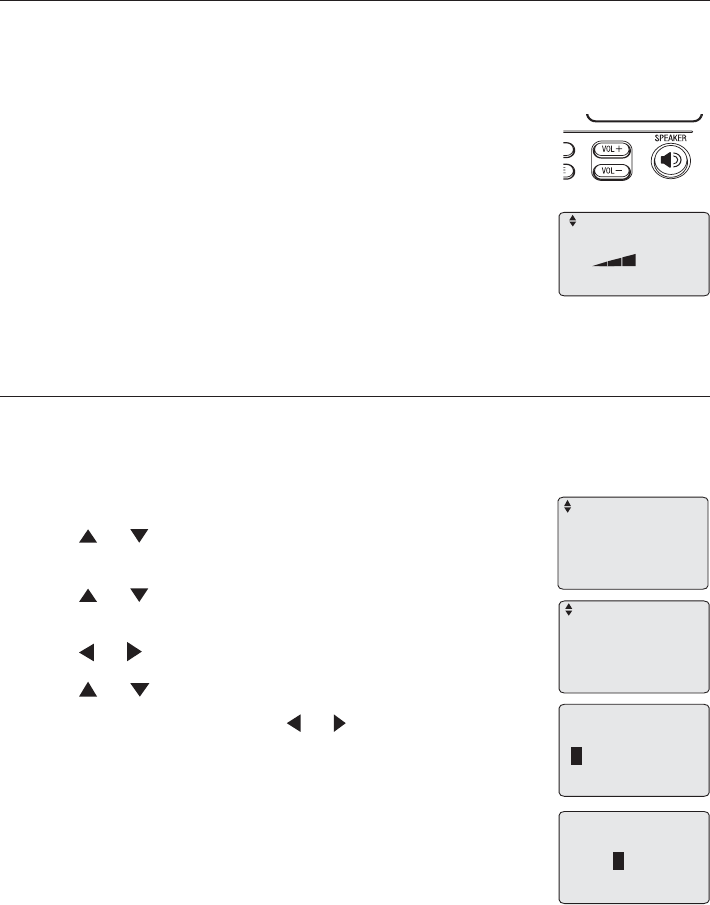
16
Getting started
Telephone base setup
Ringer tone
You can choose one of the seven ringer tones for incoming calls. You can
choose different ringer types for different lines so you can easily identify
which line is ringing.
When the telephone is idle, press MENU/ENTER.
Press or to scroll to Ringer setting.
Press MENU/ENTER.
Press or to scroll to Ringer tone.
Press MENU/ENTER.
Press or to select the desired line ( L1, L2, L3, L4 ).
Press or to select the desired ringer tone.
To move to other line, press or .
Press MENU/ENTER to save the setting and return to
the previous menu. There is a confirmation tone. To exit
without making changes, press EXIT.
1.
2.
3.
4.
5.
6.
7.
Directory
Call log
Ringer setting
Mailbox setup
>
Ringer volume
Ringer tone
Ringer group
>
Ringer tone
L1 L2 L3 L4
1 1 1 1
Ringer tone
L1 L2 L3 L4
1 3 1 1
Volume control (general settings)
You can independently set the listening volume of each of the three listening
options (corded handset, speakerphone and corded headset). While using
each, press the VOL+ and VOL- keys to adjust the listening volume.
While using the volume control, you will hear a triple beep
when you reach the minimum or maximum level.
The SB67118 telephone base remembers the volume setting
for each listening option.
Volume
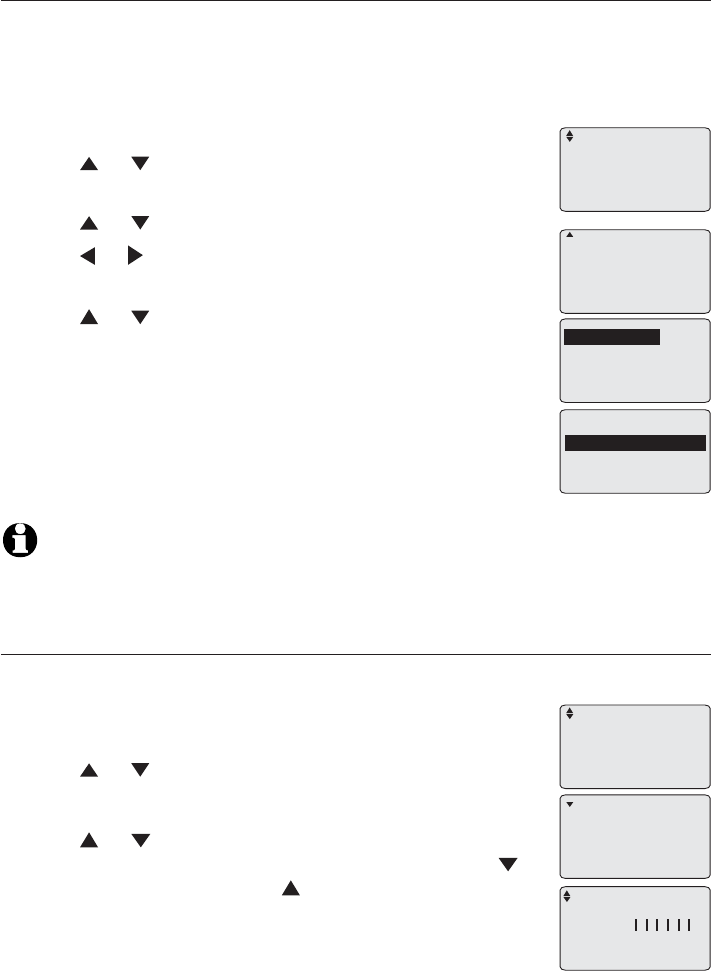
17
Getting started
Telephone base setup
Ring group
You can specify which extensions receive incoming calls. By default, all
extensions and the telephone base receive incoming calls. You can block
some extensions from receiving calls, however, they can still be used to place
outgoing calls.
When the telephone is idle, press MENU/ENTER.
Press or to scroll to Ringer setting.
Press MENU/ENTER.
Press or to scroll to Ring group. Press MENU/ENTER.
Press or to select the desired line
( L1, L2, L3, L4 ) while Ring group flashes.
Press or , then press the extension number on the
dial pad (*,1,2,3,4,5,6,7,8,9,0) that you want to delete
from the ring group, or press the number again to add it
up to the group.
Press MENU/ENTER to save the setting and return to
the previous menu. There is a confirmation tone. To exit
without making changes, press EXIT.
NOTE: * stands for the telephone base; 0 stands for extension 10.
1.
2.
3.
4.
5.
6.
Directory
Call log
Ringer setting
Mailbox setup
>
Ringer volume
Ringer tone
Ringer group
>
Ring group: L3
Extension number:
*1-3-56-8-0
Enter=Save
Ring group: L3
Extension number:
*1234567890
<>
LCD contrast
You can adjust the screen contrast to one of six levels to optimize readability
in different lighting conditions.
When the telephone is idle, press MENU/ENTER.
Press or to scroll to Base setup. Press MENU/ENTER.
Press MENU/ENTER again to select LCD contrast.
Press or to scroll to the screen contrast level. The
screen display temporarily fades away as you press
and reappears as you press .
Press MENU/ENTER to save the setting and return to
the previous menu. There is a confirmation tone. To exit
without making changes, press EXIT.
1.
2.
3.
4.
5.
Call log
Ringer setting
Mailbox setup
Base setup
>
LCD contrast
Key tone
Language
Line selection
>
LCD contrast
LOW H
Enter=Save
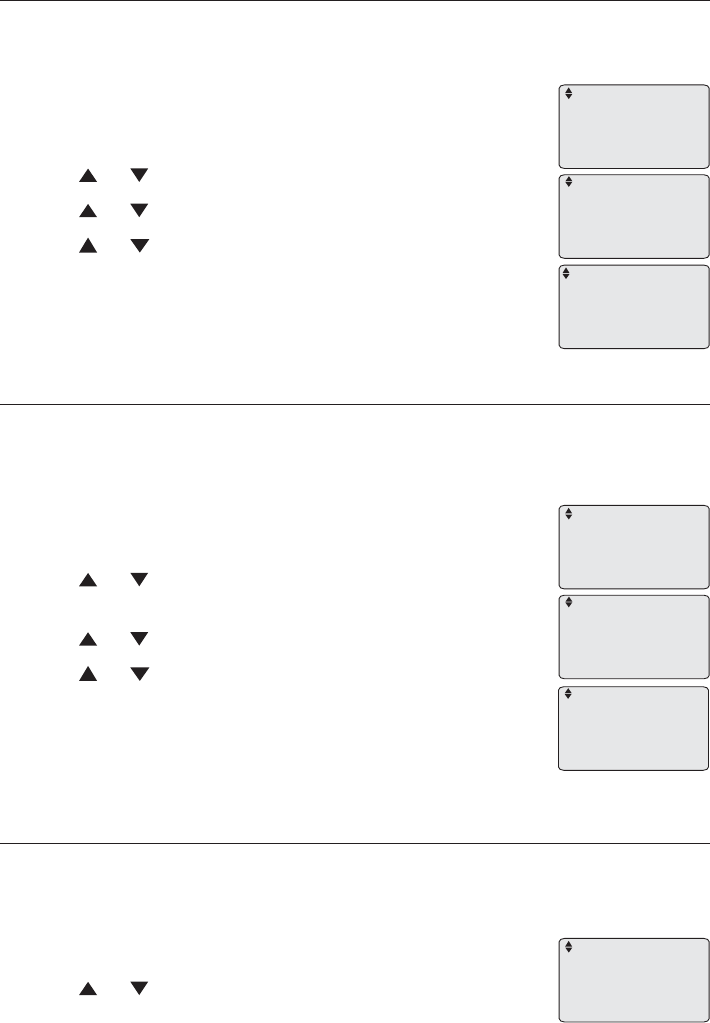
18
Getting started
Telephone base setup
You can set the specific telephone line for your telephone base to make
outgoing calls. This telephone comes factory set for Auto selectable line,
which chooses the most available line for making a call.
When the telephone is idle, press MENU/ENTER.
Press or to scroll to Base setup. Press MENU/ENTER.
1.
2.
Language
You can change the display language that is used in all menus and screen
displays. Set the display language separately on the telephone base and each
extension separately. This telephone comes factory set for English displays.
To change the display language for the telephone base:
When the telephone is idle, press MENU/ENTER.
Press or to scroll to Base setup. Press MENU/
ENTER.
Press or to scroll to Language. Press MENU/ENTER.
Press or to scroll to a language.
Press MENU/ENTER again to save the setting and return
to the previous menu. There is a confirmation tone. To
exit without making changes, press EXIT.
1.
2.
3.
4.
5.
Line selection
Call log
Ringer setting
Mailbox setup
Base setup
>
Call log
Ringer setting
Mailbox setup
Base setup
>
LCD contrast
Key tone
Language
Line selection
>
Language
:English
Enter=Save
Key tone
You can turn the Key tone on and off. The telephone base is factory
programmed to beep with each key press. If you turn off the Key tone, there
will be no beeps when keys are pressed.
To turn the key tone on and off:
When the telephone is idle, press MENU/ENTER.
Press or to scroll to Base setup. Press MENU/ENTER.
Press or to scroll to Key tone. Press MENU/ENTER.
Press or to scroll to On or Off.
Press MENU/ENTER to save the setting and return to
the previous menu. There is a confirmation tone. To exit
without making changes, press EXIT.
1.
2.
3.
4.
5.
Call log
Ringer setting
Mailbox setup
Base setup
>
Key tone
:Off
Enter=Save
LCD contrast
Key tone
Language
Line selection
>
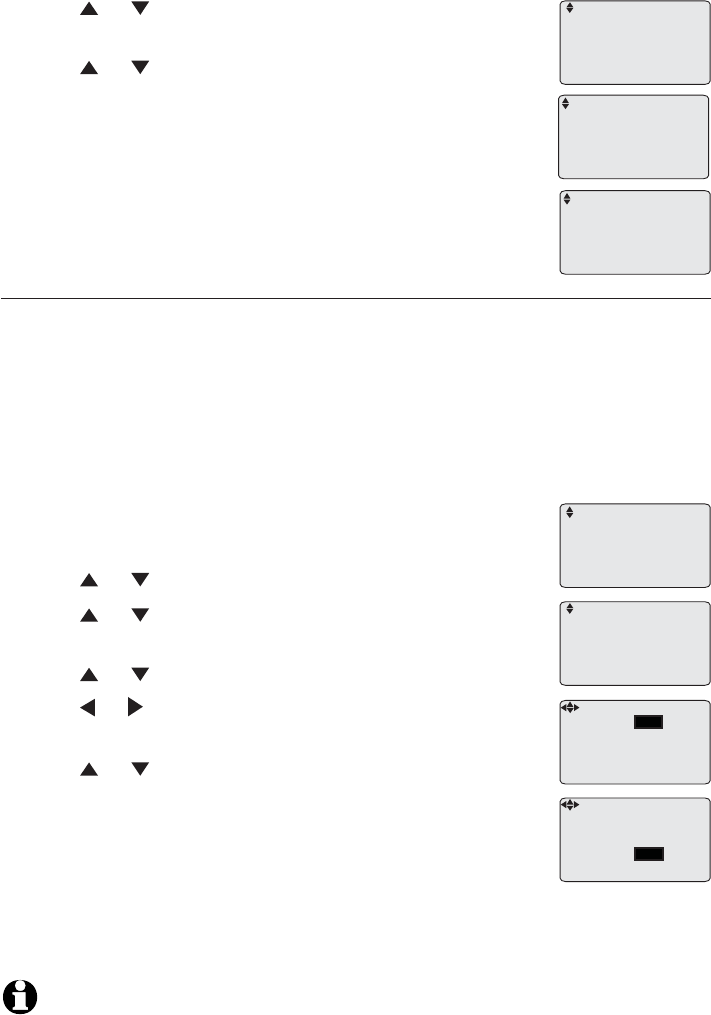
19
Getting started
Telephone base setup
Press or to scroll to Line selection.
Press MENU/ENTER.
Press or to scrool to the desired line, Auto, L1, L2,
L3 or L4, that you want to set as default line for making
outgoing calls.
Press MENU/ENTER to save the setting and return to
the previous menu. There is a confirmation tone. To exit
without making changes, press EXIT.
3.
4.
5.
Line selection
:Auto
Enter=Save
LCD contrast
Key tone
Language
Line selection
>
NOTE: If the line icon on the base screen display does not reflect the line status, try another
line mode.
Set line mode
For the system to behave properly, it needs to be set for:
a) PBX lines, which are typically business telephone systems that require you
to dial 8 or 9 to get an outside line.
-OR-
b) CO lines, which are standard residential telephone lines. This telephone
comes factory set for PBX lines.
You can set each line, individually to either PBX or CO.
When the telephone is idle, press MENU/ENTER.
Press or to scroll to Base setup. Press MENU/ENTER.
Press or to scroll to Set line mode.
Press MENU/ENTER.
Press or to scroll to a desired line, L1, L2, L3 or L4.
Press or to change the highlighted line mode,
PBX or CO.
Press or to move to another line.
Press MENU/ENTER to save the setting and return to
the previous menu. There is a confirmation tone. To exit
without making changes, press EXIT.
1.
2.
3.
4.
5.
6.
7.
Call log
Ringer setting
Mailbox setup
Base setup
>
Key tone
Language
Line selection
Set line mode
>
L1 PBX
L2 PBX
L3 PBX
L4 PBX
L1 CO
L2 PBX
L3 CO
L4 PBX
Line selection
:L3
Enter=Save
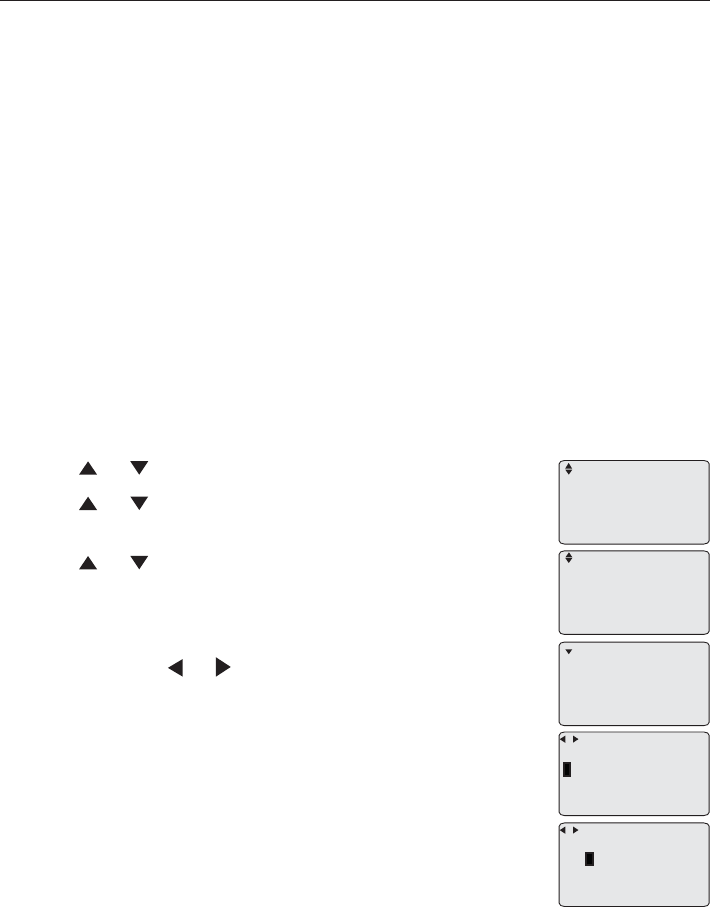
20
Getting started
Telephone base setup
Area codes
You can program this system to recognize one home area code and up to
four local area codes. This feature makes it easy for you to place a call from
the caller ID log.
If you dial 7 digits to make a local call (no area code required), enter your
area code into the telephone as the home area code. When you receive a
call from within your home area code, the caller ID history only displays the
seven digits of the telephone number, and when you dial from the call log,
only seven digits are dialed.
If you must dial 10 digits (the area code and telephone number) for calls
within your own home area code, enter 000 for the home area code and
enter your area code as a local area code. Then, if you receive a call from
within your area code, the screen displays the 10 digits of the telephone
number, and when you dial from the call log, only ten digits will be dialed.
If you must also dial 10-digit for other nearby area codes, enter those area
codes as local area codes.
When the telephone is idle, press MENU/ENTER.
Press or to scroll to Base setup. Press MENU/ENTER.
Press or to scroll to Area codes.
Press MENU/ENTER.
Press or to scroll to Home area or Local area 1-4.
Press MENU/ENTER to edit it.
Use the dial pad keys to enter a 3-digit area code. Enter
000 for your home area code if you never dial 7-digit
numbers. Press or to scroll to the digit you want to
edit, or press REMOVE to delete digits while entering.
Press MENU/ENTER to save the setting and return to
the previous menu. There is a confirmation tone. To exit
without making changes, press EXIT.
1.
2.
3.
4.
5.
6.
Call log
Ringer setting
Mailbox setup
Base setup
>
Language
Line selection
Set line mode
Area codes
>
Home area
Local area 1
Local area 2
Local area 3
>
Home area
Enter=Save
Local area 1
001
Enter=Save
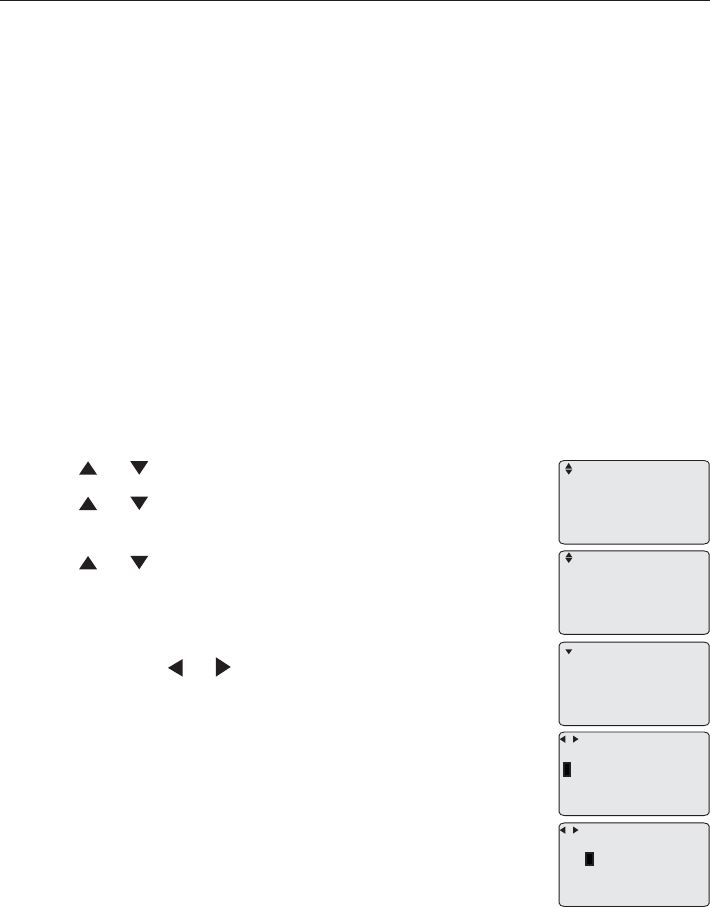
20
Getting started
Telephone base setup
Area codes
You can program this system to recognize one home area code and up to
four local area codes. This feature makes it easy for you to place a call from
the caller ID log.
If you dial 7 digits to make a local call (no area code required), enter your
area code into the telephone as the home area code. When you receive a
call from within your home area code, the caller ID history only displays the
seven digits of the telephone number, and when you dial from the call log,
only seven digits are dialed.
If you must dial 10 digits (the area code and telephone number) for calls
within your own home area code, enter 000 for the home area code and
enter your area code as a local area code. Then, if you receive a call from
within your area code, the screen displays the 10 digits of the telephone
number, and when you dial from the call log, only ten digits will be dialed.
If you must also dial 10-digit for other nearby area codes, enter those area
codes as local area codes.
When the telephone is idle, press MENU/ENTER.
Press or to scroll to Base setup. Press MENU/ENTER.
Press or to scroll to Area codes.
Press MENU/ENTER.
Press or to scroll to Home area or Local area 1-4.
Press MENU/ENTER to edit it.
Use the dial pad keys to enter a 3-digit area code. Enter
000 for your home area code if you never dial 7-digit
numbers. Press or to scroll to the digit you want to
edit, or press REMOVE to delete digits while entering.
Press MENU/ENTER to save the setting and return to
the previous menu. There is a confirmation tone. To exit
without making changes, press EXIT.
1.
2.
3.
4.
5.
6.
Call log
Ringer setting
Mailbox setup
Base setup
>
Language
Line selection
Set line mode
Area codes
>
Home area
Local area 1
Local area 2
Local area 3
>
Home area
Enter=Save
Local area 1
001
Enter=Save
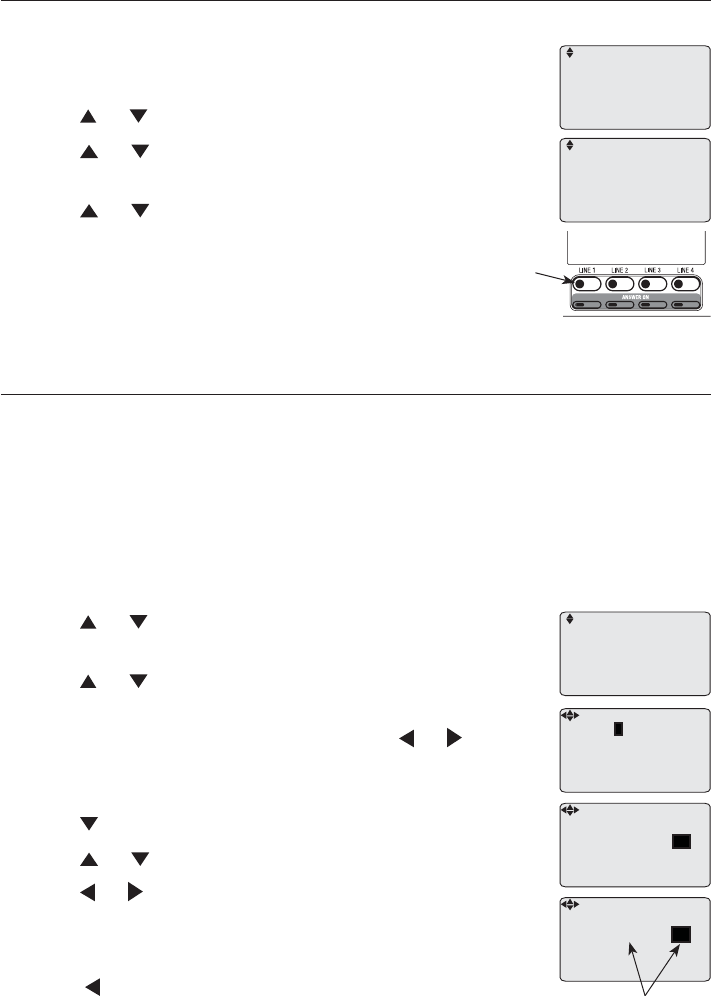
21
Getting started
Telephone base setup
The answering system displays the day and time of the message while to
playing it. Before using the answering system, set the date and time as
follows. If you subscribe to caller ID service, the day, month and time are set
automatically with each incoming call. The year must be set so that the day
of the week can be calculated from the caller ID information.
Follow the steps below to set the month, day, year and time.
When the telephone is idle, press MENU/ENTER.
Press or to scroll to Base setup.
Press MENU/ENTER.
Press or to scroll to Time adjustment.
Press MENU/ENTER.
Using the dial pad, enter the date. Press or to scroll
to the item you want to edit, and press the dial pad keys
to enter the correct digit.
Press to move to the time editing.
Press or to select the AM or PM.
Press or to scroll to the item you want to edit, and
press to enter the correct digit.
-OR-
Press to move back to the date editng.
1.
2.
3.
4.
5.
6.
7.
Hold reminder
You can have silence or to play a beep tone every 30 seconds when there is
a call on hold.
When the telephone is idle, press MENU/ENTER.
Press or to scroll to Base setup. Press MENU/ENTER.
Press or to scroll to Hold reminder.
Press MENU/ENTER.
Press or to scroll to On or Off.
Press MENU/ENTER to save the setting and
return to the previous menu. There is a
confirmation tone. To exit without making
changes, press EXIT.
1.
2.
3.
4.
5.
Line selection
Set line mode
Area codes
Hold reminder
>
Hold reminder
:On
Enter=Save
Flashes
Time adjustment
Set line mode
Area codes
Hold reminder
Time adjustment
>
Date: 12.31. 2006
Time: 12:00 PM
^>=PM Enter=Save
Date: 01.01. 2009
Time: 12:00 PM
^>=PM Enter=Save
Date: 01.01. 2009
Time: 14:30 AM
^>=PM Enter=Save
Wrong
setting
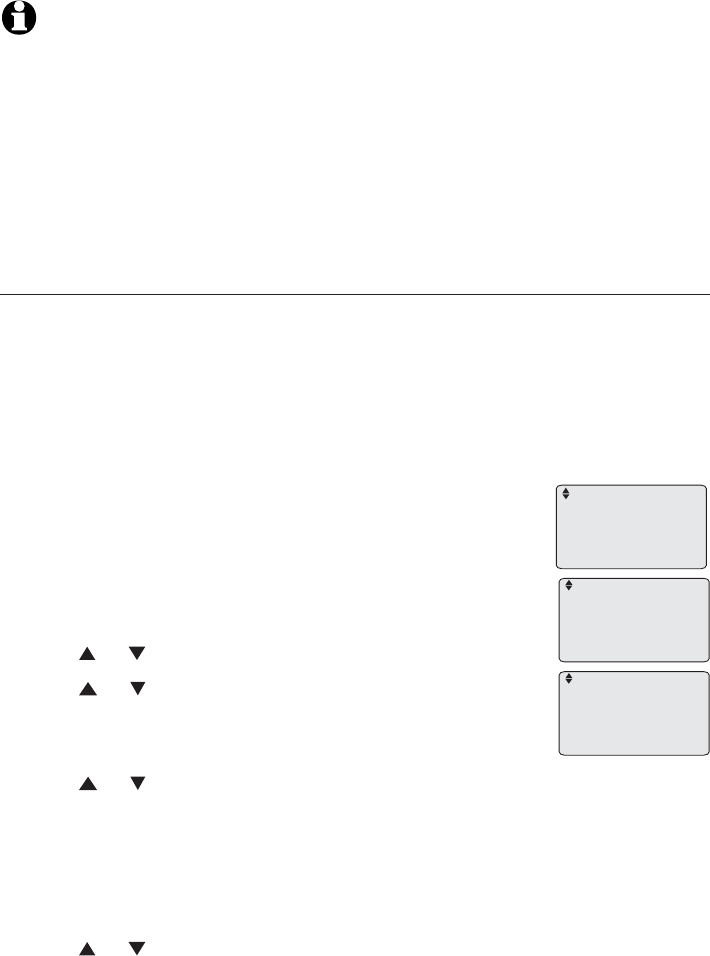
22
Getting started
Telephone base setup
You can turn MOH on or off. When MOH is On, the system plays either pre-
recorded music or your own music or message to people whom you have put
on hold.
You have two options for creating your own recording (up to three minutes)
to play as music on hold. This recording replaces the pre-recorded music.
Once you record your own, you cannot go back to the pre-recorded music.
You can use the provided audio cable to copy a recording
from an audio device, or you can record a message using
the telephone handset.
• Turning MOH on or off
When the telephone is idle, press MENU/ENTER.
Press or to scroll to Base setup. Press MENU/ENTER.
Press or to scroll to Music on hold.
Press MENU/ENTER.
Press MENU/ENTER again to select Music on/off.
Press or to select On or Off.
Press MENU/ENTER to save the setting and return to the previous menu.
There is a confirmation tone. To exit without making changes, press EXIT.
• Reviewing the recording
When the telephone is idle, press MENU/ENTER.
Press or to scroll to Base setup. Press MENU/ENTER.
1.
2.
3.
4.
5.
6.
1.
2.
Music on hold (MOH)
Music on/off
Preview music
Record new music
>
Music on hold
:On
Enter=Save
NOTES:
1. The time format is in 12-hour clock format. If you set an invalid time, you hear an error tone while
pressing ENTER to save the setup. The error tone means the setting cannot be saved. You need to
correct the time entry to continue the set up process..
2. If the date and time are not set when a message is recorded, the system does not display date and
time on the screen while playing messages..
8. Press MENU/ENTER to save the setting and return to the previous menu.
There is a confirmation tone. To exit without making changes, press EXIT.
Call log
Ringer setting
Mailbox setup
Base setup
>
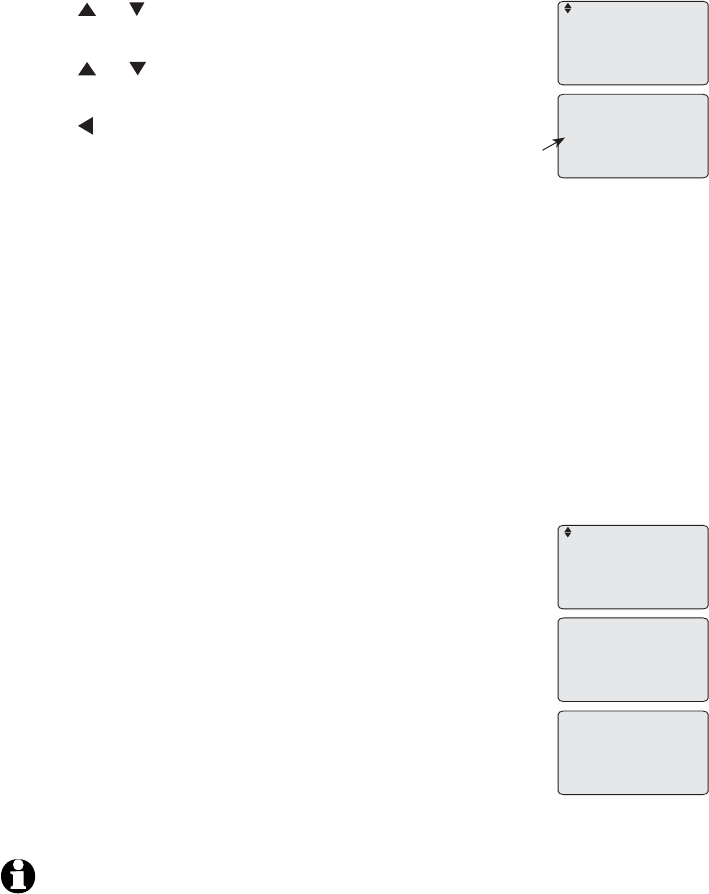
23
Getting started
Telephone base setup
Press or to scroll to Music on hold.
Press MENU/ENTER.
Press or to scroll to Preview music.
Press MENU/ENTER to hear the current recording.
Press to return to the previous menu.
Copying recorded music or message
When the telephone is idle, press MENU/ENTER.
Press or to scroll to Base setup. Press MENU/ENTER.
Press or to scroll to Music on hold. Press MENU/ENTER.
Press or to scroll to Record new music. Press MENU/ENTER.
When you are ready, start playing the music on your audio device and
press MENU/ENTER to start recording. A timer appears on the screen and
starts counting.
Press MENU/ENTER to stop recording. Then the display returns to the
previous menu. To exit without making changes, press EXIT.
Recording music or message using the handset
When the telephone is idle, press MENU/ENTER.
Press or to scroll to Base setup. Press MENU/ENTER.
Press or to scroll to Music on hold. Press MENU/ENTER.
Press or to scroll to Record new music. Press MENU/
ENTER.
Pick up the handset. When you are ready, press MENU/
ENTER to start recording. A timer appears on the screen
and starts counting.
Press MENU/ENTER to stop recording. Then the display
returns to the previous menu. To exit without making changes, press EXIT.
3.
4.
5.
•
1.
2.
3.
4.
5.
6.
•
1.
2.
3.
4.
5.
6.
M.O.H record
00:09
Enter=Stop
M.O.H record
Enter=Start
Music on/off
Preview music
Record new music
>
NOTES:
1. Do not lift the corded handset for recording until you enter the Record new music menu.
2. If there is silence detected for six seconds while recording, the screen display automatically returns
to the upper level menu. That means the recording was unsuccessful. The previously recorded
music or message will play when calls are on hold until you successfully record new music or a
message.
2. After three minutes, the base stops recording, but the recording is saved. The screen returns to the
previous menu. The new recording replaces the pre-recorded music to be played when calls are on
hold. 23
Elapsed
time
Play M.O.H
02:42
<=Back
Music on/off
Preview music
Record new music
>
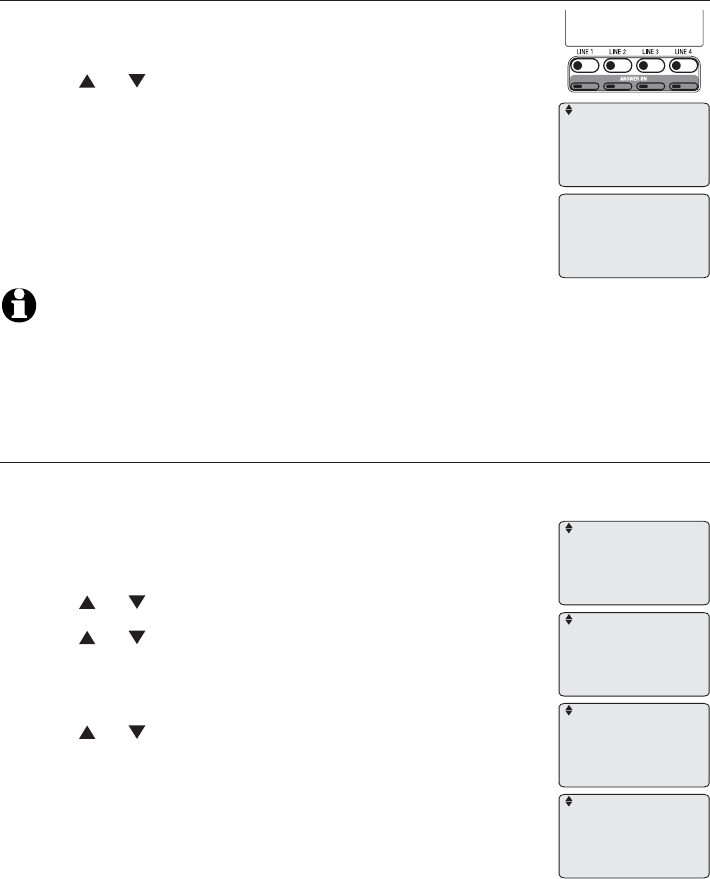
24
Getting started
Auto attendant setup (for answering system)
Turn on the auto attendant
When the telephone is idle, press the ANSWER ON key
for the line you want to set up.
Press or to scroll to Ans->Auto att.
Press MENU/ENTER. The Auto attendant is on and the
current auto attendant announcement plays. The screen
displays Auto Attendant ON Play announcement,
and then the idle screen appears.
1.
2.
You can set up the auto attendant to answer outside calls, provide callers
with company directories and record voice messages for each telephone
line. You can use a pre-recorded announcement or record your own; you
can record up to five announcements of up to two minutes each by the
mouthpiece of the corded handset.
NOTE: While previewing the announcement, press VOL+ or VOL- to adjust the volume. If
you do not want to hear the announcement, press EXIT, the setting is saved.
Ans->Gen MB only
Ans->Auto att
No answer
Setup
>
Auto Attendant ON
Play announcement
00:09
Number of rings
You can set the number of times the phone rings before the Auto Attendant
answers. The number of rings can be 2, 3, 4, 5, 6 or 7.
When the telephone is idle, press ANSWER ON for the
desired line.
Press or to scroll to Setup. Press MENU/ENTER.
Press or to scroll to Auto attendant.
Press MENU/ENTER.
Press MENU/ENTER again to select Number of rings.
Press or to select a number.
Press MENU/ENTER to save the setting and return to
the previous menu. There is a confirmation tone. To exit
without making changes, press EXIT.
1.
2.
3.
4.
5.
6.
Ans->Gen MB only
Ans->Auto att
No answer
Setup
>
Mailbox setup
Auto attendant
Anncement
>
Number of rings
Select annc
>
Number of rings
:2
Enter=Save
24
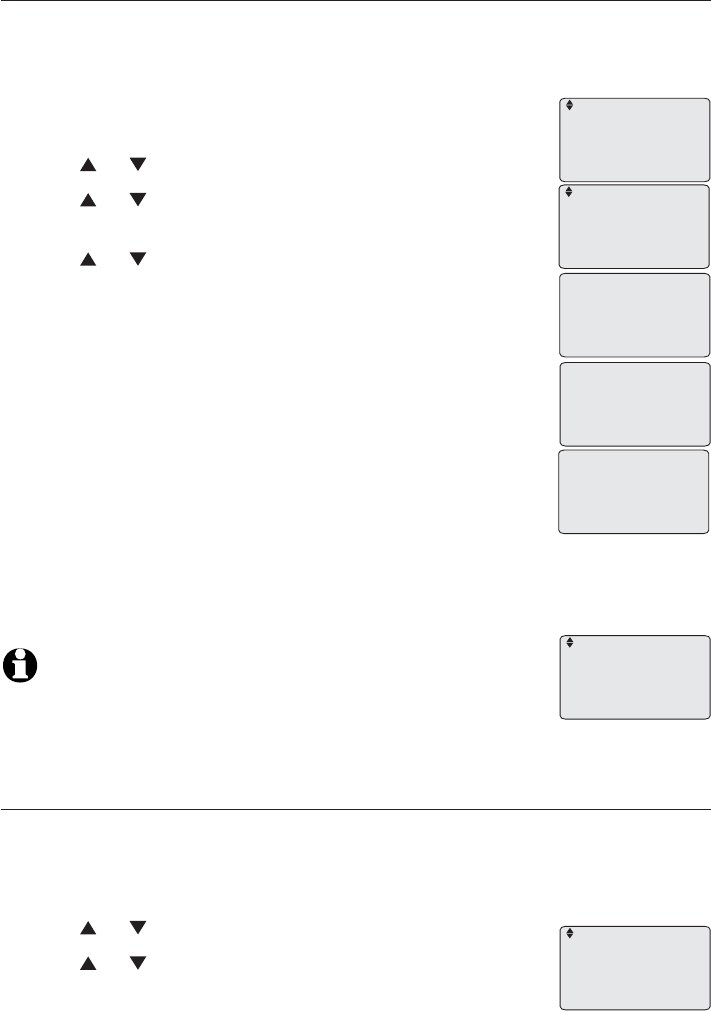
25
Getting started
Auto attendant setup (for answering system)
Record announcement
You can record up to five new announcements so that you can have different
announcements for different lines. Each announcement can be up to two
minutes.
When the telephone is idle, press ANSWER ON for the
desired line.
Press or to scroll to Setup. Press MENUMENU/ENTER.
Press or to scroll to Anncement. Press MENU/
ENTER.
Press or to scroll to one of the announcements
from, Annc 1 through Annc 5. If no message has been
recorded, (none) also appears. Press MENU/ENTER.
Press MENU/ENTER to start recording. The timer starts
counting.
Press MENU/ENTER to stop recording. The timer stops
and the recorded announcement automatically plays
back.
Press 2to save the setting and return to the previous
menu, or press 1to re-record that announcement..
-OR-
To exit without making changes, press EXIT.
NOTE: Once there is a message, (none) disappears after the message
Ancc 1 through Annc 5.
Select announcement
1.
2.
3.
4.
5.
6.
7.
Mailbox setup
Auto attendant
Anncement
>
Annc 1 (none)
Annc 2 (none)
Annc 3 (none)
>
Record annc 1
Enter=Save
Record annc 1
00:11
Enter=Stop
Play annc 1
00:03
1=Change 2=OK
Annc 1
Annc 2 (none)
Annc 3 (none)
>
You can select an announcement for your independent auto attendant from
the list of announcements.
When the telephone is idle, press ANSWER ON for the desired line.
Press or to scroll to Setup. Press MENUMENU/ENTER.
Press or to scroll to Auto attendant.
Press MENU/ENTER.
1.
2.
3.
Mailbox setup
Auto attendant
Anncement
>
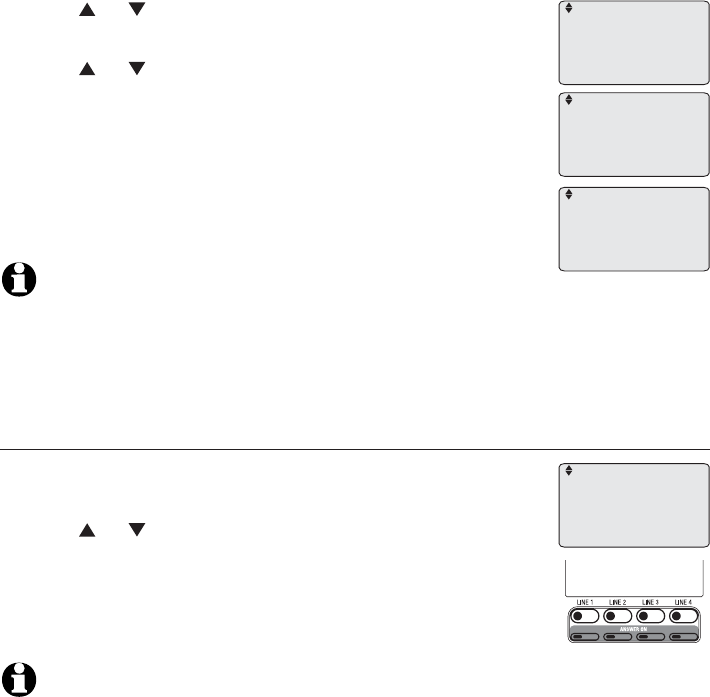
26
Getting started
Auto attendant setup (for answering system)
Press or to scroll to Select annc.
Press MENU/ENTER.
Press or to scrool to an announcement.
Press MENU/ENTER to save the setting and return to
the previous menu. There is a confirmation tone. To exit
without making changes, press EXIT.
NOTE: The auto attendant and the private mailboxes share the same
list of announcements. Make sure to preview to select a correct announcement before
setting.
Turn off the auto attendant
When the telephone is idle, press ANSWER ON for the
desired line.
Press or to scroll to No answer. Press MENU/ENTER
to turn off the auto attendant feature for that line.
NOTE: You cannot record an announcement when the phone system is out of space. You
will hear “Sorry, there is no space for recording.” Please refer to Remaining space on page
X.
4.
5.
6.
1.
2.
Ans->Gen MB only
Ans->Auto att
No answer
Setup
>
Number of rings
Select annc
>
Select annc
:Prerecord
Enter=Save
Select annc
:Annc 2
Enter=Save
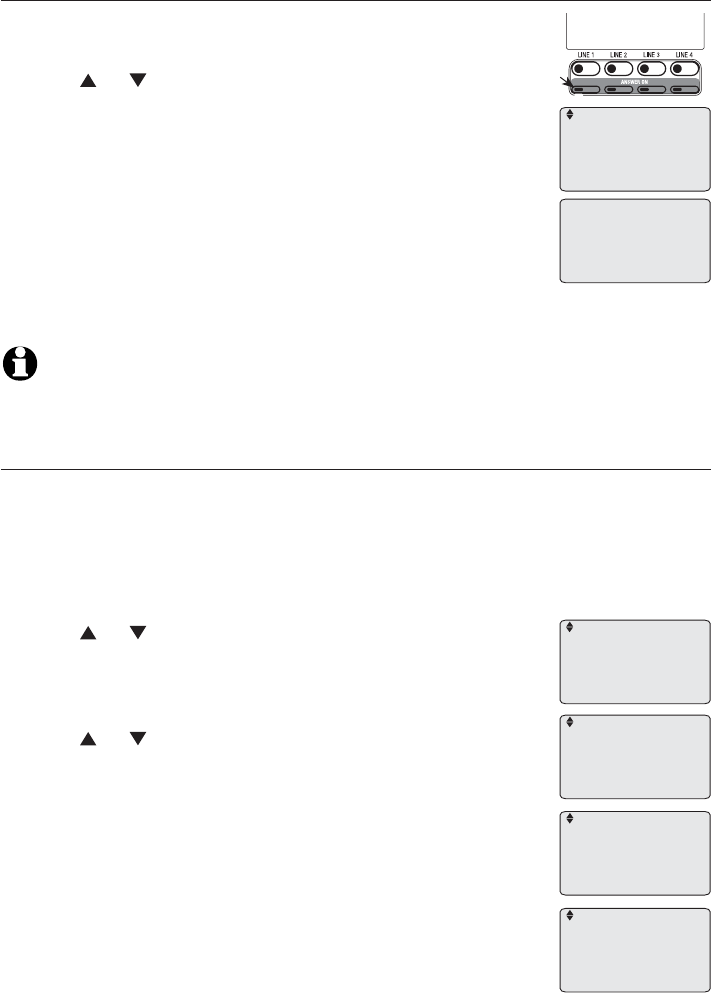
27
Getting started
Mailbox setup (for answering system)
Turn on the mailbox
When the telephone is idle, press ANSWER ON for the
desired line.
Press or to scroll to Ans->Gen MB only. Press
MENU/ENTER.
The ANSWER ON indicator lights. The current mailbox
announcement plays. The screen displays Voicemail
ON Play announcement, and then it returns to the idle
screen.
-OR-
To exit without making changes, press EXIT.
NOTE: While previewing the announcement, you can adjust the volume by pressing VOL+ or
VOL-. If you do not want to hear the announcement, press EXIT, the setting is saved.
1.
2.
You set each telephone line mailbox separately.
Ans->Gen MB only
Ans->Auto att
No answer
Setup
>
Voicemail ON
Play announcement
00:09
Number of rings
You can set the number of times the phone rings before the Mailbox
answers. The number of rings can be 2, 3, 4, 5, 6 or 7. You can also select
Toll saver, which is explained below. Unless you change it, the answering
system answers an incoming call after four rings.
When the telephone is idle, press ANSWER ON for the desired line.
Press or to scroll to Setup. Press MENU/ENTER.
Press MENU/ENTER again to select Mailbox setup.
Press MENU/ENTER again to select Number of rings.
Press or to scroll to a number or toll saver.
Toll saver - the answering system answers a call after
two rings when there are new messages, and after four
rings when there are no new messages. This enables
you to check for new messages without paying for a
toll call.
6. Press MENU/ENTER to save the setting and return to the
previous menu. There is a confirmation tone. To exit with-
out making changes, press EXIT.
1.
2.
3.
4.
5.
•
Mailbox setup
Auto attendant
Anncement
>
Number of rings
Select annc
>
Number of rings
:Toll saver
Enter=Save
Number of rings
:5
Enter=Save
On
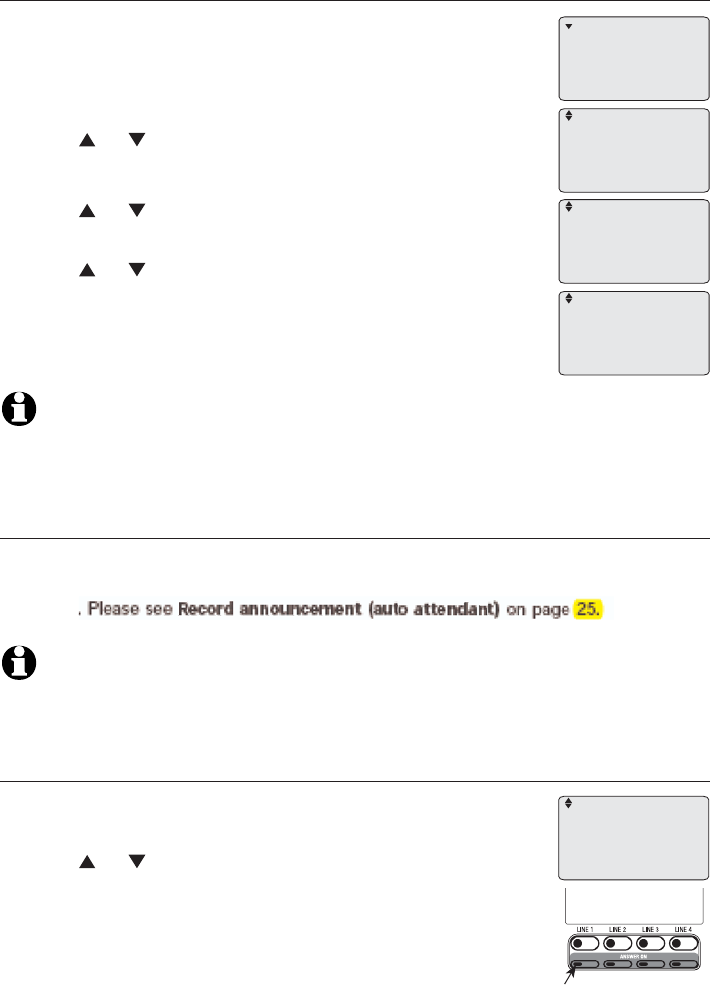
28
Getting started
Mailbox setup (for answering system)
Record announcement
You can record up to five new announcements so that you can have different
announcements for different lines. Each announcement can be up to two
minutes. Please see Record announcement on page XX.
Turn off the mailbox
When the telephone is idle, press ANSWER ON for the
desired line.
Press or to scroll to No answer. Press MENU/ENTER.
1.
2.
Ans->Gen MB only
Ans->Auto att
No answer
Setup
>
Off
Select announcement
You can select an announcement for your independent
mailbox from the list of announcements.
When the telephone is idle, press ANSWER ON for the
desired line.
Press or to scroll to Setup. Press MENU/ENTER.
Press MENU/ENTER again to select Mailbox setup.
Press or to scroll to Select annc.
Press MENU/ENTER.
Press or to scroll to an announcement.
Press MENU/ENTER to save the setting and return to
the previous menu. There is a confirmation tone. To exit
without making changes, press EXIT.
1.
2.
3.
4.
5.
6.
Mailbox setup
Auto attendant
Anncement
>
Number of rings
Select annc
>
Select annc
:Prerecord
Enter=Save
Select annc
:Annc 1
Enter=Save
NOTE: The auto attendant and the mailbox share the same list of announcements. Preview
the announcements to select the correct announcement before setting.
NOTE: You cannot record an announcement when the phone system is out of space. You will
hear “Sorry, there is no space for recording”. Please refer to Remaining space on page X.
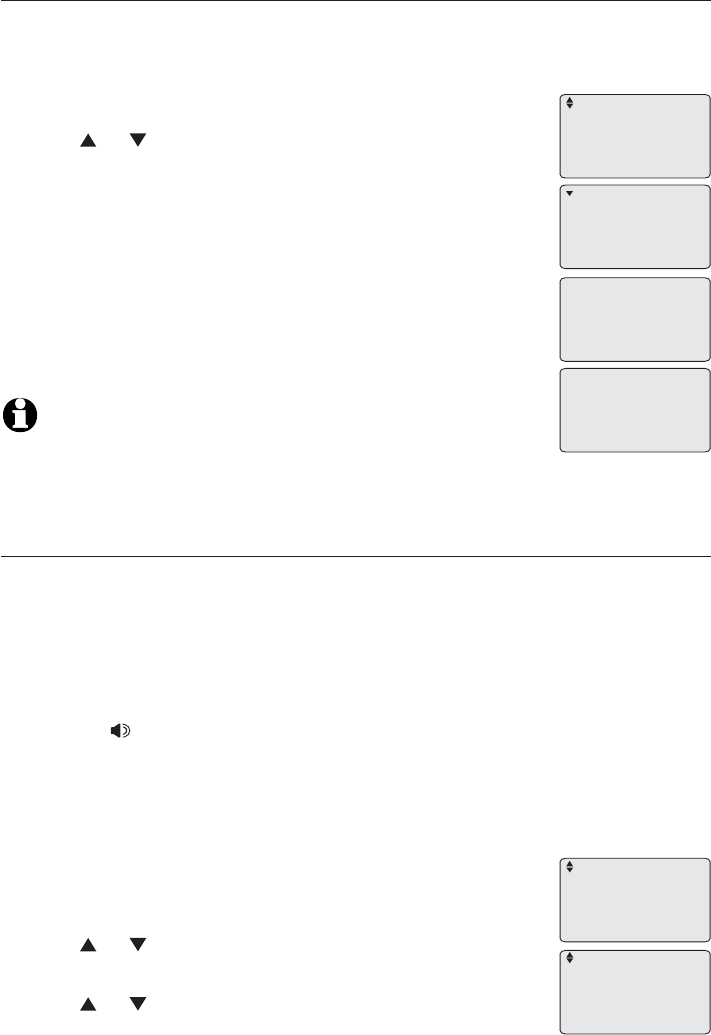
29
Getting started
Mailbox setup (for general mailbox)
You can choose whether incoming messages can be heard over the speaker
when they are being recorded. If you turn call screening on, you hear the
incoming private message on your telephone when a call comes in.
If more than one incoming messages from different phone lines comes at the
same time, only the first incoming message is monitored. While monitoring
message recording, you can answer the call by lifting the corded handset or
by pressing SPEAKER.
You can press VOL+ or VOL- to adjust the volume while listening to the
message recording. If you want to stop the message recording, press MUTE
on the base to temporarily disable the call screening.
Follow the steps below to set call screening feature on or
off:
When the telephone is idle, press MENU/ENTER.
Press or to scroll to Mailbox setup.
Press MENU/ENTER.
Press or to scroll to Call screening.
1.
2.
3.
Set access code (Remote code)
You can enter a four-digit number (0000-9999) to allow remote access to
your general mailbox from any touch-tone telephone. Unless you change it,
the remote access code is 0000.
When the telephone is idle, press MENU/ENTER.
Press or to scroll to Mailbox setup.
Press MENU/ENTER.
Press MENU/ENTER again to select Set access code.
Use the dial pad to enter a four-digit number. Use
REMOVE to delete a digit.
Press MENU/ENTER to save the setting and return to
the previous menu. There is a confirmation tone. To exit
without making changes, press EXIT.
NOTES:
1. The access code must have four digits.
2. You will hear an error tone if you enter an access code that is already being used.
1.
2.
3.
4.
5.
Directory
Call log
Ringer setting
Mailbox setup
>
Set access code
Call screening
Notify alert
Remaining space
>
Enter mailbox
access code:
0000
Enter=Save
Enter mailbox
access code:
9999
Enter=Save
Call screening
Set access code
Call screening
Notify alert
Remaining space
>
Directory
Call log
Ringer setting
Mailbox setup
>
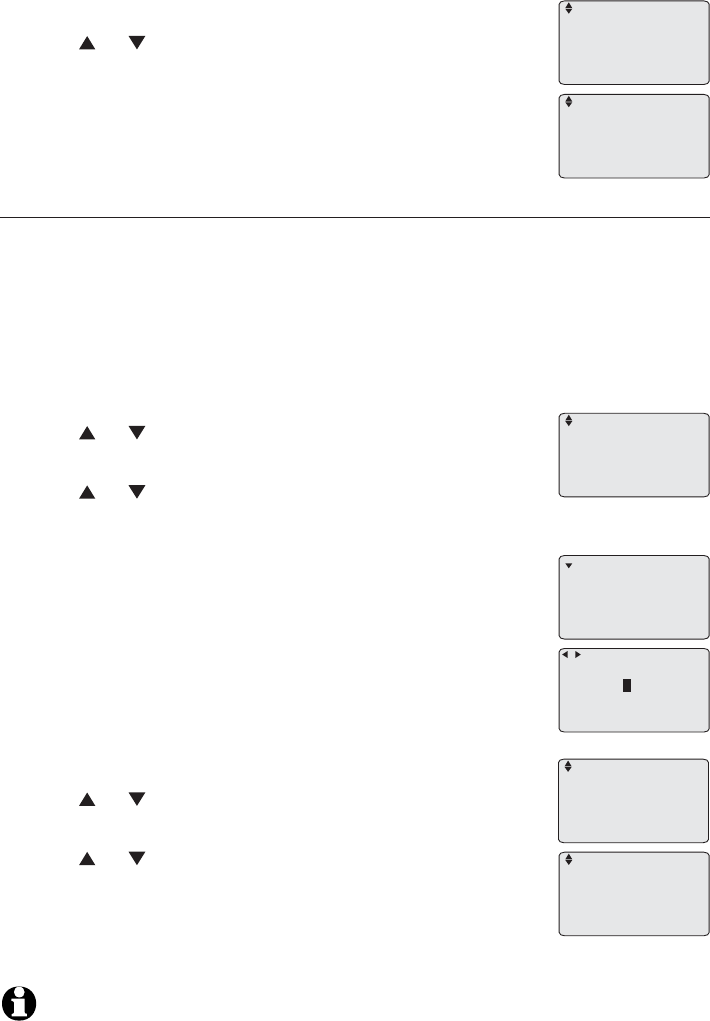
30
Getting started
Mailbox setup (for general mailbox)
Press MENU/ENTER.
Press or to highlight On or Off.
Press MENU/ENTER to save the setting and return to
the previous menu. There is a confirmation tone. To exit
without making changes, press EXIT.
4.
5.
Getting started
Mailbox setup (for general mailbox)
Notify alert
Call screening
:Off
Enter=Save
You can receive notification calls to your cell phone or paging device after
each new phone call message has been recorded to the general mailbox. You
can remotely access the message from a touch-tone telephone (see page
XX for instructions). To receive notification calls, you must save your phone
number on the telephone base, and then set the system to call that number
after it finishes recording a message.
When the telephone is idle, press MENU/ENTER.
Press or to scroll to Mailbox setup.
Press MENU/ENTER.
Press or to scroll to Notify alert. Press MENU/ENTER.
Set alert number
Press MENU/ENTER again to select Alert number. Use
the dial pad to enter the number (Up to 33 digits) of the
phone you want to be notified. Press REMOVE to delete
the last digit.
Press MENU/ENTER to save the setting and return to the
previous menu. There is a confirmation tone.
Press EXIT to exit setup without making changes.
Turn alert on or off
Press or to scroll to Alert on/off.
Press MENU/ENTER.
Press or to scroll to On or Off.
Press MENU/ENTER to save the setting and return to
the previous menu. There is a confirmation tone. To exit
without making changes, press EXIT.
NOTE: If you turn on Notify alert before you enter the Alert number, “Please set the alert
number” appears on the screen.
1.
2.
3.
1.
2.
1.
2.
3.
Set access code
Call screening
Notify alert
Remaining space
>
Alert number
Alert on/off
Alert call #.. #
>
Enter alert #:
2345678
Enter=Save
Alert number
Alert on/off
Alert call #.. #
>
Alert on/off
:On
Enter=Save
Call screening
:On
Enter=Save
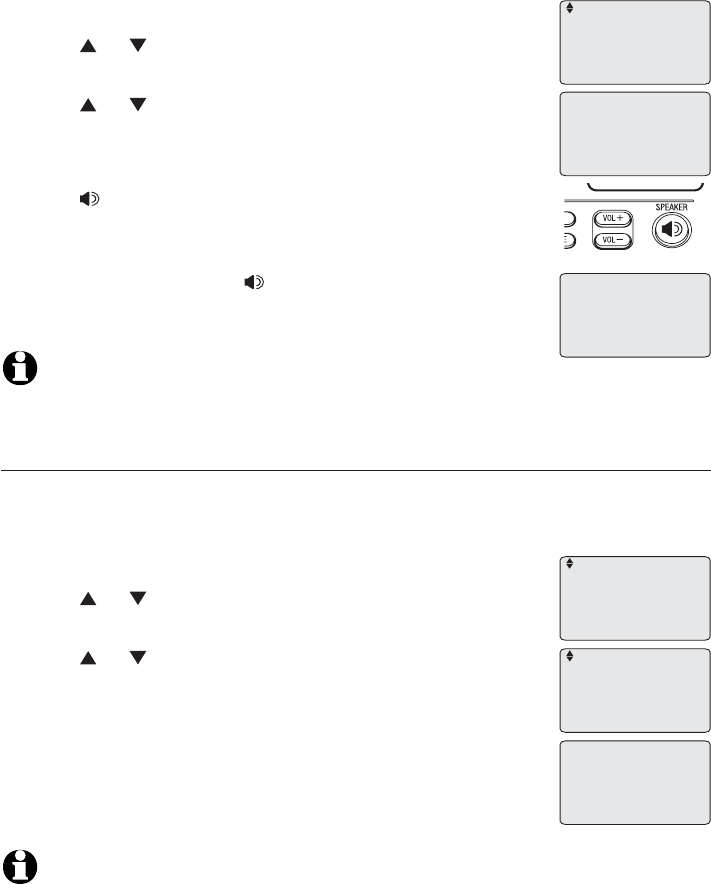
31
Getting started
Mailbox setup (for general mailbox)
Remaining space
You can check the current system space for an estimated further recording
time and number of messages.
When the telephone is idle, press MENU/ENTER.
Press or to scroll to Mailbox setup.
Press MENU/ENTER.
Press or to scroll to Remaining space.
Press MENU/ENTER.
After checking the screen display, press MENU/ENTER and
return to the previous menu. Press EXIT to exit setup
without making changes.
NOTE: The remaining recording time is an estimated data, it is because that the accuracy of
the particular remaining space depends on what is recorded.
1.
2.
3.
4.
Set access code
Call screening
Notify alert
Remaining space
>
Remaining space
Time: 191 min
Messages: 254
Confirm the alert call
You can confirm whether the system can successfully call the alert number
that you entered above.
When the telephone is idle, press MENU/ENTER.
Press or to scroll to Mailbox setup.
Press MENU/ENTER.
Press or to scroll to Alert call #..#.
Press MENU/ENTER.
The screen displays Press SPK to confirm the alert call.
Press SPEAKER on the telephone base. You should
hear the phone number being dialed.
After confirming that the call went to the phone number
you programmed, press SPEAKER again to end the
test. The idle screen appears.
NOTE: If the alert number fails to dial out, you hear silence from the base, and the called
phone does not ring.
1.
2.
3.
4.
5.
6.
Alert number
Alert on/off
Alert call #.. #
>
Press SPK
to confirm the
alert call
Alert call #.. #
Mailbox setup
Auto attendant
Anncement
>
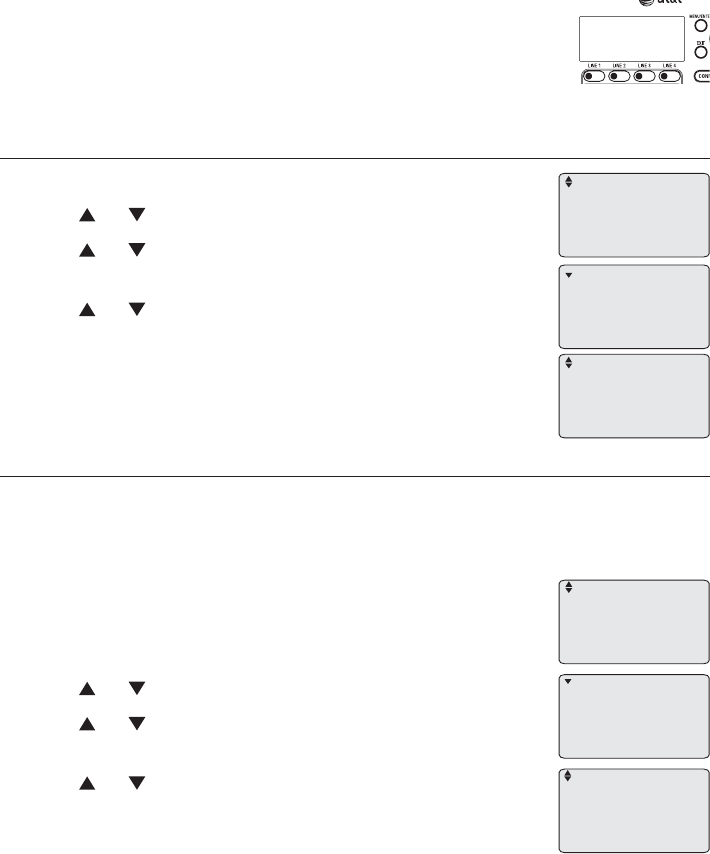
Getting started
COVM
32
You might have accessed your voice mail from a remote location (while away
from the phone). You might have received a false signal from your local
service provider. Use this feature to independently remove COVM indicator
display above a specific phone line button and reset COVM
condition for that line. You can reset COVM for all the
phone lines at a time using ALL COVM reset operation.
When the telephone is idle, press MENU/ENTER.
Press or to scroll to COVM. Press MENU/ENTER.
Press or to scroll to COVM reset. Press MENU/
ENTER.
Press or to scroll to COVM 1-4 reset to clear the
COVM indicator of a phone line, or highlight ALL COVM
to clear the indicators for all the lines at a time.
Press MENU/ENTER to save the setting and return to
the previous menu. There is a confirmation tone. To exit without making
changes, press EXIT.
1.
2.
3.
4.
5.
If you subscribe to voice mail service with your local telephone service
provider; turn the COVM (Central Office Voice Mail) on, COVM displays on
the screen above the line button when a specific phone line receives any
new voice mail message(s). If you do not subscribe to voice mail service or
want to temporarily disable the indicator, turn the COVM
off. If there are still messages waiting in the local telephone
service provider, the screen displays the COVM indicator
again when you turn this feature on, unless you set the
COVM reset on the telephone base.
COVM on/off
When the telephone is idle, press MENU/ENTER.
Press or to scroll to COVM. Press MENU/ENTER.
Press or to scroll to COVM on/off.
Press MENU/ENTER.
Press or to select On or Off.
Press MENU/ENTER to save the setting and return to
the previous menu. There is a confirmation tone. To exit
without making changes, press EXIT.
COVM reset
1.
2.
3.
4.
5.
COVM on/off
COVM reset
>
Ringer setting
Mailbox setup
Base setup
COVM
>
COVM
:On
Enter=Save
COVM on/off
COVM reset
>
COVM 1 reset
COVM 2 reset
COVM 3 reset
COVM 4 reset
>
COVM 2 reset
COVM 3 reset
COVM 4 reset
ALL COVM reset
>
*: Base
0 missed calls
2:43PM 1/13
COVM COVM

33
Getting started
COVM
NOTE: COVM reset feature only turns off the display indicator ; it does
not delete your voice mail message(s). If there acturally is a new voice
mail message, your local telephone service provider resends the signal
causing the indicator display for a specific phone line to appear on the
screen again.
COVM reset
*: Base
0 missed calls
2:43PM 1/13
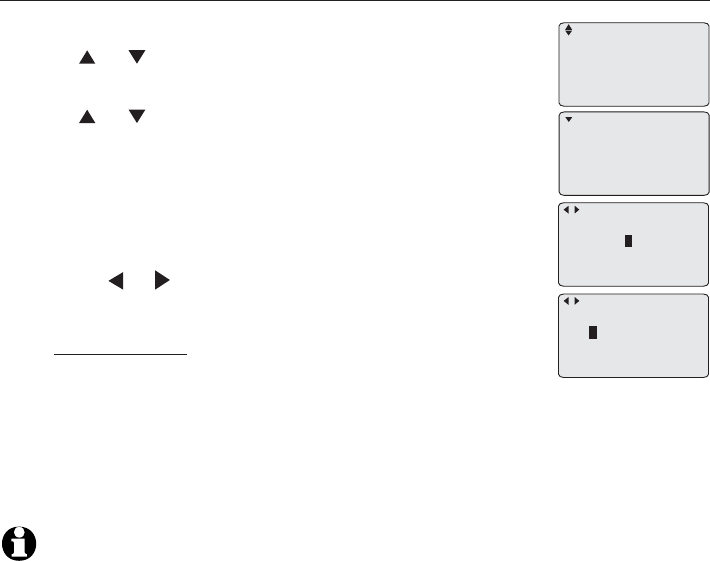
34
Getting started
Speed dial setup
The telephone base has ten speed dial locations where you can store the
phone numbers you wish to dial using fewer keys than usual. You can store
up to 32 digits in each location.
Enter, edit or delete a speed dial number
When the telephone is idle, press MENU/ENTER.
Press or to scroll to Speed dial setup. Press MENU/
ENTER.
Press or to choose the desired speed dial location
(>Speed dial x,x is the location number), then press
MENU/ENTER.
Use the dial pad to enter or edit the telephone number
up to 32 digits. If you want to delete the entry, erase all
the digits.
Press or to move the cursor to the left or right.
Press REMOVE to erase an digit.
Press and hold REMOVE to erase all the digits at a
time.
5. Press MENU/ENTER to save the setting and return to the previous menu.
There is a confirmation tone. To exit without making changes, press EXIT.
1.
2.
3.
4.
•
•
•
Mailbox setup
Base setup
COVM
Speed dial setup
>
Speed dial 1
Speed dial 2
Speed dial 3
Speed dial 4
>
Enter phone no.:
1234567
Enter=Save
Enter phone no.:
1234567
Enter=Save
NOTES:
1. The speed dial feature occupies up to ten of the hundred memory locations in the directory.
For example, if there are only five speed dial entries, then up to 95 entries can be stored in
the directory. If there are already 100 entries in the directory, no new directory and speed dial
entries can be stored in memory until some of the existing ones are deleted.
2. If you press a dial pad key which does not save a number, the screen displays No number.
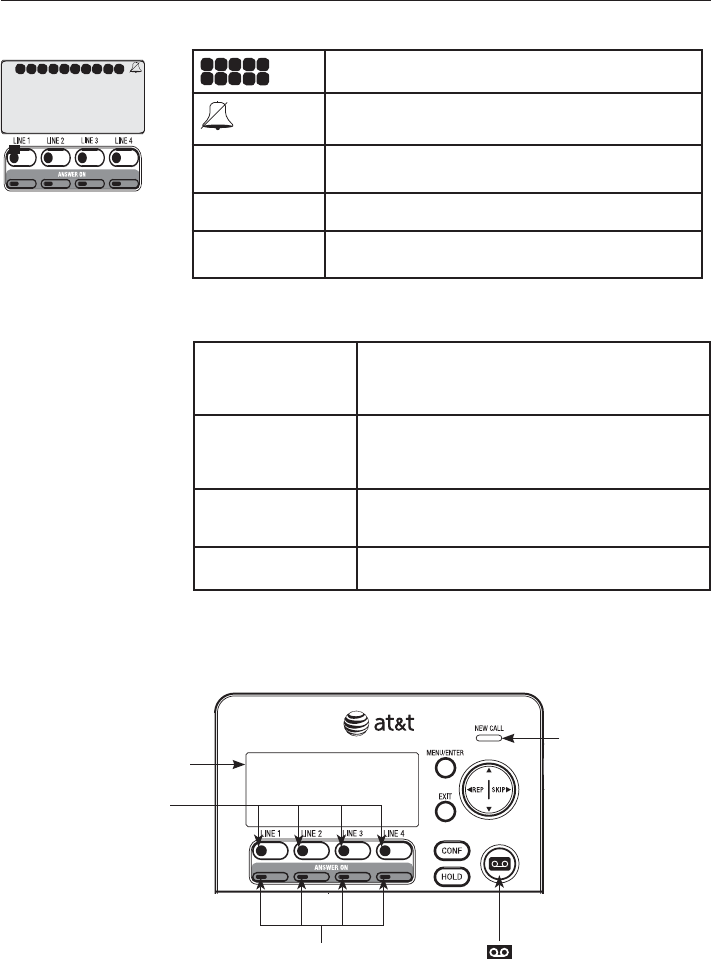
35
Getting started
Screen icons, indicator tones & lights
Screen icons & alert tones
Alert tones•
10
9
8
7
6
1 2 3 45On when line 1, line 2, line 3, or line 4 is in use.
Ringer off - the telephone base ringer is off.
-Mute Microphone is muted.
-Priv Call privacy is on.
COVM There are new voicemail (on a phone line LINE x
below the icon) from the local telephone provider.
Four quick beeps You are pressing the VOL+ or VOL- when
the volume is already at its highest or lowest
setting.
Double beeps A transferred call has not been answered within
every 30 seconds.
One short beep A call is put on hold for more than six minutes
and the Hold reminder is activated.
Confirmation tone Command completed successfully.
Lighted display
Screen icons•
L1
COVM COVM COVM COVM
-Priv
- Mute
Indicator lights•
NEW CALL
Flashes when
there are
unreviewed
calls.
Messages indicator
Flashes when there are
voicemail in the general
mailbox.
LINE key indicator
On green when a phone
line is in use.
Flashes slowly when a
phone line is on hold.
Flashes rapidly when
there is an incoming call.
ANSWER ON indicator
On red when the answering
system is on and ready to
receive calls.
10
9
8
7
6
12345
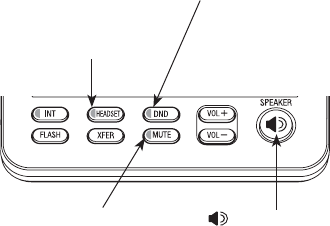
36
Getting started
Screen icons, indicator tones & lights
SPEAKER indicator
On when the speakerphone
is on.
MUTE indicator
On when the microphone
or ringer is turned off.
DND indicator
On when the Do Not Disturb
function is on.
HEADSET indicator
On when the corded
headset is in use.
Indicator lights•
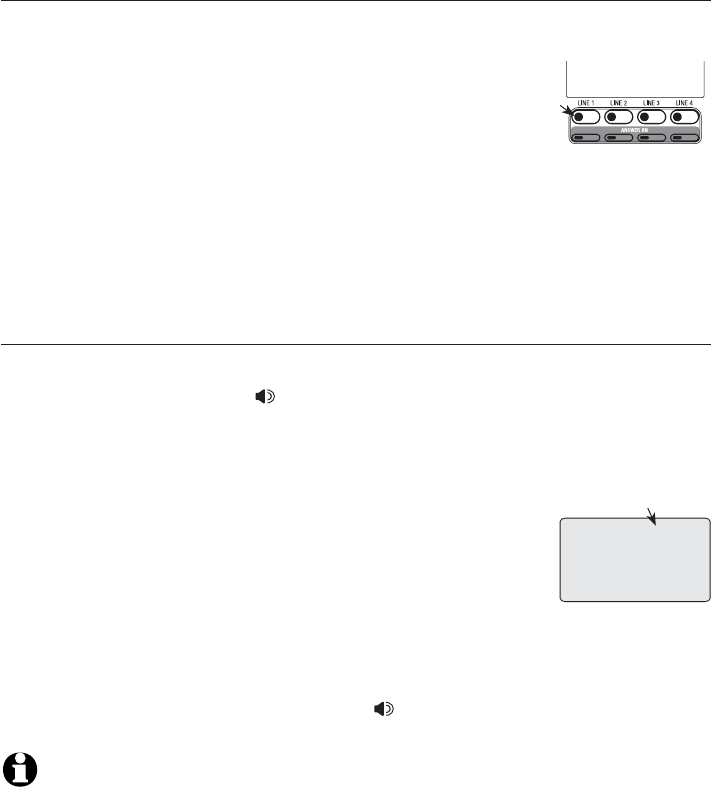
Telephone base operation
Telephone base basic operation
37
The phone comes programmed to use line 1 (default primary line) for calls
when you do not press a line key. (To change the primary line, see
Line Selection on page X of the installation guide.) When you answer a call,
the phone automatically selects the ringing line.
Lit line indicators
The four indicators on the LINE keys indicate the state of the corresponding
phone line.
The four LINE indicator lights are green:
On when the corresponding line is in use.
Flashes slowly when the line is on hold.
Flashes rapidly when there is an incoming call on the corresponding line.
Flashes rapidly when there is a transferred call on the corresponding line.
Flashes rapidly when there is an incoming auto attendant transferred call
on the corresponding line.
Making a call
To make a call:
Lift the handset or press SPEAKER.
-OR-
To override automatic line selection, press the LINE (1-4) key for the
desired line, then lift the handset.
2. Wait for a dial tone, then enter the telephone number
and the screen displays the elapsed time as you talk (in
hours, minutes and seconds).
To end a call:
Place the handset on the telephone base to hang up.
-OR-
If you are using speaker phone, press SPEAKER to hang up.
NOTE: The elapsed time is not affected by accessing services from your local telephone service
provider.
•
•
•
•
•
•
1.
•
On
Line 1 00:00:27
1234567
Elapsed time
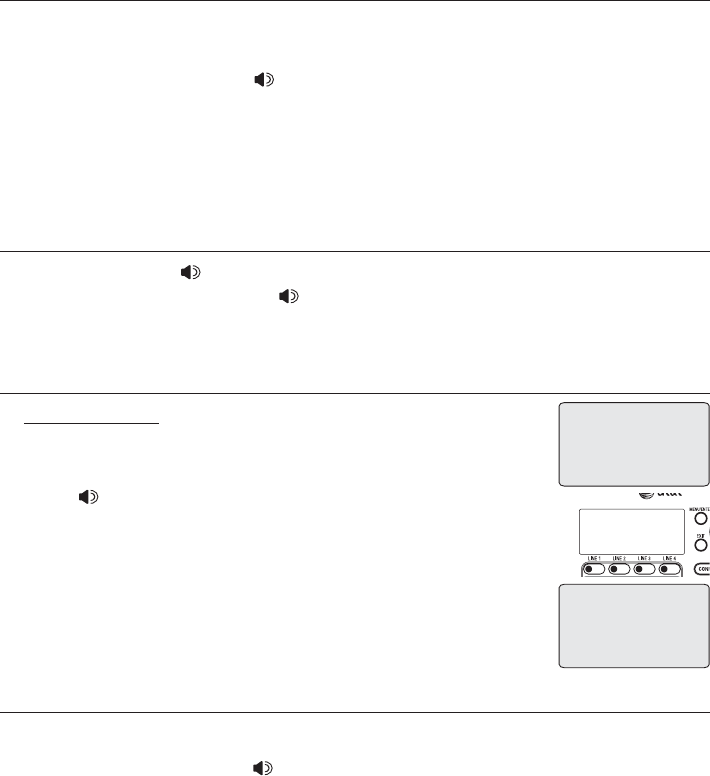
Telephone base operation
Telephone base basic operation
38
On-hook dialing (predialing)
Enter the telephone number. Press REMOVE to make corrections when
entering the phone number.
Lift the handset or press SPEAKER to dial.
-OR-
To override automatic line selection, press the LINE (1-4) key for the
desired line, then lift the handset.
Telephone base speakerphone
During a call, press SPEAKER to switch between hands-free speakerphone
and nomal handset use. Press SPEAKER again or place the handset on
the telephone base to hang up.
Calling a speed dial number
Press and hold a dial pad key (0-9) to display the
number. The dial pad key 0 represents for the tenth
speed dial number.
Press SPEAKER or lift the handset.
-OR-
To override automatic line selection, press the LINE (1-4)
key for the desired line, then lift the handset.
Answering a call
To answer a call
Lift the handset or press SPEAKER .
-OR-
To override automatic line selection, press the LINE (1-4) key for the de-
sired line, then lift the handset.
-OR-
Press any dial pad key (0-9, * or #)
1.
2.
1.
2.
•
•
•
Line 3
1234567
Speed dial 3
1234567
Enter=Save
Speed dial 3
No number
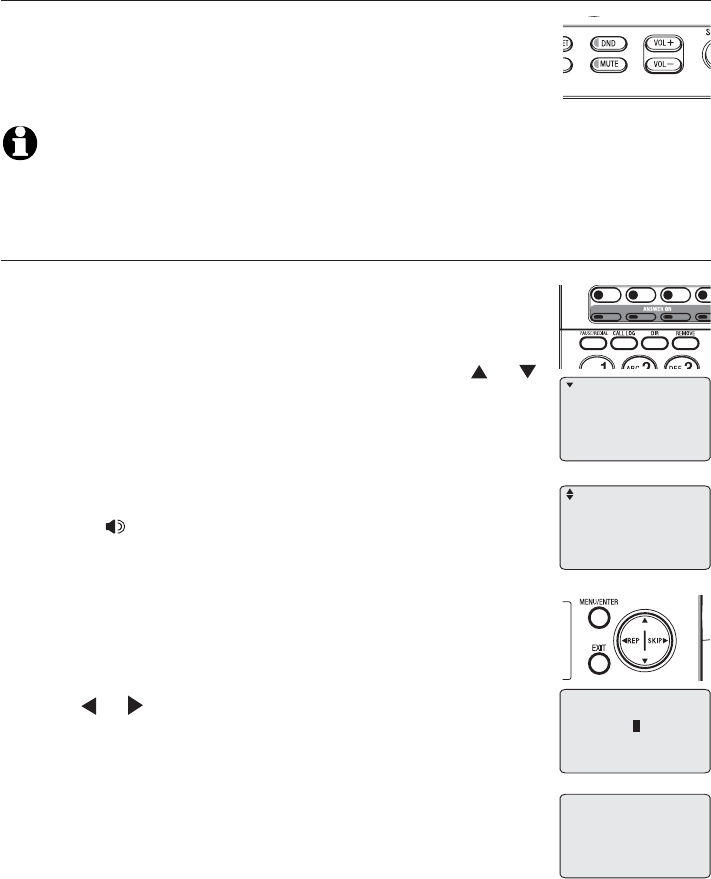
Telephone base operation
Telephone base basic operation
39
Temporary ringer silencing
Press MUTE while the telephone is ringing to silence the
ringer temporarily on the telephone base only. This turns off
the ringer without disconnecting the call. The next incoming
call rings normally at the preset volume
NOTE: You do not hear a ringer if you turn off the ringer tone. (See Turn on/off ringer tone on
page X).
Last number redialing
To view the ten most recently dialed numbers
To display the most recently called numbers (up to 30
digits), press PAUSE/REDIAL.
To view up to ten recently called numbers, press or ,
or PAUSE/REDIAL repeatedly
Press EXIT to exit.
To redial a number
To dial the displayed number, lift the handset
or press SPEAKER.
To override automatic line selection, press the LINE (1-4)
key for the desired line, then lift the handset.
To edit a number
While the desired number displays, press MENU/ENTER to
enter editing mode.
Press or to move the cursor to the left or right.
Press REMOVE to erase digits.
To delete a number
While the screen displays the desired number, press
REMOVE to delete the number from the redial memory.
•
•
•
•
•
•
•
1234567
LINE 1
1234567
1234567
Deleted
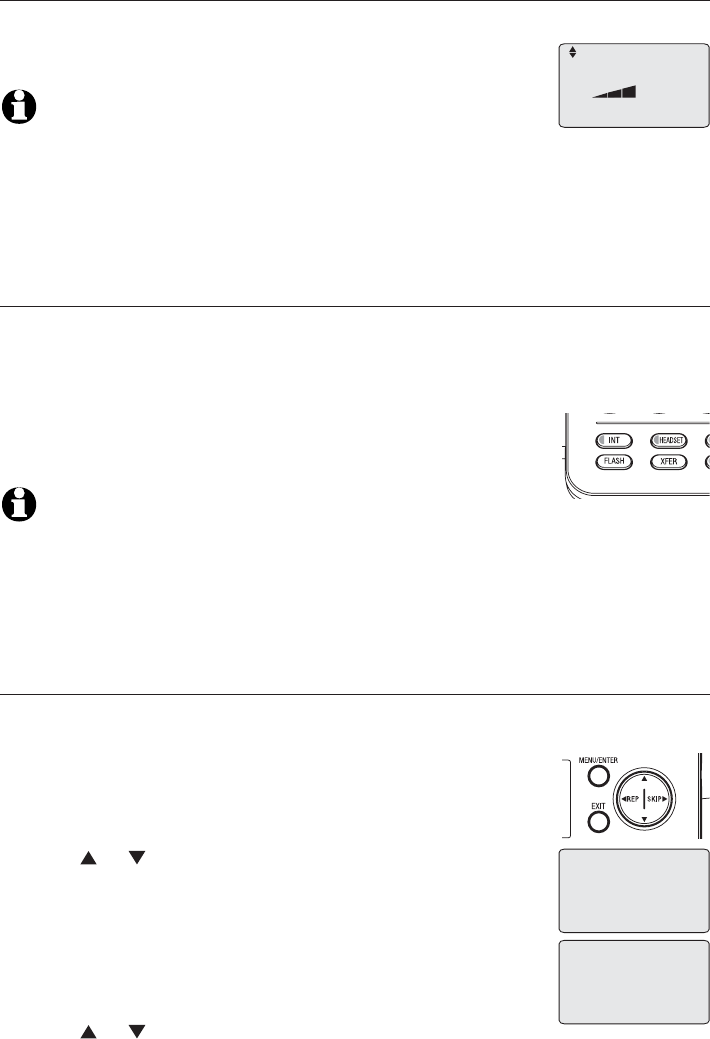
40
Telephone base operation
Options while on calls
Volume control
While on a call, press VOL+ or VOL- to increase or decrease the listening
volume.
NOTES:
1. The corded headset and base handset volume settings are the same, but they have independent
volume settings from the speakerphone volume settings.
2. While using the volume control, you will hear a triple beep when you’ve reached the minimum
or maximum level.
Call waiting
If you subscribe to call waiting service with your local telephone service
provider, you hear a beep if someone calls while you are already on a call.
Press FLASH to put your current call on hold and take the new call.
Press FLASH at any time to switch back and forth be-
tween calls.
NOTES:
1. If you miss a call-waiting call, the caller ID of the missed call displays for 15 seconds after the
current call.
2. For more information on caller ID with call waiting, see page XX.
Call privacy
You can control call privacy. To ensure call privacy, this phone allows only
one set at a time to use a line.
To enable call privacy
During the call, press MENU/ENTER.
Press or to scroll toto scroll to Privacy on. Press MENU/ENTER.
The screen displays -Priv. The other phones cannot join
the call and the other phones drop from the call.
To cancel call privacy
During the call, press MENU/ENTER.
Press or to scroll toto scroll to Privacy off. Press MENU/EN-
•
•
•
•
•
•
•
Volume
Privacy on
Record call on
>
Line 1 00:00:06
-Priv
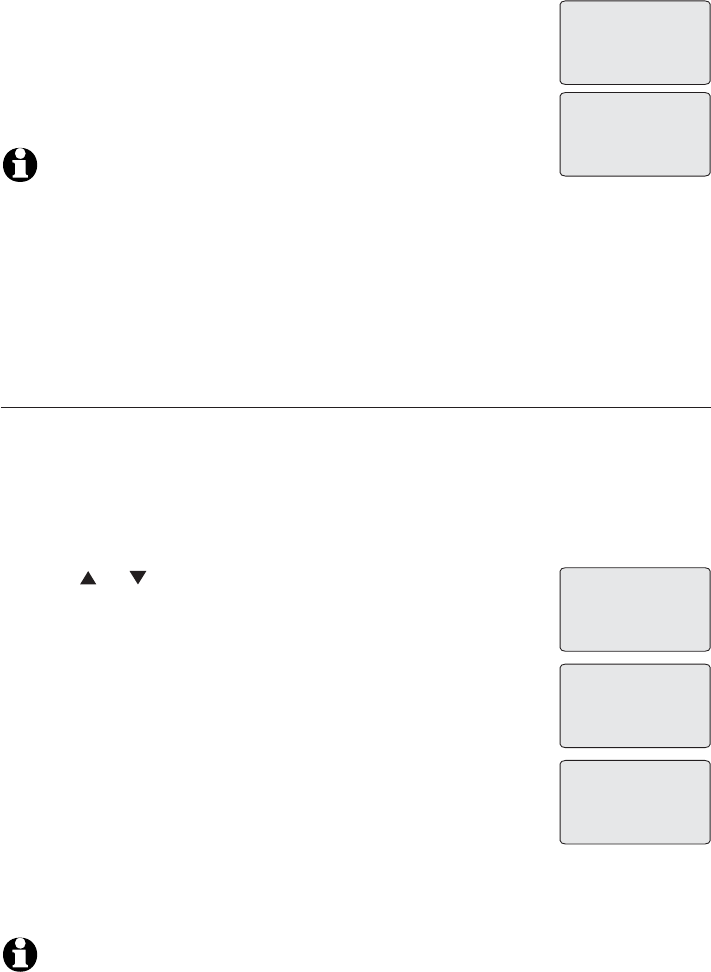
41
Telephone base operation
Options while on calls
TER to exit the call privacy mode and continue with the
conversation.
The icon -Priv disappears from the screen. Others can
now join the call by pressing the appropriate line key.
NOTES:
1. Call privacy is automatically restored when you end a call.
2. You can not set call privacy during intercom or conference calls.
3. Call privacy setting does not work for a transferred call.
2. When a non-system phone answers a call, any other system phone can pick up the call by
pressing the LINE (1-4) keys. Once a system phone picks up the call, call privacy is activated
and no other system phones can listen to the call unless call privacy is cancelled, but non-sys-
tem phones that share that line can still join the call.
Two-way conversation recording
During an outside call, you can record the conversation as a private message
in the general mailbox memory. It is saved, played back and deleted exactly
like private incoming messages.
To record a two-way conversation
During the call, press MENU/ENTER.
Press or to scroll toto scroll to Record call on.
Press MENU/ENTER.
The screen displays -Rec, and the elapsed time while
recording. Two-way conversations shorter than three
seconds are not recorded.
The recording ends if you disconnect the call.
-OR-
Press MENU/ENTER, then select Record call off to exit the
recording mode and continue with the conversation.
To play back a two-way conversation
Two-way conversations are stored as private messages. See Private
message playback on page X for instructions on playback and deletion.
NOTES:
1. Call privacy is automatically on during a two-way conversation recording.
2. You can not set two-way conversation recording during intercom or conference calls.
•
•
1.
2.
3.
4.
•
Privacy off
Record call on
>
Line 1 00:10:06
Privacy off
Record call on
>
Line 1 00:00:06
-Priv -Rec
Record call off
>
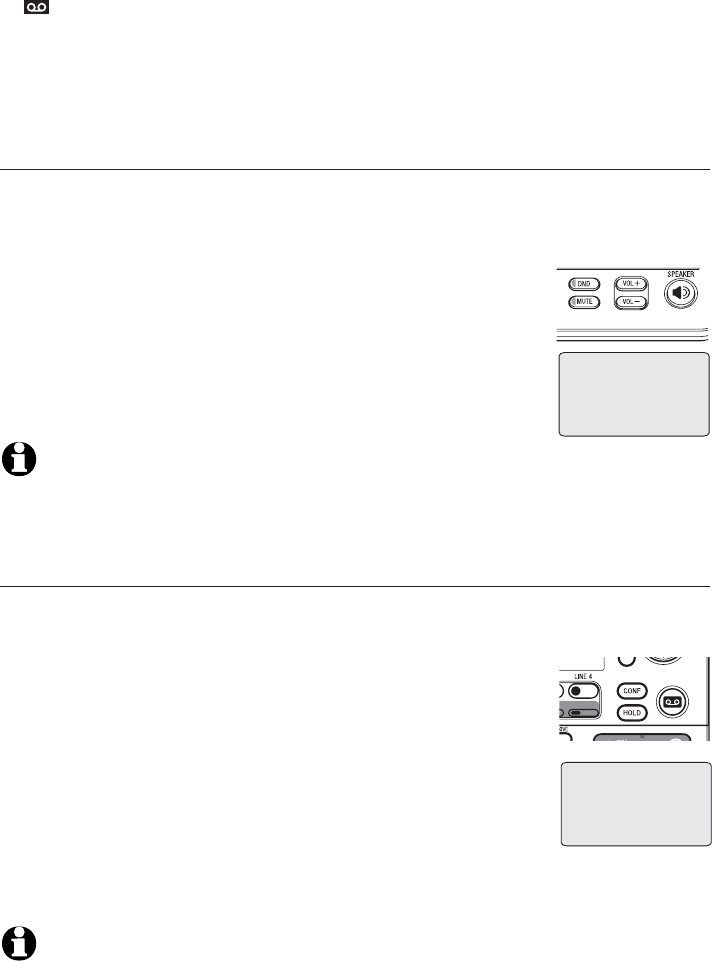
42
Telephone base operation
Options while on calls
3. Messages indicator does not flash for new and unreviewed two-way conversation record-
ing.
4. This phone does not have warning beeps to inform the other party that the call is being
recorded. To ensure that you are in compliance with any federal or state regulations regarding
recording a telephone call, you should start the recording process and then inform the other
party that you are recording the call.
MUTE
You can use the mute function during a telephone conversation to silence
the microphone. You can hear the caller, but the caller does not hear you.
To mute a call:
Press MUTE. When mute is on, the MUTE light blinks, the
screen shows -Mute and the -Mute appears until you
turn off mute.
To un-mute a call:
Press MUTE again and resume speaking.
NOTE: Switching from handset to speakerphone or corded headset,
or from speakerphone or corded headset to handset, changing lines, or putting a call on
hold also cancels the mute function.
HOLD
You can use this feature to hold one line while accessing another, or as part
of the conference and call transfer features.
While on a call, press and release HOLD. The LINE indicator
for the line on hold flashes slowly in green, and a double-
beep sounds every 30 seconds to remind you that the call
is on hold. (To turn off the reminder beep, see
Hold reminder on page X.)
If you are using the base handset, you can place the
handset in the telephone base without disconnecting the
call. If you are using the speakerphone, the speakerphone
turns off automatically when you press HOLD.
To release the hold, press and release the LINE key of the call on hold.
NOTES:
1. The phone automatically disconnects a call on hold after 20 minutes. To keep a call on hold
longer than 20 minutes, release hold within 20 minutes and then place the call on hold again.
2. If a call is on hold for 3 minutes, a warning tone sounds every 30 seconds.
•
•
Hold Line 1
Line 1 00:05:40
1234567
-Mute
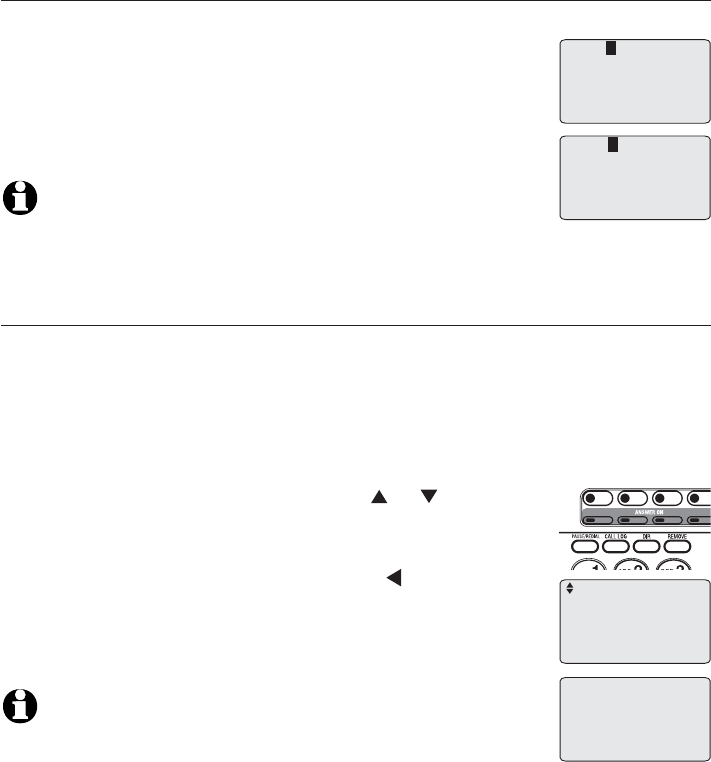
43
Telephone base operation
Options while on calls
3. If there is an incoming call while the line is on hold, the screen alternatively displays On hold
and Incoming call.
4. You cannot put an intercom call on hold.
5. If a line is in use, pressing INT places the line on hold and activates the intercom (pageX).
Join in
You can join in an ongoing call on another extension handset when the call
privacy is not set on that handset. The corresponding line
icon (page X) displays on the screen when the line is in use.
Press the desired LINE (1-4) key on the telephone base
to join in the call.
NOTE: When you try to join in the ongoing call on the handset with
call privacy on, the screen displays Privacy and you hear quick beep
tones.
Chain dialing
You can initiate a dialing sequence from the numbers in the directory while
you are on a call.
Chain dialing can be useful if you wish to access other numbers (such as
bank account information or access codes) from the directory.
To access the directory while on a call:
During the call, press DIR, then press or to reviewto reviewreview
the directory.
To dial the displayed number, press MENU/ENTER. To exit
without making changes, press EXIT or and continueand continue
with the conversation.
NOTE: You cannot edit a directory entry while on a call. For more
details about the directory, see page X.
•
•
1.
2.
Privacy
1
Conf. 00:00:29
L3 H2
1
BANK
123456789
Enter=Call
Line 1 00:16:30
1234567123456789
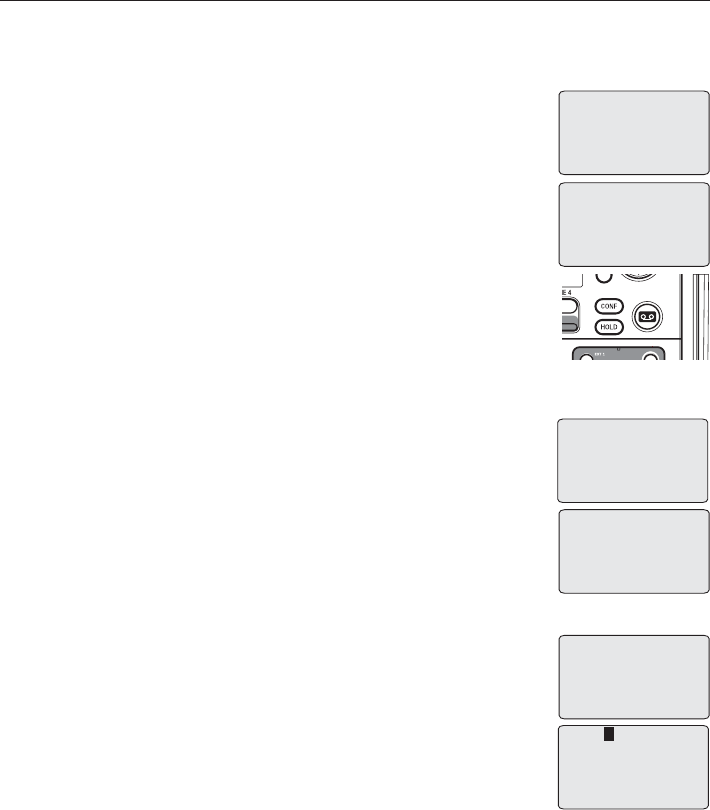
44
Telephone base operation
Options while on calls
Three-way conference calls
You can set up a three-party call by using two lines at the same time. You
can also join an intercom call with a call on an outside line. The outside line
call must be established first, because an intercom call cannot be placed on
hold.
Make or answer an outside call.
Press HOLD and call someone on another line, or start
an intercom connection.
-OR-
Call someone on another line, or intercom someone and
the line is put on hold automatically.
3. When this call is answered, press CONF. The three-party
conference begins immediately.
To talk privately with one external party (two-line conference only):
Press HOLD to place both lines on hold.
Press a LINE key to talk privately with the person on
that line.
Press Conf to resume the conference call.
To talk privately with one internal party (two-line conference only):
Press INT to talk privately with the person on
that handset and place the external line on hold
automatically.
Press Conf to resume the conference call.
To drop one line:
Press the LINE key for the party you want to keep. The other line is
dropped.
To drop an intercom:
Press the LINE key to activate the external call. The intercom call drops
automatically.
1.
2.
•
1.
2.
3.
•
1.
2.
•
•
Hold Line 1
Line 3 00:15:25
1234567
Hold Line 1
Hold L1 L3
Line 3 00:18:30
Hold Line 1
Calling
1:Handset 1
Hold Line 1
Intercom 00:20:30
Hold L1 L3
1
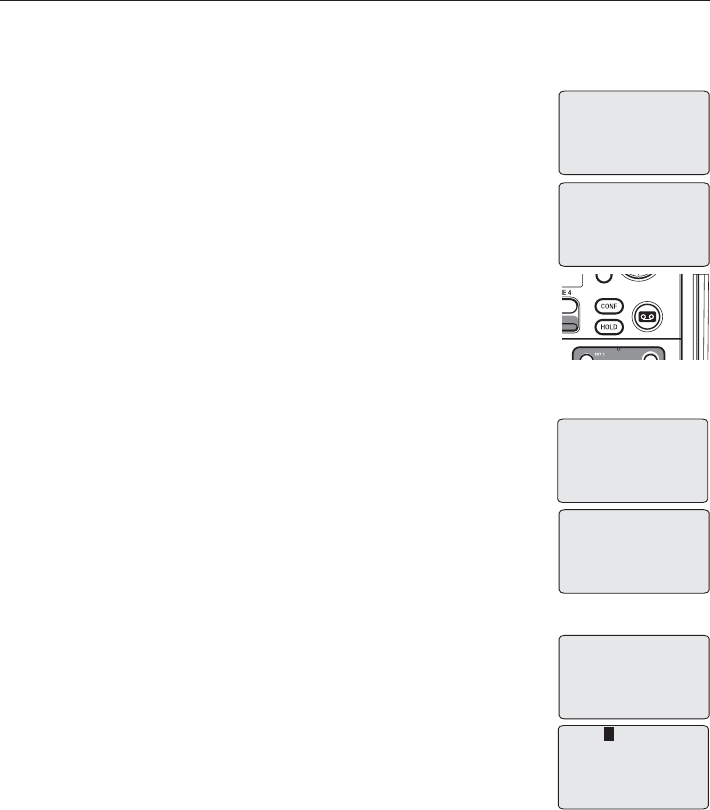
44
Telephone base operation
Options while on calls
Three-way conference calls
You can set up a three-party call by using two lines at the same time. You
can also join an intercom call with a call on an outside line. The outside line
call must be established first, because an intercom call cannot be placed on
hold.
Make or answer an outside call.
Press HOLD and call someone on another line, or start
an intercom connection.
-OR-
Call someone on another line, or intercom someone and
the line is put on hold automatically.
3. When this call is answered, press CONF. The three-party
conference begins immediately.
To talk privately with one external party (two-line conference only):
Press HOLD to place both lines on hold.
Press a LINE key to talk privately with the person on
that line.
Press Conf to resume the conference call.
To talk privately with one internal party (two-line conference only):
Press INT to talk privately with the person on
that handset and place the external line on hold
automatically.
Press Conf to resume the conference call.
To drop one line:
Press the LINE key for the party you want to keep. The other line is
dropped.
To drop an intercom:
Press the LINE key to activate the external call. The intercom call drops
automatically.
1.
2.
•
1.
2.
3.
•
1.
2.
•
•
Hold Line 1
Line 3 00:15:25
1234567
Hold Line 1
Hold L1 L3
Line 3 00:18:30
Hold Line 1
Calling
1:Handset 1
Hold Line 1
Intercom 00:20:30
Hold L1 L3
1

45
Telephone base operation
Options while on calls
To end a conference call:
Place the handset on the telephone base to hang up. All parties will be
disconnected.
NOTES:
1. An internal party can put the conference call on hold.
2. An internal party hangs up, and the ongoing call becomes a two-way conversation.
3. Occasionally, the far-end parties on a conference call might not hear one another.
4. If you are experiencing difficulty in using the conference features on this phone, please con-
sider using AT&T’s complete line of teleconference servicesto find a solution that best meets
your needs. AT&T TeleConference Services reduces travel time and expense while increas-
ing productivity wherever people are located, enabling you to host truly virtual meetings and
share important information in real time. To sign up for AT&T TeleConference Services, go to :
www.att.com/orderconference for details.
•
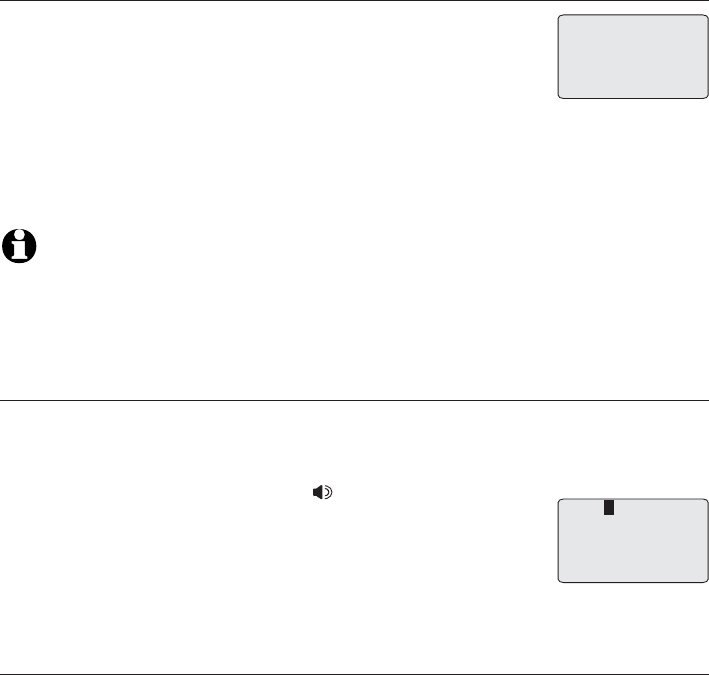
46
Telephone base operation
Intercom
A telephone base connected with normal AC power but not with any tele-
phone lines plugged in can still intercom with charged and registered acces-
sory cordless handsets.
When the system is making one or more external calls, the other registered
cordless handsets (and cordless headset) can make intercom calls with each
other. An intercom call can proceed between the telephone base and an
accessory cordless handset at any given time, or between two registered
accessory cordless handsets (or one of the two accessory unit is a registered
cordless headset).
Make an intercom call with the cordless handset
Press the one-touch key for the destination party, then
lift the handset. The screen displays
Calling X: Handset X (X represents the extension and
handset number).
If the extension you are calling is idle or set to Do Not Disturb (DND) , you
hear long beeps. If the other extension is on a call, you hear a busy signal.
NOTES:
1. Before the destination party answers the intercom call, press the corresponding LINE (1-4) key to
resume the call.
2. The intercom call automatically cancels if the destination party does not answer it for 1 minute.
Answer an intercom call
You can answer an intercom call. When you receive an intercom call,
you hear a ringing tone and your screen displays Call: X Handset X (X
represents the extension and handset number). Answer the intercom call by
lifting the handset, or by pressing SPEAKER or HEADSET
to take the call hands-free.
End an intercom call
Put the handset on the telephone base or press HEADSET again to hang
up.
•
•
Calling
1:Handset 1
Intercom 00:00:05
1

47
Telephone base operation
Intercom
Make another intercom call while on an intercom call
You can make an intercom call to another destination extension while on
an intercom call. The first intercom automatically disconnects. While on an
intercom call:
Press the one-touch key for another destination party. The screen displays
Calling X: Handset X (X represents the extension and handset number).
If the extension you are calling is idle or set to Do Not Disturb (DND) , you
hear long beeps. If the other extension is on a call, you hear a busy signal.
NOTES:
1. Before the destination party answers the intercom call, press the corresponding LINE (1-4) key to
resume the call.
2. The intercom call automatically cancels if the destination party does not answer it for 1 minute.
•
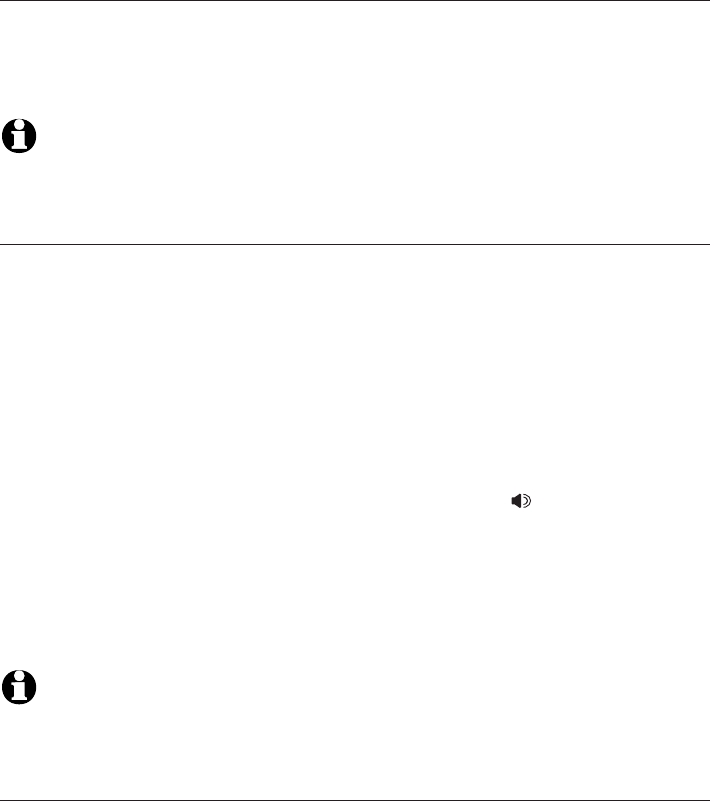
48
Telephone base operation
Call transfer
Transfer a call
You can transfer a call to any other system phone. Once you transfer a call,
it can be picked up at any other system phone, not just at the extension you
called.
NOTE: WIf a transferred call is not picked up within 20 minutes, the phone automatically
disconnects the call.
Blind transfer
You can make a blind transfer. While on a call:
Press XFER. The outside call is automatically put on hold. Transfer LINE X
to appears on the screen display.
Press the one-touch key for the destination extension.
-OR-
Dial the destination extension number to which you are transferring the
call. The extension number appears on the fourth line of the display.
3. Put the base handset on the telephone base or press SPEAKER to hang
up.
Your phone reminds you with a double-beep every 30 seconds when a
transferred call has not been answered. (To turn off the reminder beep, see
Hold reminder on page X).
NOTE: If you do not dial an extension within 10 seconds, the transfer automatically cancels.
The call is still on hold. Press the corresponding LINE (1-4) key to resume the call.
Transfer a call and speak to the receiving party
You can transfer a call and speak to the receiving party. While on a call:
Press INT. The outside call is automatically put on hold and INTERCOM TO
displays followed by the destination extension number.
Press the one-touch key for the destination extension to which you are
transferring the call.
-OR-
Dial the destination extension number to which you are transferring the
1.
2.
1.
2.

49
Telephone base operation
Call transfer
call. The extension number appears on the fourth line of the display.
3. When the other party answers by pressing INT, you can announce the call.
4. Press XFER.
5. Put the base handset on the telephone base or press SPEAKER to hang
up.
NOTE: If you do not dial an extension number within 10 seconds, the transfer automatically
cancels. The call is still on hold. Press the corresponding LINE key to resume the call.
Answer a transferred call
When you hear a long transfer ring, pick up the handset or press the LINE
key of the call to use the speakerphone or headset.
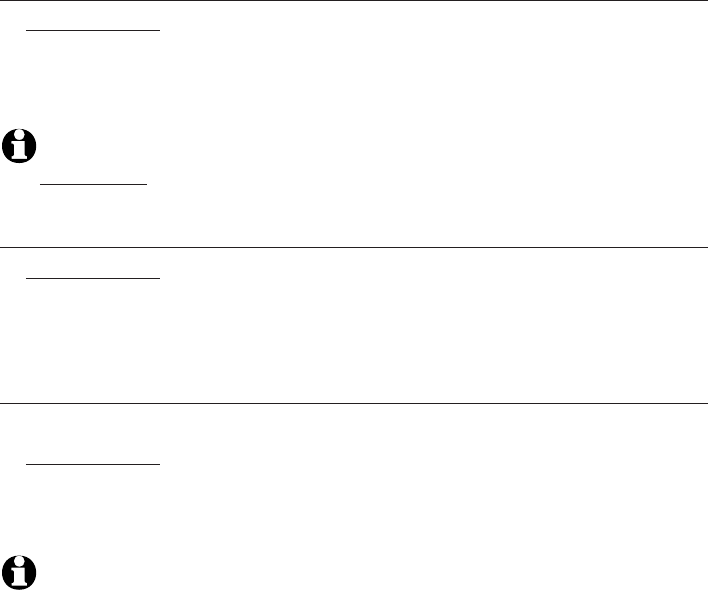
50
Telephone base operation
Push to talk (PTT)
You can directly send your voice to the speaker of the registered and in idle
mode extension handset(s). The extension you called can respond just by talk-
ing while pressing the PTT key on the cordless handset. -
PTT to an handset
Press and hold the one-touch key EXT 1-0 for the destination party while
speaking into the base speakerphone.
Release the one-touch key EXT 1-0 after speaking.
NOTE: The speakerphone on the destination telephone is activated automatically when you
press and hold the one-touch key.
PTT to all handsets
Press and hold the one-touch key INT/PTT ALL for all the extension hand-
sets while speaking into the base speakerphone.
Release the one-touch key INT/PTT ALL after speaking.
Answer a PTT call
The screen displays Push2TalkIncoming and the caller extension number.
Press and hold the one-touch key for the extension number while speaking
into the base speakerphone.
NOTES:
1. If the destination telephone is in the Do Not Disturb mode, on an intercom call or on an outside
call, your telephone sounds a busy signal.
2. If the destination telephone is a non-registered handset, the screen displays InvalidMailbox.
•
•
•
•
•
•

51
Directory
About the directory
Capacity
The directory of this telephone base can store up to 100 entries, with a
maximum of 16 alphanumeric characters (including spaces) for names and
32 digits for telephone numbers. A convenient search feature can help you
quickly find and dial numbers (page X).
If there are already 100 entries, the screen shows LIST FULL. You cannot
store a new number until you delete one. If you try to view the directory
entries when there are no entries, the screen displays Directory empty.
Exit the directory
Press EXIT to cancel an operation and return to the idle mode.
If you pause for too long while creating or reviewing an entry, the procedure
times out and you have to begin again.
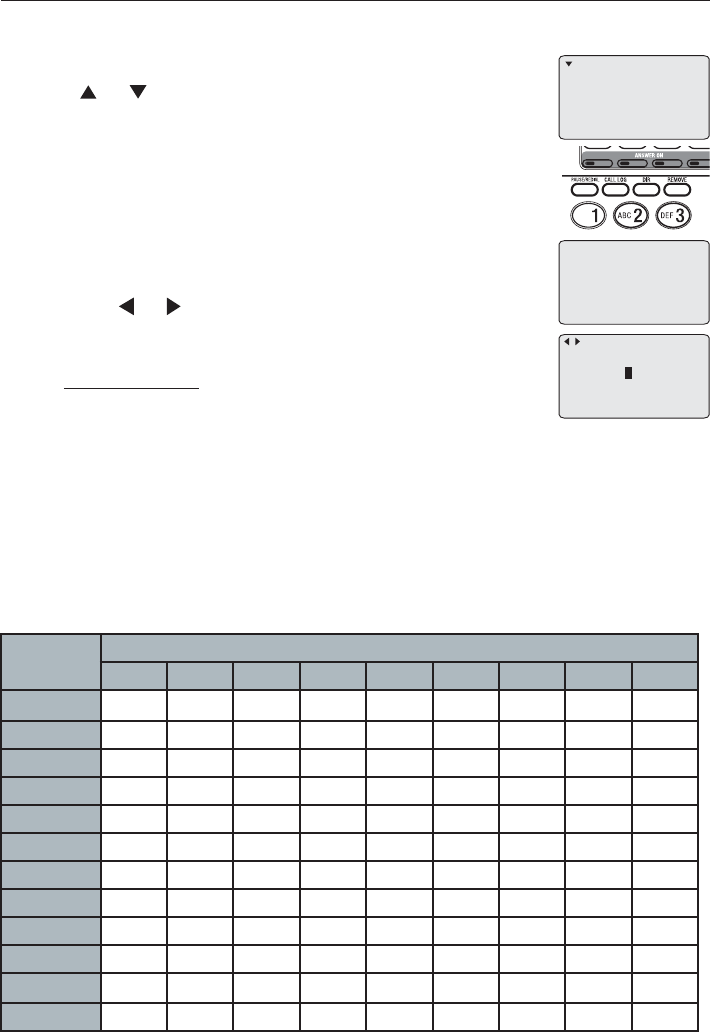
52
Directory
Create directory entries
Number
key
Characters by number of key presses
123456789
11# ‘ , - . &
2ABC2abc
3DEF3de f
4GH I 4g h i
5JKL5 j k l
6MNO6mn o
7PQRS 7p q r s
8TUV8 t uv
9WX Y Z 9w x y z
00
**?!/()@
#space
Create a new directory entry
You can use the following steps to store a name and number in the directory.
When the telephone is idle, press MENU/ENTER.
Press or to scroll to Directory. Press MENU/ENTER.
-OR-
When the telephone is idle, press DIR.
3. Press MENU/ENTER to add an entry.
4. Enter the telephone number when prompted.
Use the dial pad to enter up to 32 digits.
- Press or to move the cursor to the left or right.
- Press REMOVE to erase digits.
- Press and hold REMOVE to erase all digits.
- Press REDIAL/PAUSE to enter a three-second dialing
pause (a P appears).
5. Press MENU/ENTER to enter the name when prompted.
Use the dial pad to enter a name (up to 16 characters). Each time you
press a key, the character on that key appears. Additional key presses
produce other characters on that key. See the chart below.
1.
2.
•
•
Directory
Call log
Ringer setting
Mailbox setup
>
Directory empty
Enter=Add
Enter phone no.:
1234567
Enter=Next

53
Directory
Create directory entries
- Press or to move the cursor to the left or right.
- Press REMOVE to erase characters.
- Press and hold REMOVE to erase all characters.
- Press # to add a space.
6. Press MENU/ENTER to store your new directory entry.
There is a confirmation tone. The name and the tele-
phone number appear. You cannot save the same number
twice. To exit without making changes, press EXIT.
Enter name.:
AT&T
Enter=Save
AT&T
1234567
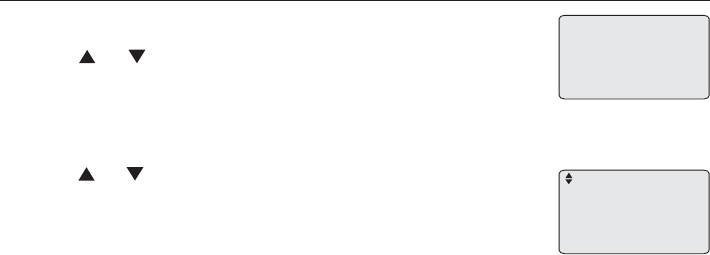
54
Directory
Review directory
Review directory entries
When the telephone is idle, press MENU/ENTER.
Press or to scroll to Directory. Press MENU/ENTER.
-OR-
When the telephone is idle, press DIR.
3. Press or to browse through the directory. Entries
appear alphabetically by the first letter in the name.
Directory empty appears if there are no directory entries.
1.
2.
AT&T
1234567
Directory
4 items
Enter=Add
Rem.=Delete all
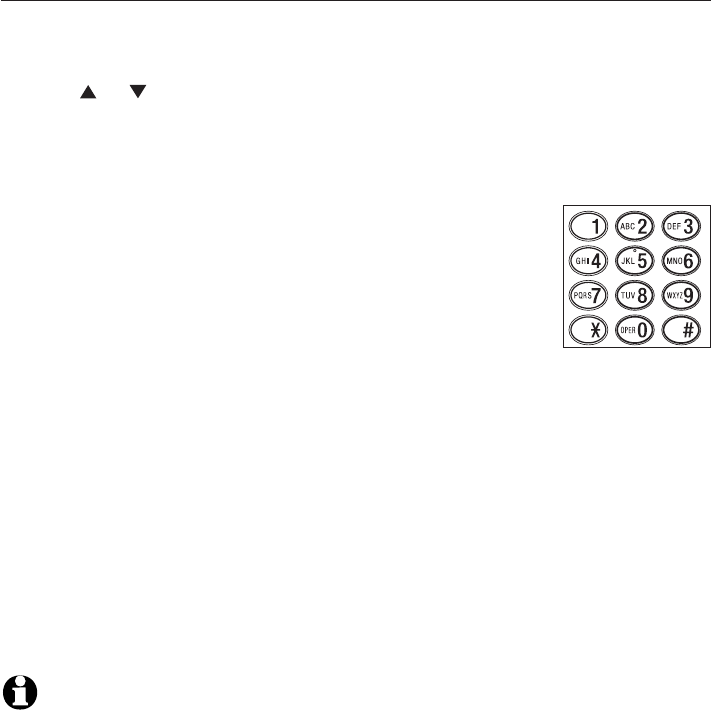
55
Directory
Search directory
Search by name
Follow the steps below to search for directory entries on the telephone base.
When the telephone is idle, press MENU/ENTER.
Press or to scroll to Directory. Press MENU/ENTER.
-OR-
When the telephone is idle, press DIR.
3. When a name entry appears, press the dial pad keys (2-9)
to start a name search.
The directory shows the first name beginning with the
first letter associated with the dial pad key if there is an
entry in the directory beginning with that letter.
4. To see other names starting with the letters on the same dial pad key, keep
pressing the key. The names appear in alphabetical order.
For example, if you have the names Jennifer,Jessie,Kevin and Linda in
your directory:
If you press 5 (JKL) once, you see Jennifer.
If you press 5 (JKL) twice, you see Jessie.
If you press 5 (JKL) three times, you see Kevin.
If you press 5 (JKL) four times, you see Linda.
If you press 5 (JKL) five times, you see Jennifer.
NOTES:
1. If there are no names matching the first letter of the key you press, the directory shows the
name(s) matching the subsequent letters of the key.
2. If you press a key (2-9) and no name starts with the letters on that key, the directory shows the
entry matching the next letter in the directory.
1.
2.
•
•
•
•
•
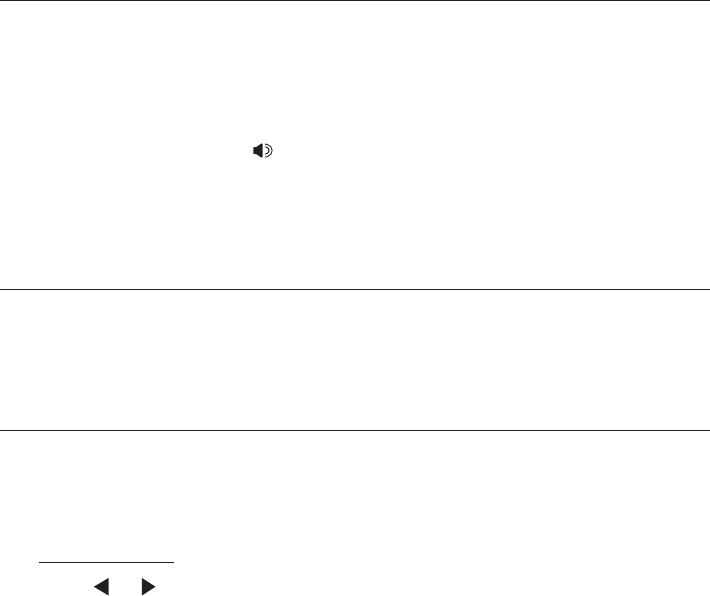
56
Directory
Dial, delete or edit entries
You can dial, delete or edit a directory entry (name and number), the entry
must be shown on the telephone base screen. You can use the directory
review or search (pages X-X) to show an entry.
Display dial
You can dial a displayed number from the directory,
Find the entry for the number you wish to call by following the directions
under Review directory entries on page X.
Dial the displayed number:
Lift the handset or press SPEAKER.
To override automatic line selection, press the LINE key for the desired
line, then lift the handset.
Delete an entry
When a directory entry appears, press REMOVE on the telephone base to
delete the displayed entry from the directory. You cannot retrieve a deleted
entry.
Edit an entry
When a directory entry appears,
- Press the dial pad keys to add digits.
- Press REMOVE to erase digits.
- Press and hold REMOVE to erase all digits.
- Press or to move the cursor to the left or right.
- Press REDIAL/PAUSE to enter a three-second dialing pause (a P appears).
Press MENU/ENTER to store your new directory entry. There is a confirma-
tion tone. The name and the telephone number appear. You cannot save
the same number twice. To exit without making changes, press EXIT.
1.
2.
•
•
•
•

57
Caller ID
About Caller ID
This product supports caller ID services that most local telephone service pro-
vider offers. Depending on your service subscription, you might see the call-
er’s number, or the caller’s name and number from the telephone company
after the first or second ring. Caller ID allows you to see the name, number,
date and time of calls.
Information about caller ID with call waiting
Caller ID with call waiting lets you see the name and telephone number of
the caller before answering the telephone, while on another call.
There are fees associated with caller ID services. In addition, this service
might be called by different names (such as caller ID with visual call waiting)
by different local telephone service provider and might not be available in all
areas.
It might be necessary to change your telephone service to use this feature.
Contact your telephone service provider if:
You have both caller ID and call waiting, but as separate services (you
might need to combine these services)
You only have caller ID service, or only call waiting service.
You do not subscribe to caller ID or call waiting services.
This product can provide information only if both you and the caller are in
areas offering caller ID service and if both telephone service provider use
compatible equipment. The time and date are from the telephone service
provider along with the call information.
Caller ID information might not be available for every incoming call. Callers
may intentionally block their names and/or telephone numbers.
NOTES:
1. You can use this product with regular caller ID service, or you can use this product’s other features
without subscribing to caller ID or combined caller ID with call waiting service.
2. The format of telephone numbers displayed depends on the home and local area codes you set
(See the Area codes section on page X of the manual for explanations and setting instructions of
area codes).
•
•
•
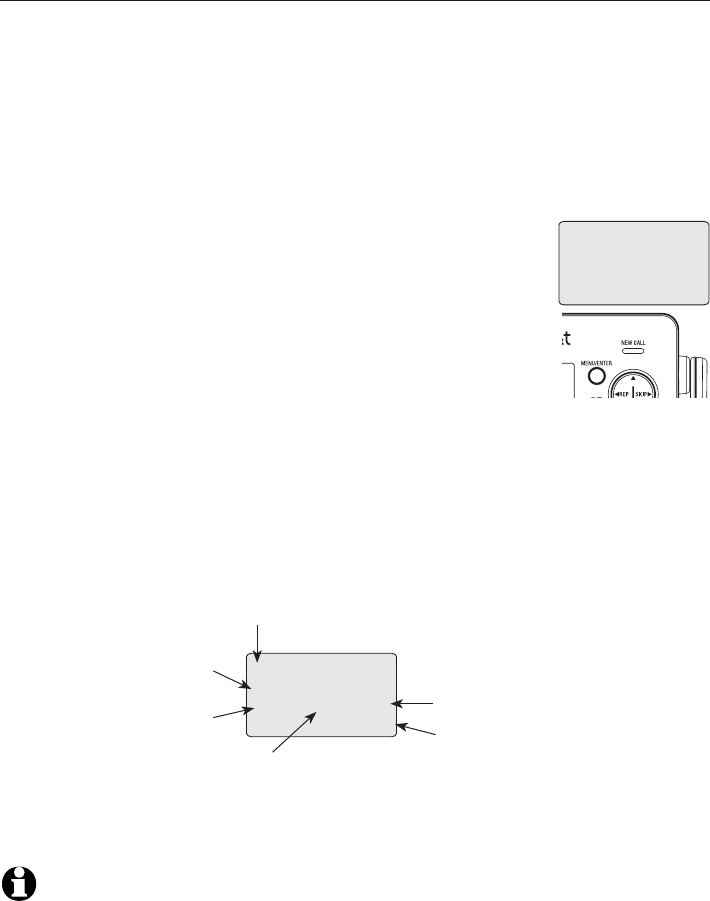
58
Caller ID
Caller ID history
Caller ID
Caller ID history
How the caller ID history (call log) works
The telephone stores caller ID information for the last 50 incoming calls
in the telephone base. Entries are stored in reverse chronological order.
The phone deletes the oldest entry when the log is full to make room for
new calls. This information is shared by the telephone base and all system
handsets. If you answer a call before the information appears on the screen,
it does not show in the caller ID history.
Review the caller ID history to determine who called, to easily return the call,
or to copy the caller’s name and number into your directory.
NEW CALL indicator lights and XX missed call(s) appears
if there are new call log entries (including missed and
unreviewed calls).
The time and date of the call and the caller’s name and
phone number are included in the display.
Caller ID information appears on the screen as the phone
rings, or until the caller hangs up, or until the call has been
answered at another extension, or until the call ends.
If you subscribe to caller ID service, this phone automatically resets the time
and date each time new call information is received. You can also set the
time and date yourself (see Time adjustment on page X).
NOTES:
1. Each entry may have up to 32 digits for the phone number and 16 characters for the name. If the
phone number has more than 16 digits, only the last 16 digits appear.
2. The callers might intentionally block their names and/or telephone numbers.
Anderson Allen
123 456 7890
5:30PM 8/9 NEW
Enter=Add
Caller’s name
Caller’s number
Appears when the call is
missed and un-reviewed
Date of call
Time of call
Add to directory
Screen display of the telephone base
*:Base
3 missed calls
11:30PM 12/31
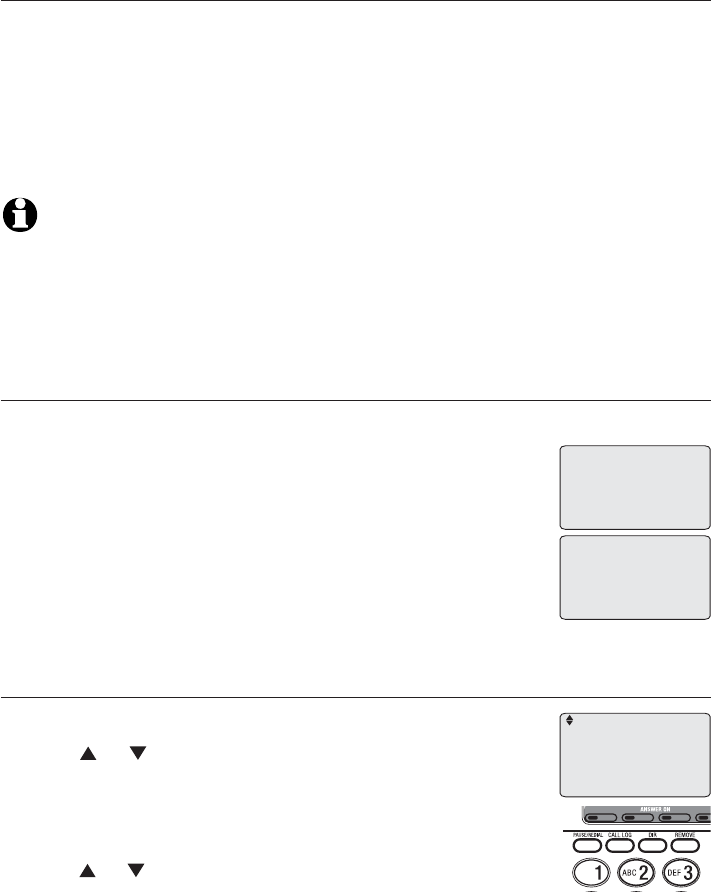
59
Caller ID
Caller ID operation
Memory match
If the incoming telephone number is an exact match with a telephone
number in your directory, the name that appears on the screen matches the
corresponding name in your directory.
For example, if Christine Smith calls, her name appears as Chris if this is how
you entered it into your directory.
NOTE: The number you see on your caller ID is in the format from the telephone service
provider. It usually delivers ten-digit phone numbers (area code plus phone number). If the
telephone number of the caller is not an exact match with a number in your directory, the
name appears from the telephone service provider records. For example, if the phone
company includes the area code and the directory number does not, the name appears as
delivered by the phone company.
Missed (new) calls indicator
When the telephone base is in idle mode and has unreviewed calls, its screen
shows XX missed call(s).
All unreviewed entries are counted as missed calls. Each
time you review a call log entry with the icon NEW, the
number of missed calls decreases by one. When all the
entries in the caller ID history become old (have been
reviewed), the system removes the missed calls alert from
the display, and the NEW CALL indicator turns off.
Review the caller ID history
When the telephone is idle, press MENU/ENTER.
Press or to scroll to Call log. Press MENU/ENTER.
-OR-
When the telephone is idle, press CALL LOG.
3. Press or to review the caller ID history. The caller ID
history displays the caller ID entries in reverse chronologi-
cal order starting with the most recent call.
4. To exit without making changes, press EXIT.
1.
2.
*:Base
0 missed calls
12:00PM 12/31
Anderson Allen
123 456 7890
5:30PM 8/9
Enter=Add
Directory
Call log
Ringer setting
Mailbox setup
>
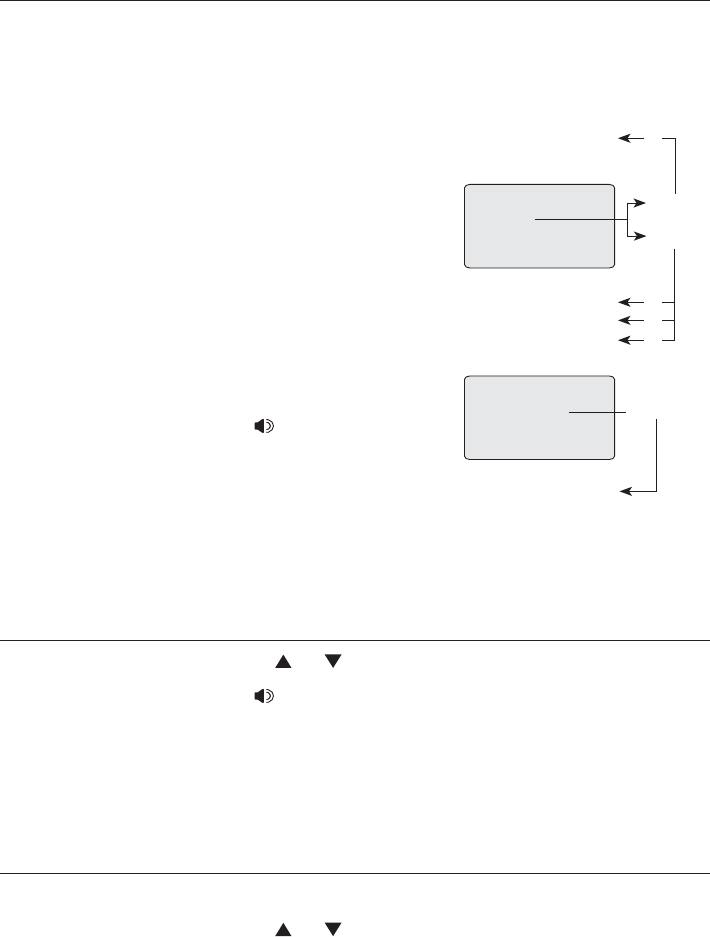
60
Caller ID
Caller ID operation
Make a call log entry ready to dial
Although the incoming call log entries have 10 digits (the area code plus
the seven-digit number), in some areas, you may only need to dial the seven
digits, 1 plus the seven digits, or 1 plus the area code plus the seven digits.
You can change and store the number of digits that you dial in the call log.
While reviewing the call log, press # repeatedly
on the telephone base to show different dialing
options for local and long distance numbers
before dialing or saving the telephone number in
the directory.
Press 1 repeatedly on the telephone base if
you need to add or remove 1 in front of the
telephone number before dialing or saving it in
the directory.
When the number shows in the correct format
for dialing,
Lift the handset or press SPEAKER.
To override automatic line selection, press
the LINE key for the desired line, then lift the
handset.
4. To exit without making changes, press EXIT.
Dial a call log entry
When in the call log, press or to browse the number you wish to call.
Lift the handset or press SPEAKER.
To override automatic line selection, press the LINE (1-4) key for the
desired line, then lift the handset.
4. To exit without making changes, press EXIT.
Delete entries
Delete an caller ID entry
1.
2.
1.
2.
3.
•
AT&T
222 3111
12:00PM 1/1
Enter=Add
1 222 3111
800 222 3111
1 800 222 3111
Press #
or
or
or
Press 1
or
1 222 3111
AT&T
800 222 3111
12:00PM 1/1
Enter=Add
1 800 222 3111
Press 1
When in the call log, press or to browse the number you wish to
delete.
Press REMOVE to delete the shown entry from the caller ID history.
1.
2.
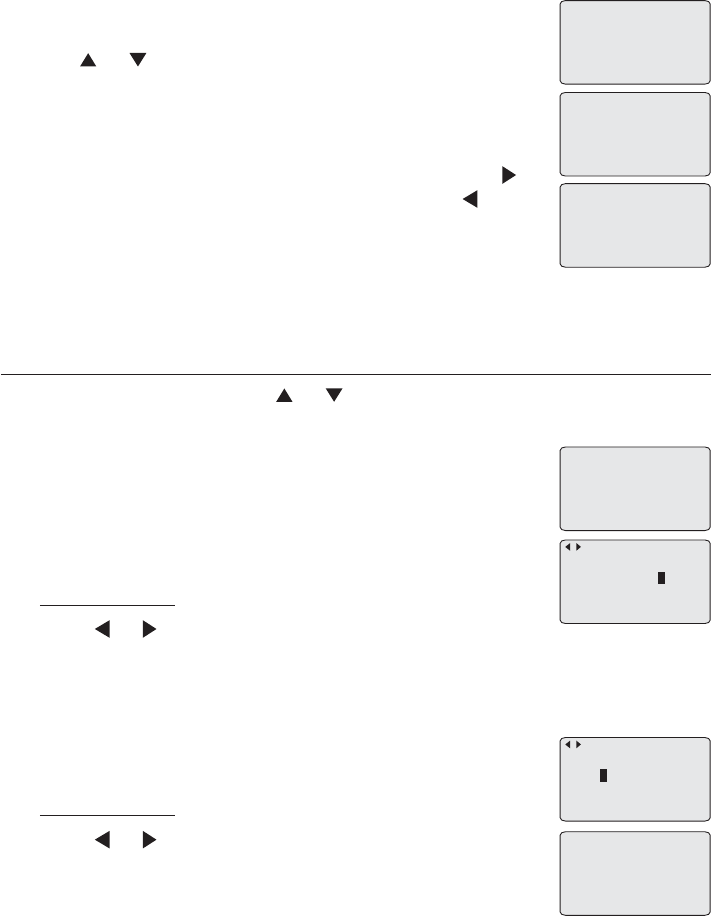
61
Caller ID
Caller ID operation
Delete all caller ID history
When the telephone is idle, press MENU/ENTER.
Press or to scroll to Call log. Press MENU/ENTER.
-OR-
When the telephone is idle, press CALL LOG.
3. Press REMOVE. The screen displays Erase all? Press to
clear the caller ID history of all entries, or press to exit
and leave all entries in the caller ID history intact.
4. To exit without making changes, press EXIT.
Save a call log entry to the directory
When in the call log, press or to browse the number you wish to
save.
The screen displays Enter=Add. Press MENU/ENTER.
When a call log entry appears,
- Press the dial pad keys to add digits.
- Press REMOVE to erase digits.
- Press and hold REMOVE to erase all digits.
- Press or to move the cursor to the left or right.
- Press REDIAL/PAUSE to enter a three-second dialing pause (a P appears).
4. The screen displays Enter=Next. Press MENU/ENTER to move to the name.
- Press the dial pad keys to add characters.
- Press REMOVE to erase characters.
- Press and hold REMOVE to erase all characters.
- Press or to move the cursor to the left or right.
- Press # to enter a space.
5. Press MENU/ENTER to save your new directory entry.
There is a confirmation tone. The name and the tele-
phone number appear. You cannot save the same number twice.
- If the entry is already saved in the directory, the screen display remains
the same and waits for editing.
•
1.
2.
1.
2.
3.
Call log
3 missed calls
Rem.=Delete all
Erase all?
<=No >=Yes
Deleted
AT&T
1 800 222 3111
12:00PM 1/1
Enter=Add
Enter phone no.:
18002223111
Enter=Next
Enter name:
AT&T
Enter=Save
AT&T
1 800 222 3111
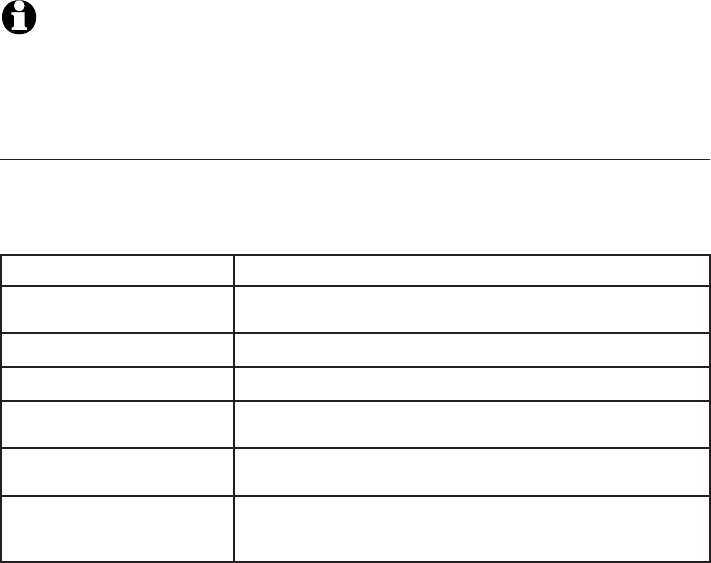
62
Caller ID
Reasons for missing caller ID information
- If there is no caller ID information, you hear an error tone. The number is
unable to save.
6. To exit without making changes, press EXIT.
NOTE: You might need to change how a caller ID number is dialed if the entry does not appear
in the correct format. Caller ID numbers might appear with an area code that might not be
necessary for local calls, or without a 1 that might be necessary for long distance calls (see
page X, Make a call log entry ready to dial).
Reasons for missing caller ID information
There are also occasions when other information or no information shows for
various reasons:
On-screen message Reason
PRIVATE NUMBER
The caller prefers not to show the phone number.
PRIVATE NAME
The caller prefers not to show the name.
PRIVATE CALLER
The caller prefers not to show the phone number and name.
UNKNOWN NUMBER
Your local telephone service provider cannot determine the call-
er’s number.
UNKNOWN NAME
Your local telephone service provider cannot determine the
caller’s name.
UNKNOWN CALLER
Your local telephone service provider cannot determine the call-
er’s name and telephone number. Calls from other countries may
also generate this message.

63
Answering system
About the answering system
Your telephone has a digital answering system, including an auto attendant
and voicemail features, to select a desired answering method for incoming
calls. You can have a customized answering system setup for each phone line.
You can manage all voicemail messages of phone line through the general
mailbox feature on the telephone base.
Answering system capacity
You can record up to five new announcements to have different
announcements for each line. Each announcement can be up to two minutes.
Auto attendant and voicemail announcements both require system memory
to record, so we suggest recording brief announcements in order to leave
more space for messages.
The answering system can record up to 255 messages, depending on the
length of each message. Individual messages can be up to three minutes.
Messages remain available for review until you delete them.
If the system memory is full, you cannot record new messages until old ones
have been deleted.
Check Remaining space (see page X) frequently to keep maintain availability
of space for incoming messages.
Turn the answering system on or off at the telephone base
Turn on the answering system
You can turn the answering system on as either an auto attendant feature
mode or voicemail mode.
Please refer to Turn on the auto attendant on page X.
Please refer to Turn on the mailbox on page X.
Turn off the answering system
You can turn the answering system off, but if you do so, the answering
system does not answer calls and record incoming messages.
Please refer to Turn off the auto attendant on page X.
Please refer to Turn off the mailbox on page X.
New message indication
•
•

64
Answering system
About the auto attendant
If you want your telephone base to automatically answer incoming calls for
your system, to announce the directory, and to enable your callers to record
central system messages, you need to customize Auto attendant setup (see
page X).
If the auto attendant is active and is answering or directing a call or playing
or recording an announcement or message, the LINE (1-4) light flashes
sequentially (page X). To interrupt the auto attendant, press the flashing
LINE (1-4) key to talk to the caller on that line, or press any other LINE (1-
4) key to disconnect this call and make a new call on another line.
An auto attendant assigned to a phone line can only answer one call at
a time, so you might want to have more than one auto attendant in your
system so that even when a call on one line is being answered, a second
auto attendant telephone can answer another ringing line. You can designate
up to 4 auto attendants in your system.
NOTES:
1. Only outside calls are answered by an auto attendant.
2. The auto attendant phone does not answer calls when the phone is being used for setup, message
review, call history review, or a phone call.
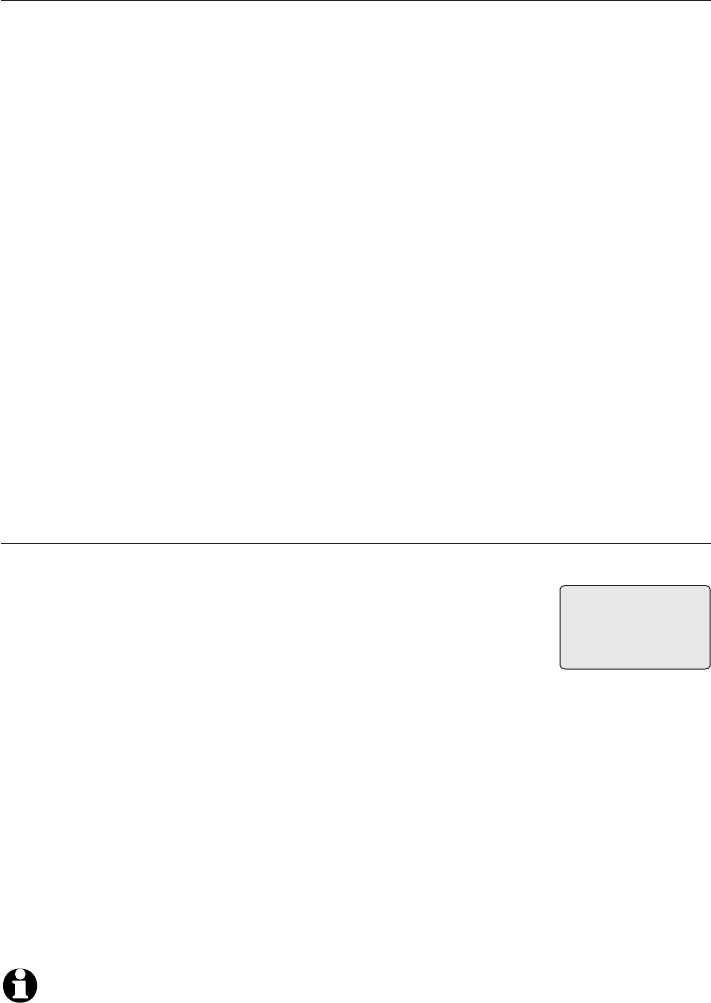
65
Answering system
Auto attendant operation
Using multiple auto attendants
You can set one or more phone lines to act as auto attendant(s) when the
primary auto attendant is turned off or busy.
An auto attendant is busy when someone at that extension is doing any of
the following:
programming the phone
accessing messages
on an intercom call
dialing from the directory or call history
using any of the lines to make or answer a call
when the answer system is recording a message at that extension
You can choose a particular phone line to always be the primary auto
attendant by setting that line to have the shortest auto attendant pickup
delay (number of rings) and setting the pickup delays of other auto
attendants for you to choose. If the auto attendant pickup delays are the
same, incoming calls might be distributed randomly to the auto attendants.
Auto attendant sequence for callers
When you set this telephone base to be an auto attendant, it automatically
picks up a ringing line after the number of rings you
programmed (see Number of rings on pageX), and plays the
appropriate auto attendant announcement.
When a caller enters a correct extension number after
hearing the announcement, the auto attendant transfers the call to that
extension and announces to the caller, “Calling that extension. Please wait.”
The auto attendant continues to monitor the call after it is transferred. If
the extension is set to use mailbox, the mailbox answers and can record
an incoming extension message. If neither the requested extension nor its
mailbox picks up within XX seconds, the auto attendant announces, “That
extension is not answering. Enter a new extension number, or , to leave a
central message in the general mailbox, please dial nine.” The auto attendant
attempts to transfer the call up to five times. If the call is not picked up by
any extension during those attempts, the call is dropped.
NOTES:
1. If someone at the requested extension picks up the call and subsequently places the call on hold
•
•
•
•
•
•
*:Base
3 missed calls
11:30PM 12/31
AuAt
66
Answering system
Auto attendant operation
again, that extension must pick up the call again within X minutes or the call is dropped. The XX
minutes restarts each time and same call is placed on hold.
2. If the memory is full or the auto attendant is turned off on the extension, no extension messages
can be recorded in the general mailbox.
If the caller presses 0 after hearing the message, the auto-attendant
directory plays. The caller can then decide whether to enter an extension
number or not, and the auto attendant responds as described above.
If the caller does not enter an extension number after hearing the
announcement, the auto attendant waits about X seconds, then transfers
the call to extension X. If the call is not picked up after X seconds, the auto
attendant answers the call again, and plays “That extension is not answering.
Enter a new extension number, or , to leave a central message in the general
mailbox, please dial nine.” and wait X seconds for the entry. If the caller still
hasn’t extered an extension number after hearing this message five times, the
auto attendant announces, “That extension is not answering. Thank you” and
drops the call.
If the caller enters an invalid extension number, the auto attendant
announces, “The system does not recognize that extension. Please check it,
and enter it again.”
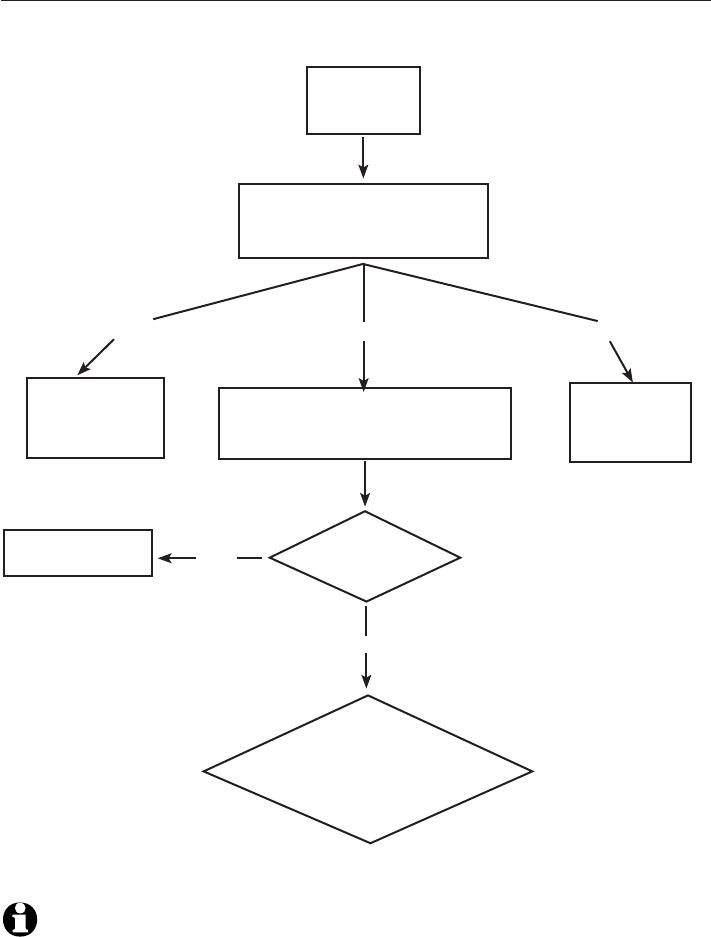
67
Answering system
Auto attendant operation
Auto attendant flow chart
Incoming
call
AA answers and plays
outgoing announcement
AA records
central
message
AA plays “Calling that ...” and
calls extension, which rings
AA plays
directory
Person
answers call?
Normal call
Caller dials 9 Caller dials 0
Caller dials extension number
Enters
another
extension
or records a
message
NOTE: If the caller enters an extension number that is not answered by a person or by that
extension, and if its mailbox is busy (not able to answer and record), then the caller is returned
to the auto attendant, with the message “That extension is not answering. Enter a new
extension number, or, to leave a central message in the general mailbox, please dial nine.”
Yes
No
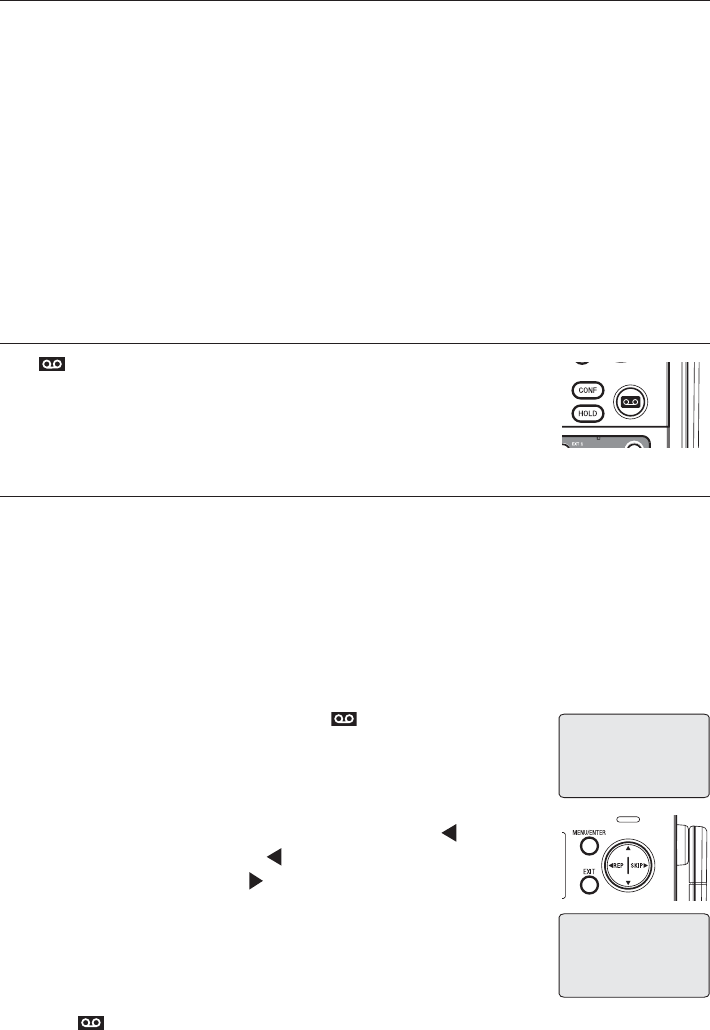
68
Answering system
Voicemail operation
Incoming messages
If your telephone is not set up as an auto attendant, it stores messages in
the general mailbox.
If your telephone is an auto attendant, it can store two kinds of messages:
Private messages - including incoming messages, memos and two-way
conversations. (page X)
Central messages (COVM) are the incoming messages recorded in the local
telephone service provider which you subscribe to voice mail service. You
can access the telephone service provider with your access code to playback
the messages. The COVM indicator displays on the telephone base screen to
remind you of a new and unreviewed messages (page X).
New message indicator
The Messages indicator on the telephone base flashes
when there are new and unreviewed voicemails in the
general mailbox.
Message playback
If you have new messages, you hear only the new messages (oldest first). If
there are no new messages, the system plays back all the messages (oldest
first).
When playback begins, the total number of messages is announced. Before
each message, you hear the day and time of the recording. After the last
message, you hear, “This is the last message.”
To listen to messages at the telephone base:
1. While the telephone is idle, Press Messages on the
telephone base.
2. The system announces the number of new and unre-
viewed messages in the general mailbox.
3. Press Play all to listen to all messages. Press REP to
repeat the message, press REP twice to listen to the
previous message. Press SKIP to move forward to the
next message. There is a long beep after each message
playback as a separator.
4. Playback ends after playing all the messages, and then
returns to the previous menu.
5. Press Messages again to end the message playback at any time.
<---Message 1--->
12:57 PM 03/06
2 new messages
Play all
Deliver
Delete all old
>
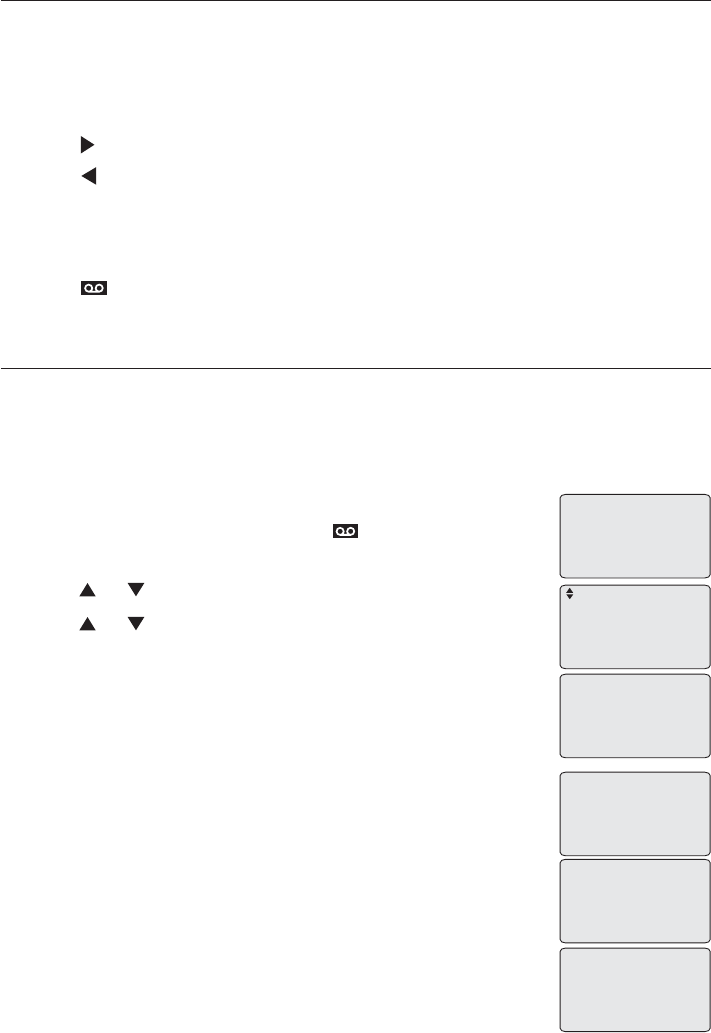
69
Answering system
Voicemail operation
Options during playback
When a message is playing, you can adjust the playback volume, skip,
repreat, or delete the message.
When messages are playing on the telephone base:
Press VOL+/VOL- key to adjust the message playback volume.
Press SKIP to skip to the next message.
Press REP to repeat the message. Press twice to hear the previous
message.
Press REMOVE to delete the message. The system announces, “Message is
erased.”
Press Messages to stop the playback.
Record and deliver message memo
Message memos are messages you record into the general mailbox at the
telephone base. You can save, play back, and delete them like incoming
messages. You can record a memo as a reminder to yourself, or leave a
message and transfer to other extensions using the answering system.
To record a memo, then deliver it:
1. When the telephone is idle, press Messages on the
telephone base.
2. Press or to scroll to Deliver. Press MENU/ENTER.
3. Press or to scroll to select a desired registered
extension you wish to transfer to or select all the regis-
tered extension handsets,
X: Handset X -#: All. Press MENU/ENTER.
4. Press MENU/ENTER. You can start recording after the tone.
The timer starts counting.
5. Press MENU/ENTER again to stop recording. The timer
stops and the recorded message memo automatically
plays back. The screen displays 1=Change, 2=OK.
6. Press 2to save the setting and the message memo is
transfered to the extension you selected. The system
announces, “You message transfered to mailbox X.”,
and then returns to the previous menu, or press 1to re-
record that message memo.
•
•
•
•
•
2 new messages
Play all
Deliver
Delete all old
>
Message record
Enter=Start
1:Handset 1
2:Handset 2
#:All
>
Message record
00:32
Enter=End
Message check
00:09
1=Change 2=OK
Msg. transfered
to mailbox 2
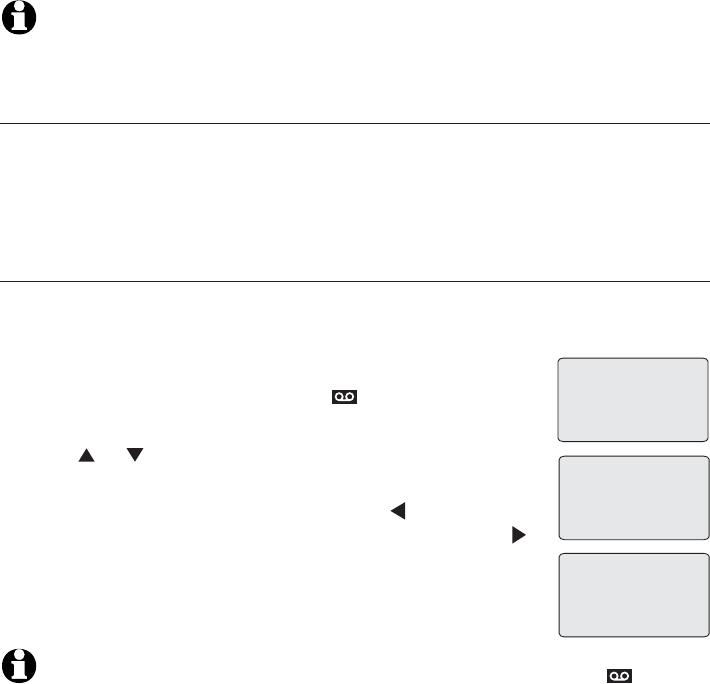
70
Answering system
Voicemail operation
-OR-
To exit without making changes, press EXIT.
NOTE: If you record a message memo less than 5 seconds, the message is not saved as a
message in the general mailbox.
Play back a message memo
Play message memos the same way as messages. See Message playback on
page X.
Delete all old messages
You can only delete old (reviewed) messages. You cannot delete new
messages until you review them. You cannot retrieve deleted messages.
Delete all old messages on the telephone base:
1. When the telephone is idle, press Messages on the
telephone base.
2. Press or to scroll to Delete all old messages. Press
MENU/ENTER.
3. The screen displays <=No, Yes=>. Press to cancel this
operation, and returns to the previous menu, or press
to remove all old messages from the general mailbox.
NOTE: If there is new and unreviewed message(s) in the general mailbox, the
Messages indicator will still flash after you delete all old messages.
2 new messages
Play all
Deliver
Delete all old
>
All erased.
Delete all old
messages
<=No Yes=>

71
Answering system
Remote access
You can reach your answering system remotely by dialing your telephone
number from any touch-tone telephone.
To remotely reach your answering system:
1. Dial your telephone number from any touch-tone telephone.
2. When the system answers, enter the two digit remote access code (0000 is
the default code, see page X to change it).
The system automatically announces the number of messages (new and/or
old) if there are any, and then begins to play them.
3. You can also enter the following remote commands.
Remote commands
1Press to play to all messages.
Press to record a new announcement (during announcement
playback).
•
•
2Press to accept the recorded announcement (during an-
nouncement playback).
•
3Press to delete the current message (during playback).
Press to delete the recorded announcement (during an-
nouncement playback).
•
•
4Press to repeat the current message (during playback).
44 Press twice to listen to the previous message (during playback).
5Press to repeat the list of remote commands.
Press to stop and return to the remote commands (during
playback).
Press to end the recording (during recording announcement).
•
•
•
6Press to skip to the next message (during playback).
7Press to transfer the current message (during playback).
8Press to change the personal announcement (This option is only
available to handset mailboxes).
9Press to change to the general mailbox (This option is only avail-
able to handset mailboxes).
*Press to end the call.
Press to accept the recorded announcement (during
announcement playback).
•
•

72
Answering system
Remote access
4. Hang up to end the call and save all undeleted messages.
Cut out the remote access wallet card at the back of this user’s manual for
quick reference.
NOTES:
1. If you do not enter a valid remote access code, the system ignores your entering and continues
the call.
2. If you pause for more than four seconds during remote access, you hear a help menu listing all
features and commands. If there is no command for another 20 seconds, the call ends automati-
cally.
3. If you want to delete all the old messages remotely, press 3 twice in remote standby mode.
4. If the memory is full, the answering system answers after 10 rings and announces, “Memory is
full. Enter the remote access code.” Enter your remote access code to access the messages and
announcements.
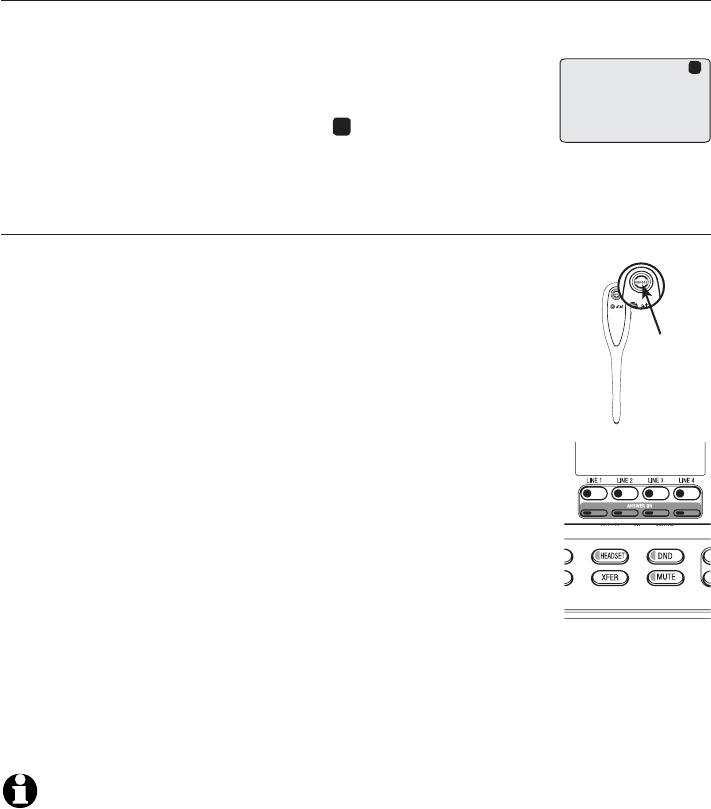
73
Work with cordless headset
Cordless headset operation
To register and deregister an AT&T compatible DECT 6.0 cordless headset
(AT&T TL7600/7610/7611 model) at the SB67118 telephone base, please
refer to the pages X-X. To view the TL7610/7611/7600 model manual, visit
our website at www.telephones.att.com, or call 1 (800) 222-3111.
In Canada dial 1 (866) 288-4268.
Number the cordless headset
A cordless headset is numbered as extension 10 after the registration,
regardless of how many handsets have already been
registered to the base..
By pressing the ON/OFF button on the cordless headset,
you can see the extension indicator 10 on the telephone
base screen.
Make a call
You can make a call by using a registered cordless headset and
the dial pad at the telephone base.
To make a call:
Press ON/OFF button on the cordless headset.
-OR-
Press ON/OFF button on the cordless headset, then press the
LINE (1-4) key for the desired line to override automatic
line selection.
2. Wait for a dial tone. The HEADSET indicator on the tele-
phone base turns on. You can enter the telephone num-
ber and the screen displays the elapsed time as you talk
(in hours, minutes and seconds).
To end a call:
Press ON/OFF button again on the cordless headset to
hang up.
-OR-
Press the HEADSET key on the telephone base to hang up.
NOTE: The elapsed time is not affected by accessing services from your local telephone service
provider.
•
1.
•
ON/OFF
button
*:Base
0 missed calls
11:30PM 12/31
10

74
Work with cordless headset
Cordless headset operation
Answer a call
To answer a call
Press the ON/OFF button on the cordless headset. The HEADSET indicator
on the telephone base turns on.
To end a call:
Press the ON/OFF button again on the cordless headset to hang up.
-OR-
Press the HEADSET key on the telephone base to hang up.
•
•
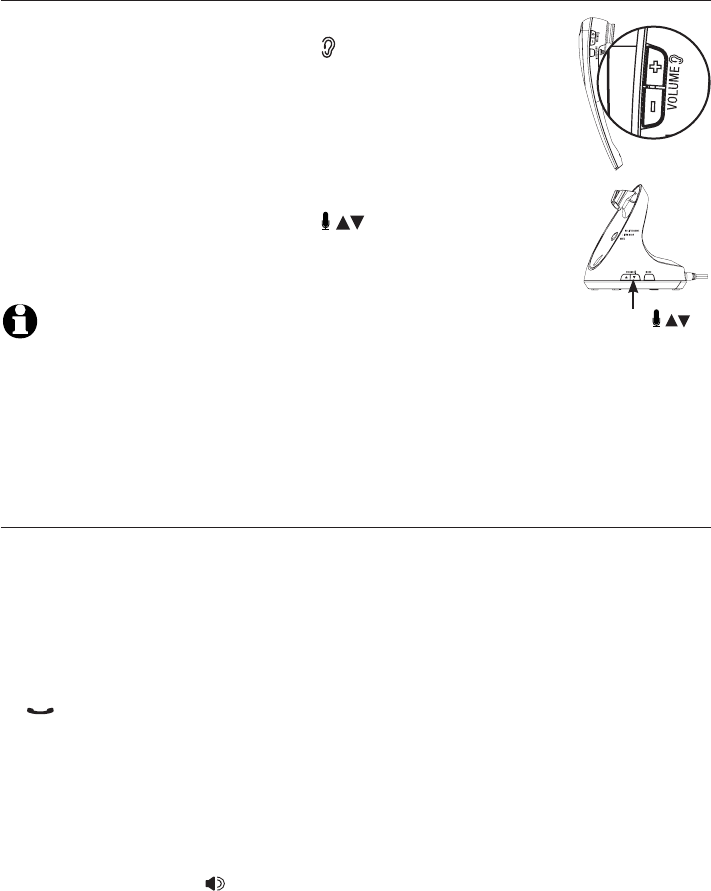
75
Work with cordless headset
Options while on calls
Volume control
To adjust the listening volume:
While on a call, press the VOLUME + / – keys on the side of
the headset to adjust the listening volume.
To adjust the speaking volume:
While on a call, press the VOLUME keys on the side of
the headset base to adjust the speaking volume.
NOTE: When the volume reaches the minimum or maximum setting, you
hear three quick beeps.
Switch between corded or cordless handset, speakerphone and
cordless headset
Switch from corded or cordless handset to cordless headset
During a call, press the HEADSET key on the telephone base. You can hear
a dial tone on the cordless headset.
Switch from cordless headset to corded or cordless handset
During a call, lift the corded handset on the telephone base or press
PHONE/FLASH on the cordless handset.
Switch from speakerphone to cordless headset
During a call, press the HEADSET key on the telephone base. You can hear
a dial tone on the cordless headset.
Switch from cordless headset to speakerphone
During a call, press SPEAKER on the telephone base. The HEADSET
indicator on the telephone base turns off.
•
•
•
•
VOLUME
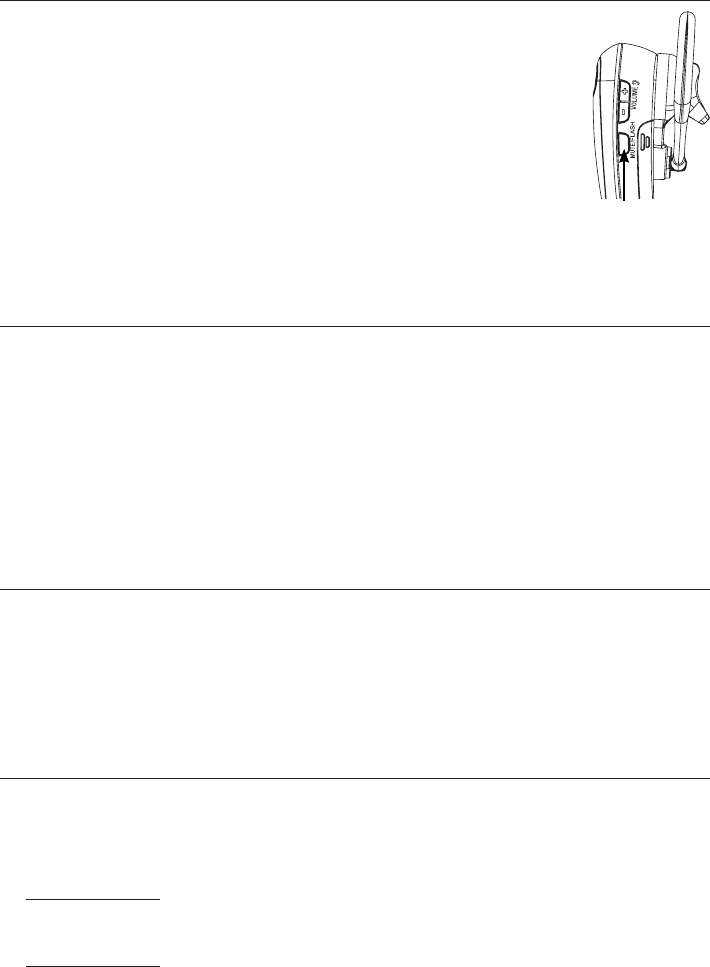
76
Work with cordless headset
Options while on calls
Call waiting
If you subscribe to call waiting service with your local
telephone service provider, you hear a beep from the
earpiece of the cordless headset if you receive an incoming
call while you are already on a call using the cordless
headset.
Press the MUTE/FLASH button on the cordless headset to
put your current call on hold and take the new call.
Press the MUTE/FLASH at any time to switch back and
forth between calls.
Answer a call from another line
You can answer a call from another line while using the cordless headset
during a call.
During a call, press the desired LINE (1-4) key to answer another call. Your
current call is put on hold.
Press the desired LINE (1-4) key to retrieve the original call. Your current
call is put on hold.
Hold
You can mute a call by pressing the MUTE/FLASH key during a conversationduring a conversation
to silence the microphone of the cordless headset. You can hear the caller
from the cordless headset, but the caller does not hear you.
Join in
You can join in an ongoing call on another extension handset when the call
privacy is not set on that handset.
Press ON/OFF button on the cordless headset. You can hear a dial tone.
Press and hold the desired LINE (1-4) key to join in the call.
-OR-
Press and hold the desired LINE (1-4) key on the telephone base to join in
the call.
Press HEADSET on the telephone base to switch to the cordless headset.
•
•
•
•
•
•
•
•
MUTE/FLASH

77
Work with cordless headset
Options while on calls
Conference calls
You can use cordless headset to join in a conference call.
Start a conference call
While using cordless headset to make or answer a call, press HOLD to put
the current call on hold.
Enter a new telephone number, then press LINE (1-4) key to call someone
on another line, or press the desired one-touch key to start an intercom
connection.
When this call or intercom is answered, press CONF on the telephone base.
The three-party conference begins immediately.
Join a conference call
Press the HEADSET key on the telephone base to join the conference call.
NOTE: Please refer to Three-way conference call on page X 45 for detailed conference call
operation..
Intercom calls
You can make or answer an intercom call with the cordless headset.
Make an intercom call
Press the HEADSET key on the telephone base or press the ON/OFF button
on the cordless headset. You can hear a dial tone.
Press the one-touch key for the detination party. The screen displays
Calling X: Handset X (Xrepresents the extension and handset number).
-OR-
The user can initiate the intercom using the speakerphone/corded handset
and then switch to headset mode by pressing the HEADSET key on the
telephone base, or by pressing the ON/OFF button on the cordless headset.
It is also possible to the initiate intercom when the telephone base is off-
hook and the cordless headset is in use. The procedure is the same as with
the speakerphone/corded handset mode.
•
•
•
•
•
•
•
•

78
Work with cordless headset
Options while on calls
NOTES:
1. Before the destination party answers the intercom call, press the corresponding LINE (1-4) key to
resume the call.
2. The intercom call automatically ends if the destination party does not answer it for 1 minute.f

79
Appendix A
Telephone base display screen messages
Call log empty
Place handset in
cradle and press
INT on base for 4
seconds to register
handset
Handset registering
Handset registered
Calling
1: Handset 1
Directory empty
Cordless headset
registering
Cordless headset
registered
Memory is full
Incoming call
---Line X---
Intercom to:
XX missed calls
Busy
Deregistering
All handsets dereg-
istered
Auto Attendant ON
Play announcement
Alert call #. . #
COVM reset
Deleted
Privacy
Msg. transfered to
mailbox X
All erased.
80
Appendix A
Telephone base display screen messages

81
Appendix B
Maintenance
Taking care of your telephone
Your telephone base contains sophisticated electronic parts, so you must treat it with care.
Avoid rough treatment.
Place the corded handset down gently.
Save the original packing materials to protect your telephone base if you ever need to ship it.
Avoid water
You can damage your telephone base if it gets wet. Do not use the corded handset in the rain,
or handle it with wet hands. Do not install the telephone base near a sink, bathtub or shower.
Electrical storms
Electrical storms can sometimes cause power surges harmful to electronic equipment. For
your own safety, take caution when using electric appliances during storms.
Cleaning your telephone
Your telephone base has a durable plastic casing that should retain its luster for many years.
Clean it only with a soft cloth slightly dampened with water or a mild soap.
Do not use excess water or cleaning solvents of any kind.
•
•
•
•
•
•
•
•
Remember that electrical appliances can cause serious injury if used when you are wet or
standing in water. If the telephone base should fall into water, DO NOT RETRIEVE IT UNTIL YOU
UNPLUG THE POWER CORD AND TELEPHONE LINE CORDS FROM THE WALL. Then pull the unit
out by the unplugged cords.

82
Appendix C
Important safety information
This symbol is to alert you to important operating or servicing instructions that may
appear in this user’s manual. Always follow basic safety precautions when using this
product to reduce the risk of injury, fire, or electric shock.
Safety information
Read and understand all instructions in the user’s manual. Observe all markings on the
product.
Avoid using a telephone during a thunderstorm. There may be a slight chance of electric shock
from lightning.
Do not use a telephone in the vicinity of a gas leak. If you suspect a gas leak, report it
immediately, but use a telephone away from the area where the gas is leaking. If this product
is a cordless model, make sure the telephone base is also away from the area.
Do not use this product near water, or when you are wet. For example, do not use it in a wet
basement or shower, or next to a swimming pool, bathtub, kitchen sink, or laundry tub. Do
not use liquids or aerosol sprays for cleaning. If the product comes in contact with any liquid,
unplug any line or power cord immediately. Do not plug the product back in until it has dried
thoroughly.
Install this product in a protected location where no one can trip over any line or power cords.
Protect cords from damage or abrasion.
If this product does not operate normally, see the Troubleshooting section on pagesX-X of
this user’s manual. If you cannot solve the problem, or if the product is damaged, refer to the
Limited warranty on X-X. Do not open this product except as directed in your user’s manual.
Opening the product or reassembling it incorrectly may expose you to hazardous voltages or
other risks.
Replace batteries only as described in your user’s manual. Do not burn or puncture batteries
— they contain caustic chemicals.
This power adapter is intended to be correctly oriented in a vertical or floor mount position.
The prongs are not designed to hold the plug in place if it is plugged into a ceiling or an
under-the-table/cabinet outlet.
Caution: Use only the power adapter provided with this product. To obtain a
replacement, visit our website at www.telephones.att.com or call 1
(800) 222-3111. In Canada, dial 1 (866) 288-4268.
•
•
•
•
•
•
•
•

83
Appendix C
Important safety information
Especially about cordless telephones
Electrical power: The telephone base must be connected to a working electrical outlet. The
electrical outlet should not be controlled by a wall switch. Calls cannot be made from the
handset if the telephone base is unplugged or switched off, or if the electrical power is
interrupted.
Power adapter: The power adapter is intended to be correctly oriented in a vertical or floor
mount position. The prongs are not designed to hold the plug in place if it is plugged into a
ceiling, under-the-table or cabinet outlet.
Precautions for users of implanted cardiac pacemakers
Cardiac pacemakers (applies only to digital cordless telephones):
Wireless Technology Research, LLC (WTR), an independent research entity, led a multidisciplinary
evaluation of the interference between portable wireless telephones and implanted cardiac
pacemakers. Supported by the U.S. Food and Drug Administration, WTR recommends to physicians
that:
Pacemaker patients
Should keep wireless telephones at least six inches from the pacemaker.
Should NOT place wireless telephones directly over the pacemaker, such as in a breast pocket,
when it is turned ON.
Should use the wireless telephone at the ear opposite the pacemaker.
WTR’s evaluation did not identify any risk to bystanders with pacemakers from other persons
using wireless telephones.
Especially about telephone answering systems
Two-way recording: This unit does not sound warning beeps to inform the other party that the
call is being recorded. To ensure that you are in compliance with any federal or state regulations
regarding recording a telephone call, you should start the recording process and then inform the
other party that you are recording the conversation.
SAVE THESE INSTRUCTIONS
•
•
84
Appendix D
FCC part 68 and ACTA
This equipment complies with Part 68 of the FCC rules and with technical requirements adopted
by the Administrative Council for Terminal Attachments (ACTA). The label on the back or
bottom of this equipment contains, among other things, a product identifier in the format US:
AAAEQ##TXXXX. This identifier must be provided to your local telephone company upon request.
The plug and jack used to connect this equipment to premises wiring and the telephone network
must comply with the applicable Part 68 rules and technical requirements adopted by ACTA. A
compliant telephone cord and modular plug is provided with this product. It is designed to be
connected to a compatible modular jack that is also compliant. An RJ11 jack should normally be
used for connecting to a single line and an RJ14 jack for two lines. See Installation Instructions in
the user’s manual.
The Ringer Equivalence Number (REN) is used to determine how many devices you may connect
to your telephone line and still have them ring when you are called. The REN for this product is
encoded as the 6th and 7th characters following the US: in the product identifier (e.g., if ## is
03, the REN is 0.3). In most, but not all areas, the sum of all RENs should be five (5.0) or less. For
more information, please contact your local telephone company.
This equipment may not be used with Party Lines. If you have specially wired alarm dialing
equipment connected to your telephone line, ensure the connection of this equipment does not
disable your alarm equipment. If you have questions about what will disable the alarm equipment,
consult your telephone company or a qualified installer.
If this equipment is malfunctioning, it must be unplugged from the modular jack until the problem
has been corrected. Repairs to this telephone equipment can only be made by the manufacturer
or its authorized agents. For repair procedures, follow the instructions outlined under the Limited
Warranty.
If this equipment is causing harm to the telephone network, the telephone company may
temporarily discontinue your telephone service. The telephone company is required to notify
you before interrupting service. If advance notice is not practical, you will be notified as soon as
possible. You will be given the opportunity to correct the problem and the telephone company
is required to inform you of your right to file a complaint with the FCC. Your telephone company
may make changes in its facilities, equipment, operation, or procedures that could affect the
proper functioning of this product. The telephone company is required to notify you if such
changes are planned.
If this product is equipped with a corded or cordless handset, it is hearing aid compatible.
If this product has memory dialing locations, you may choose to store emergency telephone
numbers (e.g., police, fire, medical) in these locations. If you do store or test emergency numbers,
please:
Remain on the line and briefly explain the reason for the call before hanging up.
Perform such activities in off-peak hours, such as early morning or late evening.
Industry Canada
Operation is subject to the following two conditions: (1) this device may not cause harmful
interference, and (2) this device must accept any interference, including interference that may
cause undesired operation.
The term ‘’IC:‘’ before the certification/registration number only signifies that the Industry Canada
technical specifications were met.
The Ringer Equivalence Number (REN) for this terminal equipment is 0.1. The REN is an indication
of the maximum number of devices allowed to be connected to a telephone interface. The
termination on an interface may consist of any combination of devices subject only to the
requirement that the sum of the RENs of all the devices does not exceed five.
This product meets the applicable Industry Canada technical specifications.

85
Appendix E
FCC part 15
This equipment has been tested and found to comply with the requirements for a Class B digital
device under Part 15 of the Federal Communications Commission (FCC) rules. These requirements
are intended to provide reasonable protection against harmful interference in a residential
installation. This equipment generates, uses and can radiate radio frequency energy and, if not
installed and used in accordance with the instructions, may cause harmful interference to radio
communications. However, there is no guarantee that interference will not occur in a particular
installation. If this equipment does cause harmful interference to radio or television reception,
which can be determined by turning the equipment off and on, the user is encouraged to try to
correct the interference by one or more of the following measures:
Reorient or relocate the receiving antenna.
Increase the separation between the equipment and receiver.
Connect the equipment into an outlet on a circuit different from that to which the receiver is
connected.
Consult the dealer or an experienced radio/TV technician for help.
Changes or modifications to this equipment not expressly approved by the party responsible for
compliance could void the user’s authority to operate the equipment.
This device complies with Part 15 of the FCC Rules. Operation is subject to the following two
conditions: (1) this device may not cause harmful interference, and (2) this device must accept
any interference received, including interference that may cause undesired operation. Privacy of
communications may not be ensured when using this telephone.
To ensure safety of users, the FCC has established criteria for the amount of radio frequency
energy that can be safely absorbed by a user or bystander according to the intended usage
of the product. This product has been tested and found to comply with the FCC criteria. The
handset may be safely held against the ear of the user. The telephone base shall be installed
and used such that parts of the user’s body other than the hands are maintained at a distance of
approximately 20 cm (8 inches) or more.
This Class B digital apparatus complies with Canadian ICES-003.
•
•
•
•
86
Appendix F
Limited warranty
The AT&T brand is used under license - any repair, replacement or warranty service, and all
questions about this product should be directed to: In the United States of America, visit
www.telephones.att.com or call 1 (800) 222-3111. In Canada, call
1 (866) 288-4268.
1. What does this limited warranty cover?
The manufacturer of this AT&T-branded product warrants to the holder of a valid proof of
purchase (“CONSUMER” or “you”) that the product and all accessories provided in the sales
package (“PRODUCT”) are free from defects in material and workmanship, pursuant to the
following terms and conditions, when installed and used normally and in accordance with the
PRODUCT operating instructions. This limited warranty extends only to the CONSUMER for
products purchased and used in the United States of America and Canada.
2. What will be done if the PRODUCT is not free from defects in materials and workmanship
during the limited warranty period (“materially defective PRODUCT”)?
During the limited warranty period, the manufacturer’s authorized service representative will
repair or replace at the manufacturer’s option, without charge, a materially defective PRODUCT.
If the manufacturer repairs the PRODUCT, they may use new or refurbished replacement parts. If
the manufacturer chooses to replace the PRODUCT, they may replace it with a new or refurbished
PRODUCT of the same or similar design. The manufacturer will retain defective parts, modules, or
equipment. Repair or replacement of the PRODUCT, at the manufacturer’s option, is your exclusive
remedy. The manufacturer will return repaired or replacement products to you in working
condition. You should expect the repair or replacement to take approximately 30 days.
3. How long is the limited warranty period?
The limited warranty period for the PRODUCT extends for ONE (1) YEAR from the date of
purchase. If the manufacturer repairs or replaces a materially defective PRODUCT under the terms
of this limited warranty, this limited warranty also applies to repaired or replacement PRODUCT
for a period of either (a) 90 days from the date the repaired or replacement PRODUCT is shipped
to you or (b) the time remaining on the original one-year limited warranty; whichever is longer.
4. What is not covered by this limited warranty?
This limited warranty does not cover:
PRODUCT that has been subjected to misuse, accident, shipping or other physical damage,
improper installation, abnormal operation or handling, neglect, inundation, fire, water, or other
liquid intrusion; or
PRODUCT that has been damaged due to repair, alteration, or modification by anyone other
than an authorized service representative of the manufacturer; or
PRODUCT to the extent that the problem experienced is caused by signal conditions, network
reliability or cable or antenna systems; or
PRODUCT to the extent that the problem is caused by use with non-AT&T accessories; or
PRODUCT whose warranty/quality stickers, PRODUCT serial number plates or electronic serial
numbers have been removed, altered or rendered illegible; or
PRODUCT purchased, used, serviced, or shipped for repair from outside the United States of
America or Canada, or used for commercial or institutional purposes (including but not limited
to products used for rental purposes); or
PRODUCT returned without valid proof of purchase (see item 6 below); or
Charges for installation or setup, adjustment of customer controls, and installation or repair of
systems outside the unit.
•
•
•
•
•
•
•
•

87
Appendix F
Limited warranty
5. How do you get warranty service?
To obtain warranty service in the United States of America, visit
www.telephones.att.com or call 1 (800) 222-3111. In Canada, call
1 (866) 288-4268. NOTE: Before calling for service, please review the user’s manual; a
check of the PRODUCT controls and features may save you a service call.
Except as provided by applicable law, you assume the risk of loss or damage during transit and
transportation and are responsible for delivery or handling charges incurred in the transport
of the PRODUCT(s) to the service location. The manufacturer will return repaired or replaced
PRODUCT under this limited warranty to you. Transportation, delivery or handling charges are
prepaid. The manufacturer assumes no risk for damage or loss of the PRODUCT in transit. If the
PRODUCT failure is not covered by this limited warranty, or proof of purchase does not meet the
terms of this limited warranty, the manufacturer will notify you and will request that you authorize
the cost of repair prior to any further repair activity. You must pay for the cost of repair and
return shipping costs for the repair of products that are not covered by this limited warranty.
6. What must you return with the PRODUCT to get warranty service? You must:
Return the entire original package and contents including the PRODUCT to the service
location along with a description of the malfunction or difficulty; and
Include “valid proof of purchase” (sales receipt) identifying the PRODUCT purchased (PRODUCT
model) and the date of purchase or receipt; and
Provide your name, complete and correct mailing address, and telephone number.
7. Other limitations
This warranty is the complete and exclusive agreement between you and the manufacturer of
this AT&T branded PRODUCT. It supersedes all other written or oral communications related to
this PRODUCT. The manufacturer provides no other warranties for this PRODUCT. The warranty
exclusively describes all of the manufacturer’s responsibilities regarding the PRODUCT. There are
no other express warranties. No one is authorized to make modifications to this limited warranty
and you should not rely on any such modification.
State/Provincial Law rights: This warranty gives you specific legal rights, and you may also have
other rights which vary from state to state or province to province.
Limitations: Implied warranties, including those of fitness for a particular purpose and
merchantability (an unwritten warranty that the PRODUCT is fit for ordinary use) are limited to
one year from date of purchase. Some states/provinces do not allow limitations on how long
an implied warranty lasts, so the above limitation may not apply to you. In no event shall the
manufacturer be liable for any indirect, special, incidental, consequential, or similar damages
(including, but not limited to lost profits or revenue, inability to use the PRODUCT or other
associated equipment, the cost of substitute equipment, and claims by third parties) resulting
from the use of this PRODUCT. Some states/provinces do not allow the exclusion or limitation of
incidental or consequential damages, so the above limitation or exclusion may not apply to you.
Please retain your original sales receipt as proof of purchase.
•
•
•
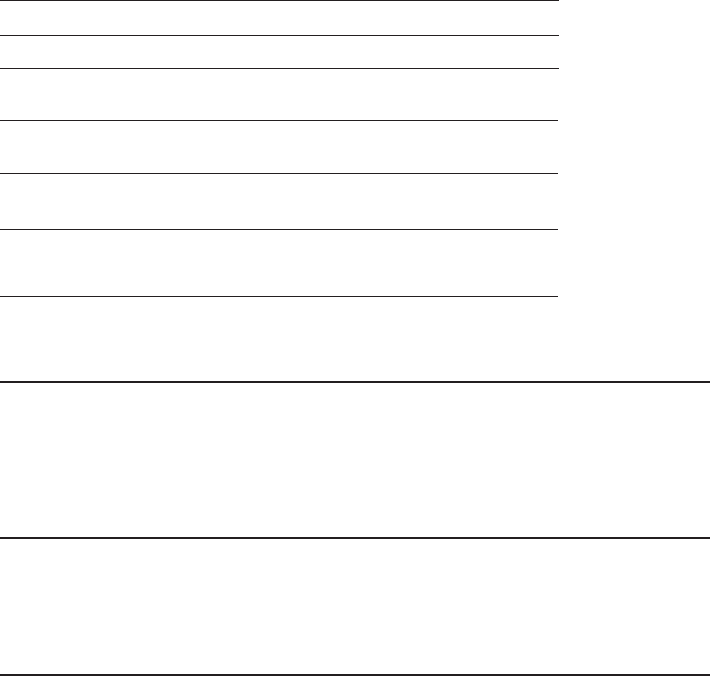
88
Appendix G
Technical specifications
DECT 6.0 digital technology
The AT&T DECT 6.0 products offer unsurpassed range performance and sound clarity. This is
achieved through a unique antenna design and advances in noise-filtering technology. An
independent laboratory has confirmed that AT&T DECT 6.0 products perform up to 45% better
in range competitions. Now calls can be taken in the basement, backyard and garage with
exceptional sound quality.
Telephone operating range
This cordless telephone operates within the maximum power allowed by the Federal
Communications Commission (FCC). Even so, this handset and telephone base can communicate
over only a certain distance — which can vary with the locations of the telephone base and
handset, the weather, and the construction of your home or office.
Redefining long range coverage and clarity
This telephone base comes with two antennas which give much better clarity and cover a longer
range than before.
1921.536 MHz — 1928.448 MHz
5
32°F — 122°F
0°C — 50°C
100 — 240 Vrms
8VDC @1000mA
RF frequency band
Channels
Operating temperature
Telephone base voltage
(AC voltage, 50/60Hz)
Telephone base voltage
(AC adapter output)
Headset jack 2.5mm, 32-150ohm

89
Appendix H
Troubleshooting
If you have difficulty with your phone, please try the suggestions below. For
Customer Service, visit our website at www.telephones.att.com or call
1 (800) 222-3111. In Canada, dial 1 (866) 288-4268.
My telephone
base doesn’t
work at all.
Make sure the power cord is securely plugged in.
Make sure you plug the telephone line cord securely
and firmly into the telephone base and the telephone
wall jack.
Reset the telephone base. Unplug the electrical power.
Wait for approximately 15 seconds, then plug it back
in. Allow up to one minute for the telephone base to
reset.
You may need to purchase four AA alkaline batteries
as backup battery to make the telephone base work in
the event of a power failure. Please refer to Optional
backup battery installation in this user’s manual.
•
•
•
•
I cannot get a
dial tone from the
corded handset.
First try all the suggestions above.
Make sure you plug the handset cord securely and
firmly into the HANDSET jack on the telephone base
and the corded handset.
If the previous suggestions do not work, disconnect
the telephone base from the telephone jack and
connect to a different phone. If there is no dial tone
on that phone either, the problem is in your wiring
or local service. Contact your local telephone service
provider.
Your line cord might be malfunctioning. Try installing a
new line cord.
•
•
•
•
I cannot dial out. First try all the suggestions above.
Make sure you have a dial tone before dialing. The
corded handset might take a second or two to connect
the telephone base and produce a dial tone. This is
normal. Wait an extra second before dialing.
Eliminate any background noise. Noise from a
television, radio or other appliances might cause the
phone to not dial out properly. If you cannot eliminate
the background noise, first try muting the cordled
handset before dialing, or dialing from another room
by a cordless handset with less background noise.
•
•
•

90
Appendix H
Troubleshooting
If the other phones in your home are having the
same problem, contact your local telephone company
(charges might apply).
•
My telephone
base isn’t
performing
normally.
Make sure you plug the power cord securely into
the telephone base. Plug the power adapter into a
different, working electrical outlet without a wall
switch.
Reset the telephone base. Unplug the electrical power.
Wait for 15 seconds then plug it back in. Allow up to
one minute for the telephone base to reset.
Other electronic products can cause interference to
your telephone base. Try installing your telephone base
as far away from these types of electronic devices
as possible: television sets, VCRs, or other cordless
telephones.
•
•
•
I get noise, static,
or weak signals
even when
I’m near the
telephone base.
If you subscribe to high-speed Internet service (digital
subscriber line - DSL) through your telephone lines, you
must install a DSL filter between the telephone base
and the telephone wall jack. The filter prevents noise
and caller ID problems as a result of DSL interference.
Please contact your DSL service provider for more
information about DSL filters.
You may be able to improve the performance of your
telephone base by installing your new telephone
base as far as possible from any other existing corded
or cordless telephone system that may already be
installed.
Other electronic products can cause interference to
your telephone base. Try installing your telephone
base as far away from the following electronic devices
as possible: television sets, VCRs, or other cordless
telephones.
Do not install this telephone base near a microwave
oven or on the same electrical outlet. You might
experience decreased performance while the
microwave oven is operating.
If you plug your telephone in with a modem or a surge
protector, plug the telephone base (or modem/surge
protector) into a different location. If this does not
solve the problem, re-locate your telephone base
•
•
•
•
•

91
Appendix H
Troubleshooting
or modem farther apart from one another, or use a
different surge protector.
Relocate your phone to a higher location. The phone
might have better reception in a high area.
If the other phones in your home are having the
same problem, contact your local telephone company
(charges may apply).
•
•
I experience poor
sound quality
when using the
speakerphone.
For increased sound quality while using the telephone
speakerphone, place the telephone base on a flat
surface with the dial pad facing up.
Excessive background noise will cause a speakerphone
to fade in and out. Try controlling the background
noise by turning off any audio devices near the
speakerphone. Also, try to avoid interrupting the
person at the other end of the conversation while
they are speaking. If background noise cannot be
controlled, you should stop speakerphone operation
and return to normal corded handset mode.
When using a speakerphone, controlling background
noise in your environment is essential. While you are
listening to your party, press MUTE to temporarily
turn your microphone off. When it is your turn to
speak, remember to press MUTE again to turn the
microphone on.
•
•
•
I hear other calls
while using my
phone.
Disconnect the telephone base from the telephone
jack, and plug in a different telephone. If you still hear
other calls, call your local telephone service provider.
•
My telephone
base does not
ring when I
receive a call.
Make sure that the ringer is not off. Refer to the
section on ringer selection in this user’s manual.
Make sure you plug in the telephone line cord
securely into the telephone base and the telephone
jack. Make sure you plug in the power cord securely.
You may have too many extension phones on
your telephone line to allow all of them to ring
simultaneously. Try unplugging some of the other
phones.
If the other phones in your home are having the same
problem, contact your local telephone service provider
(charges might apply).
•
•
•
•

92
Appendix H
Troubleshooting
Test a working phone at the phone jack. If another
phone has the same problem, contact your local
telephone service provider (charges might apply).
Other electronic products can cause interference with
your telephone base. Try installing your telephone base
as far away as possible from electronic devices such as
television sets, VCRs, or other cordless telephones.
Your line cord might be malfunctioning. Try installing a
new line cord.
•
•
•
My calls cut in
and out while I’m
using my corded
handset.
Other electronic products can cause interference with
your telephone base. Try installing your telephone
base as far away from the following electronic devices
as possible: television sets, VCRs, or other cordless
telephones.
Do not install this telephone base near a microwave
oven or on the same electrical outlet. You might
experience decreased performance while the
microwave oven is operating.
If you plug your telephone base in with a modem or
surge protector, plug the telephone base (or modem/
surge protector) into a different location. If this does
not solve the problem, re-locate your telephone base
or modem farther apart from one another, or use a
different surge protector.
Relocate your telephone base to a higher location.
The telephone base might have better reception when
installed in a high area.
If the other phones in your home are having the same
problem, contact your local telephone service provider
(charges may apply).
Excessive background noise will cause a speakerphone
to fade in and out. Try controlling the background
noise by turning off any audio devices near the
speakerphone. Also, try to avoid interrupting the
person at the other end of the conversation while they
are speaking. If background noise cannot be controlled,
you should stop speakerphone operation and return to
normal handset mode.
When using a telephone base speakerphone,
controlling background noise in your environment is
essential. While you are listening to your party, press
•
•
•
•
•
•
•

93
Appendix H
Troubleshooting
MUTE to temporarily turn your microphone off. When
it is your turn to speak, remember to press MUTE
again to turn the microphone on.
My caller ID isn’t
working.
Caller ID is a subscription service. You must subscribe
to this service from your local telephone service
provider for this feature to work on your telephone
base.
The caller must be calling from an area that supports
caller ID.
Both you and your caller’s telephone service providers
must use caller ID compatible equipment.
If you subscribe to high-speed Internet service (digital
subscriber line - DSL) through your telephone lines,
you must install a DSL filter between the telephone
base and the telephone wall jack. The filter prevents
noise and caller ID problems resulting from DSL
interference. Please contact your DSL service provider
for more information about DSL filters.
•
•
•
•
System does not
receive caller ID
when on a call.
Make sure you subscribe to caller ID with call waiting
features from your local telephone service provider.
Caller ID features works only if both you and the
caller are in areas offering caller ID service, and if
both telephone companies use compatible equipment.
•
The answering
system is
recording
incomplete
messages.
If a caller leaves a very long message, part of it may
be lost when the system disconnects the call after
four minutes.
If the caller pauses for longer than seven seconds, the
system stops recording and disconnects the call.
If the system’s memory becomes full during a
message, the system stops recording and disconnects
the call.
If the caller’s voice is very soft, the system may stop
recording and disconnects the call.
•
•
•
•

94
Appendix H
Troubleshooting
I have difficulty
hearing
messages.
Press VOL+ to increase the speaker volume on the
telephone base.
•
System does
not answer after
correct number
of rings.
• Make sure that the answering system is on (pages X-
X).
• If toll saver is activated, the number of rings changes
to two when you have new messages stored (page X).
• If the memory is full or the system is off, the system
will answer after 10 rings.
System does
not respond
to remote
commands.
• Make sure to enter your remote access code correctly
(page 61 ).
• Make sure you are calling from a touch-tone phone.
When you dial a number, you should hear tones. If you
hear clicks, the phone is not a touch-tone telephone
and cannot activate the answering system.
• The answering system may not detect the remote
access code while your announcement is playing. Try
waiting until the announcement is over before entering
the code.
• There may be interference on the phone line you are
using. Press dial pad keys firmly.
System does
not record
messages.
• Make sure the answering system is on (pages 19 & 55).
• Make sure the memory of the answering system is not
full. Please refer to the Remaining space section in
the User’s manual.
• If you have voicemail service in addition to your
answering system, your callers’ messages may be
going into voicemail before your answering system
picks up the call. Program your voicemail to pick up
at least two rings greater than the number of rings
your answering system is set to answer the call. See
Answering system on page 55 for more information.

95
Appendix H
Troubleshooting
Outgoing
announcement is
not clear.
• When you record your announcement, make sure you
speak in a normal tone of voice, about nine inches
from the telephone base.
• Make sure there is no background noise (TV, music,
etc.) while recording.
Common cure
for electronic
equipment.
If the telephone base does not seem to be responding
normally, do the following (in the order listed):
Disconnect the power to the telephone base.
Disconnect the spare battery, if applicable.
Wait a few minutes.
Connect power to the telephone base.
Re-install the backup battery.
Wait for re-establishing the connection with the
telephone base. Allow up to one minute for this to
take place.
•
•
•
•
•
•
96
Index
Index

www.telephones.att.com
© 2009 Advanced American Telephones. All rights reserved.
AT&T and the AT&T logo are trademarks of AT&T Intellectual Property II, L.P.
d/b/a AT&T Intellectual Property licensed to Advanced American Telephones,
San Antonio, TX 78219. Printed in China. Issue 1 AT&T 02/09.